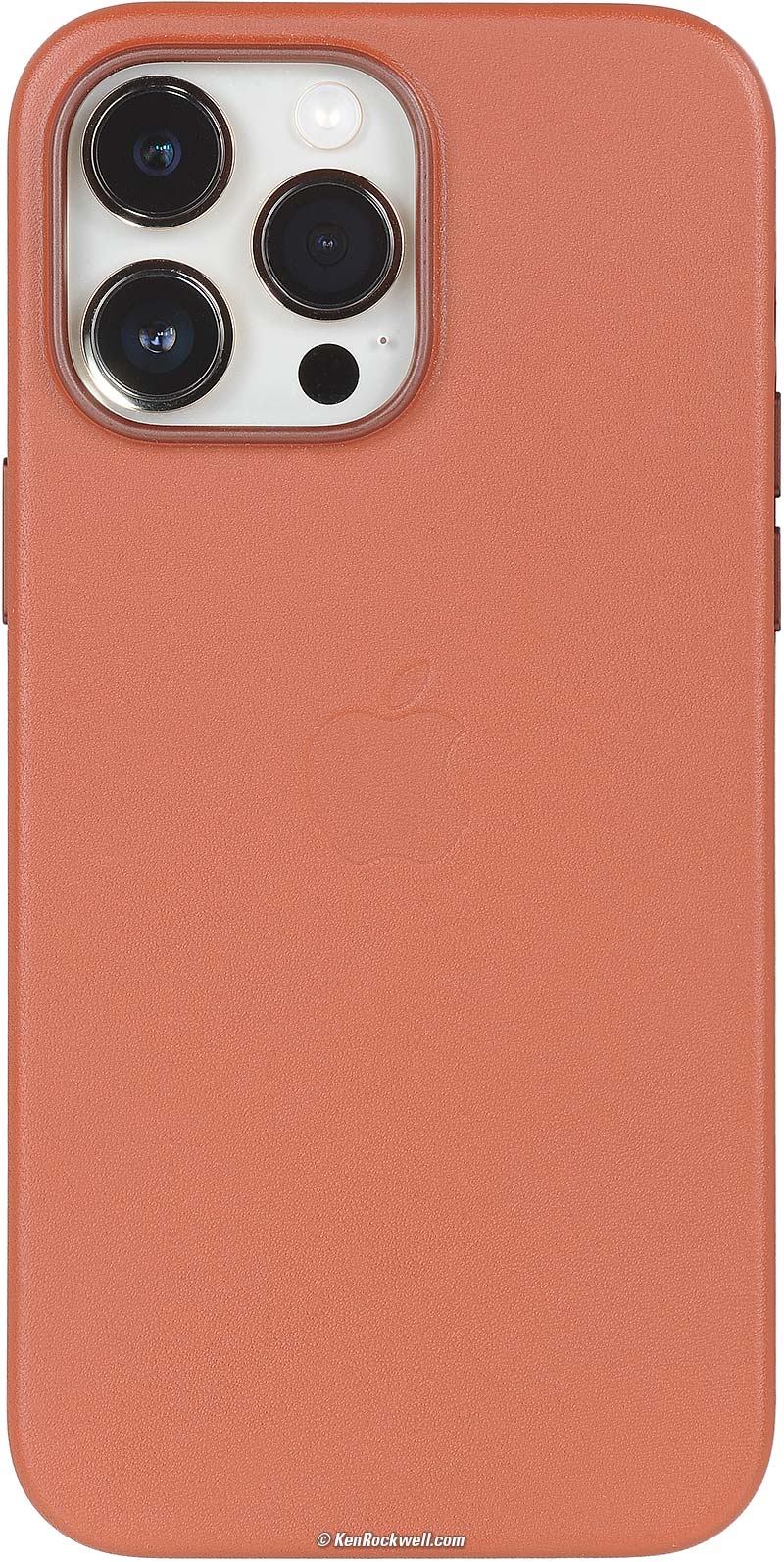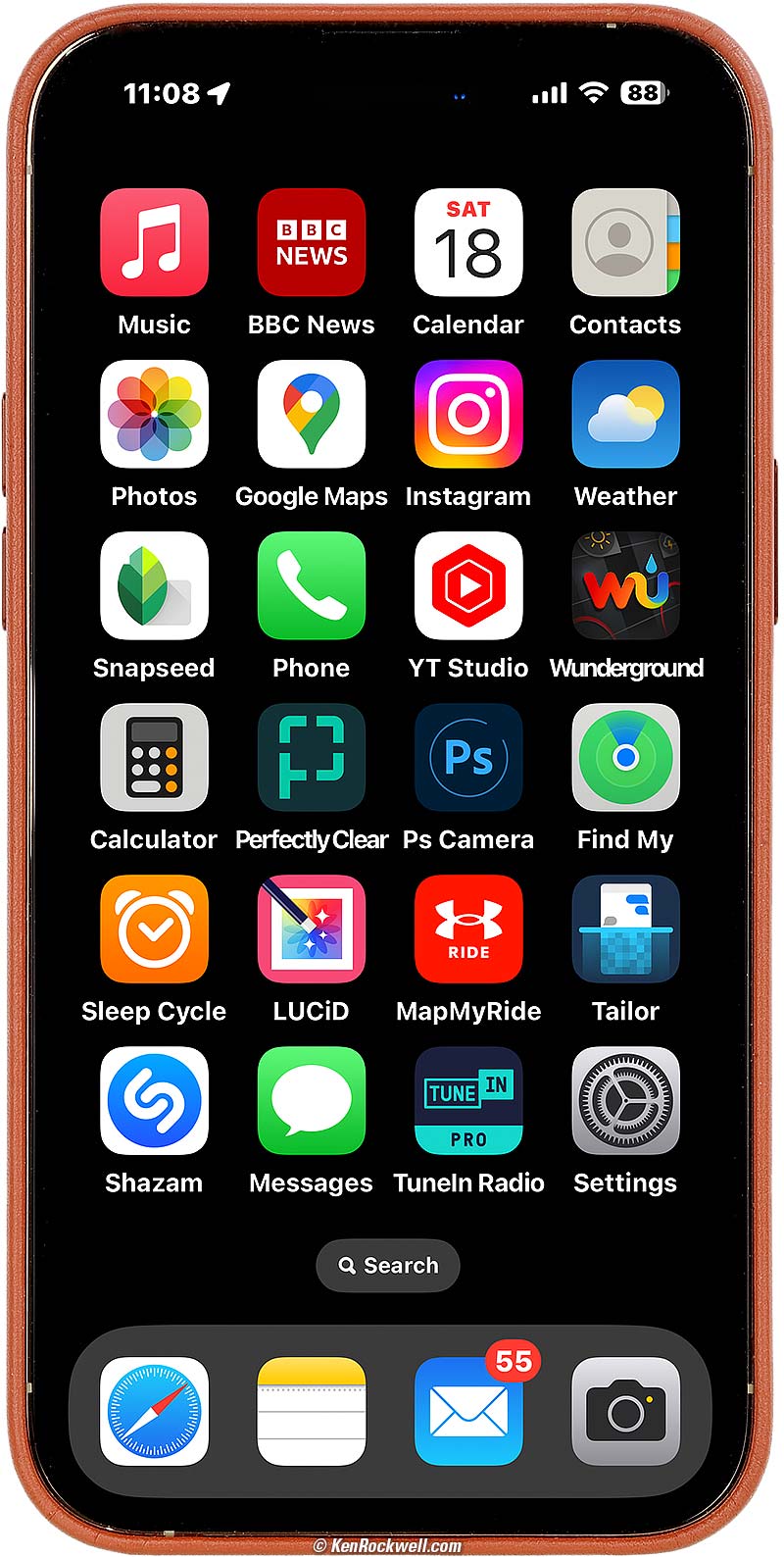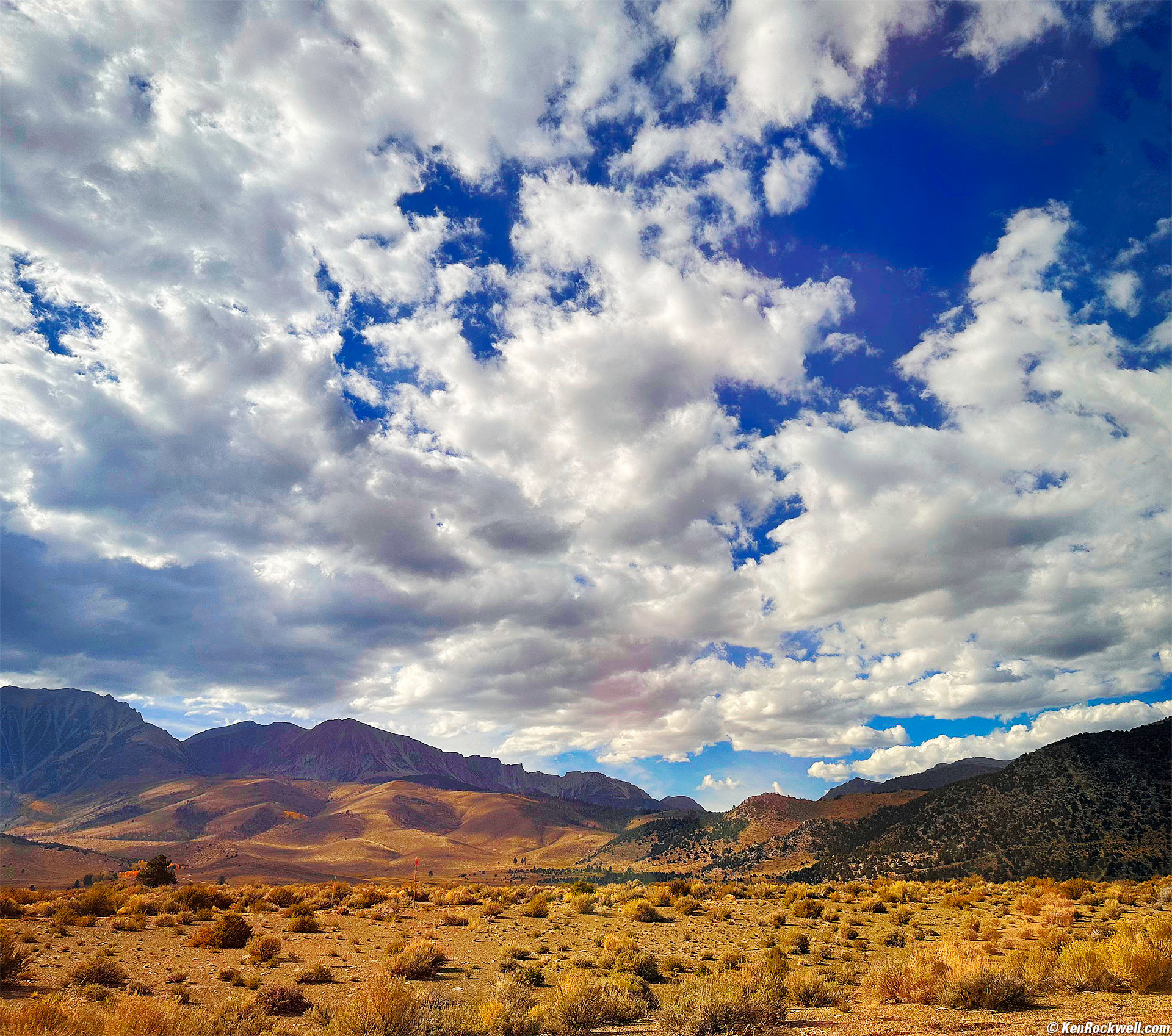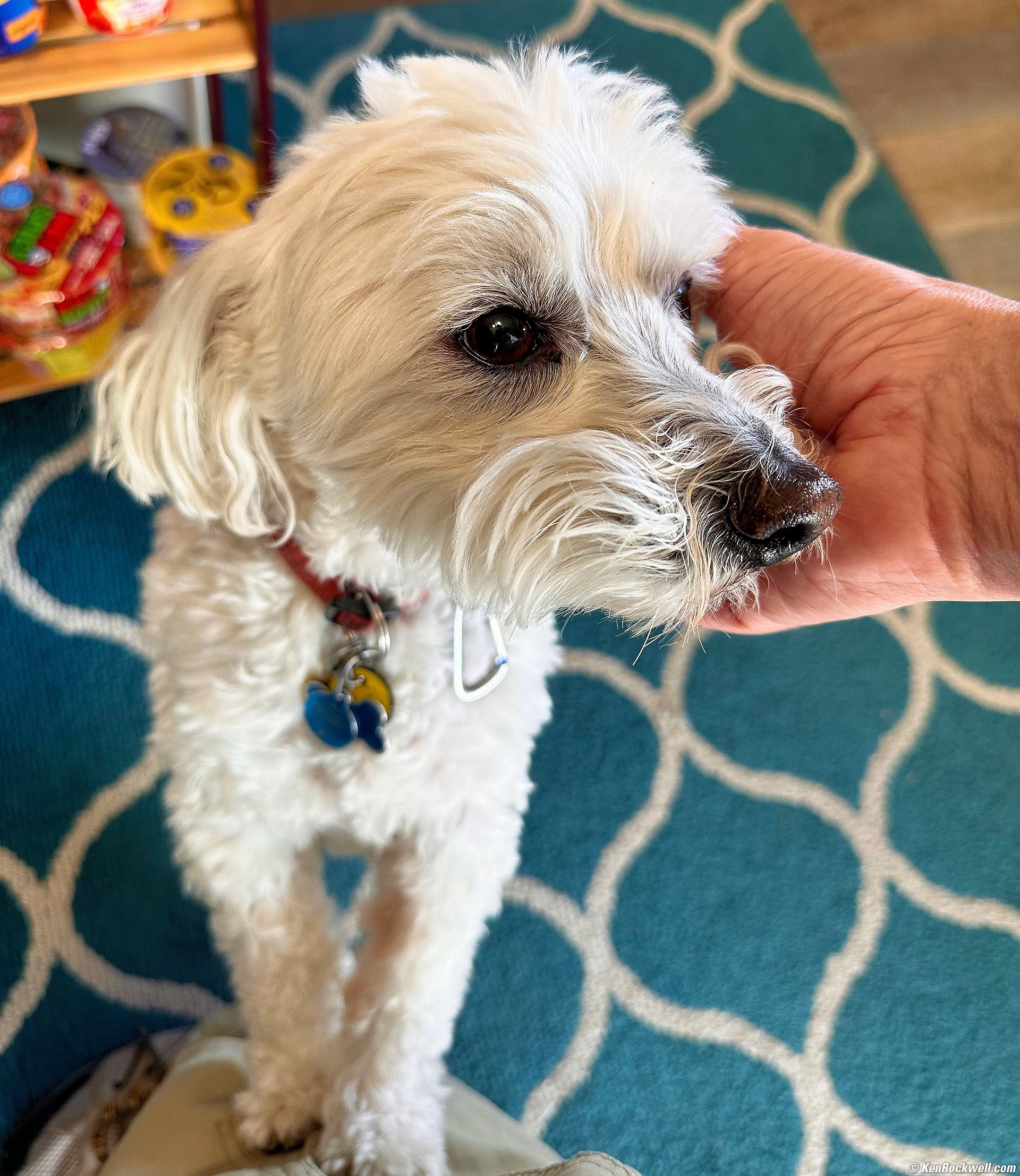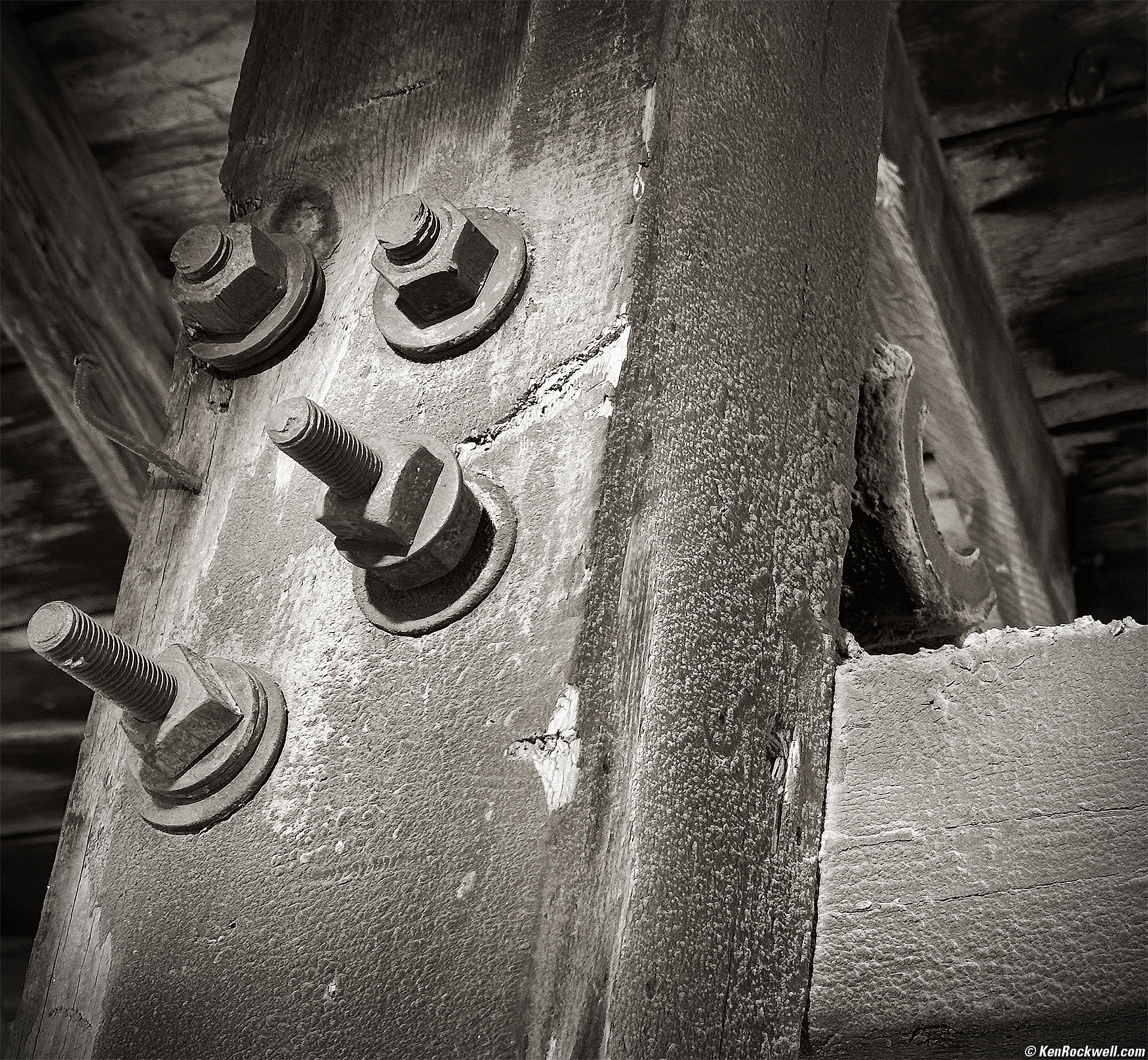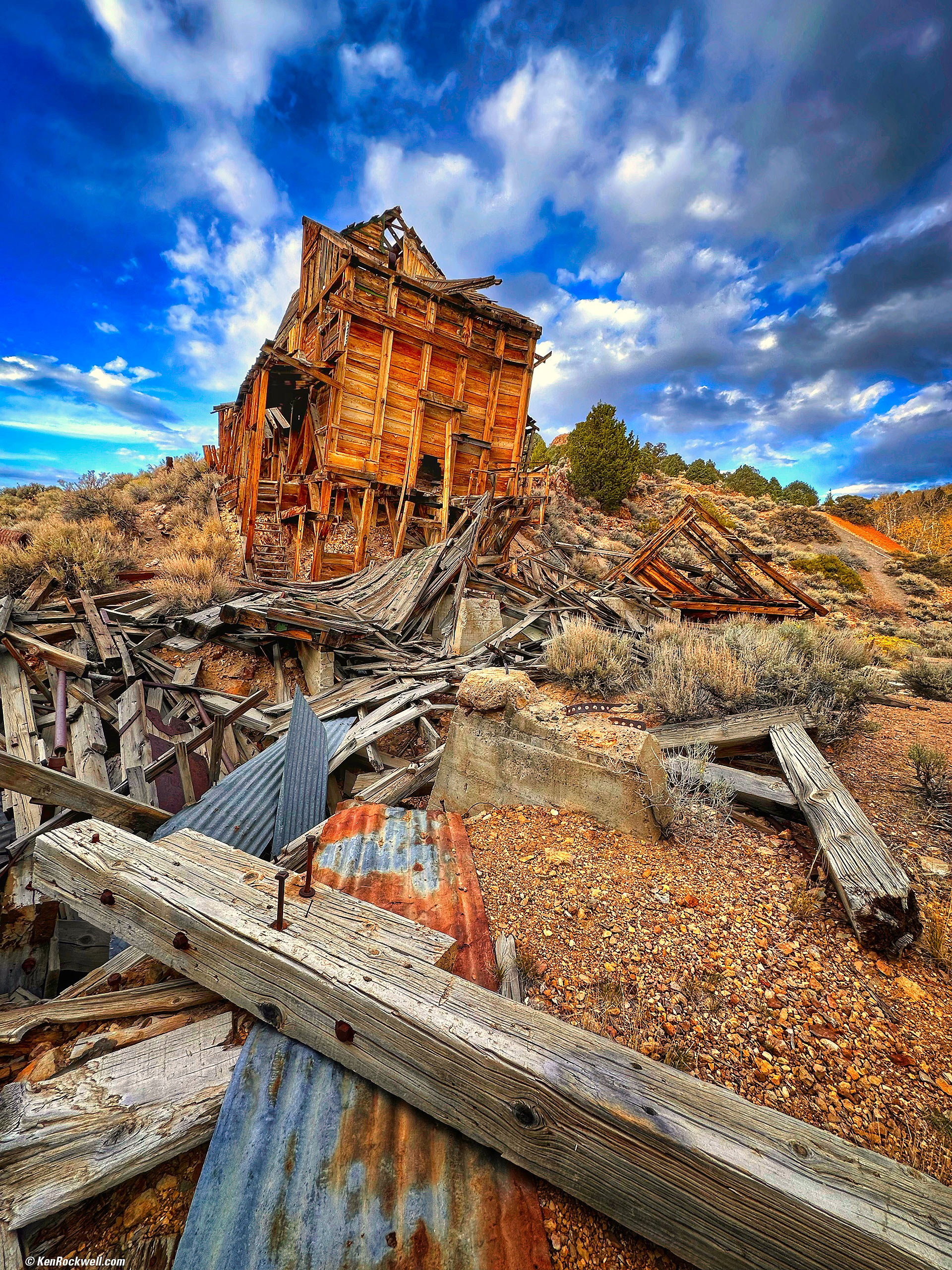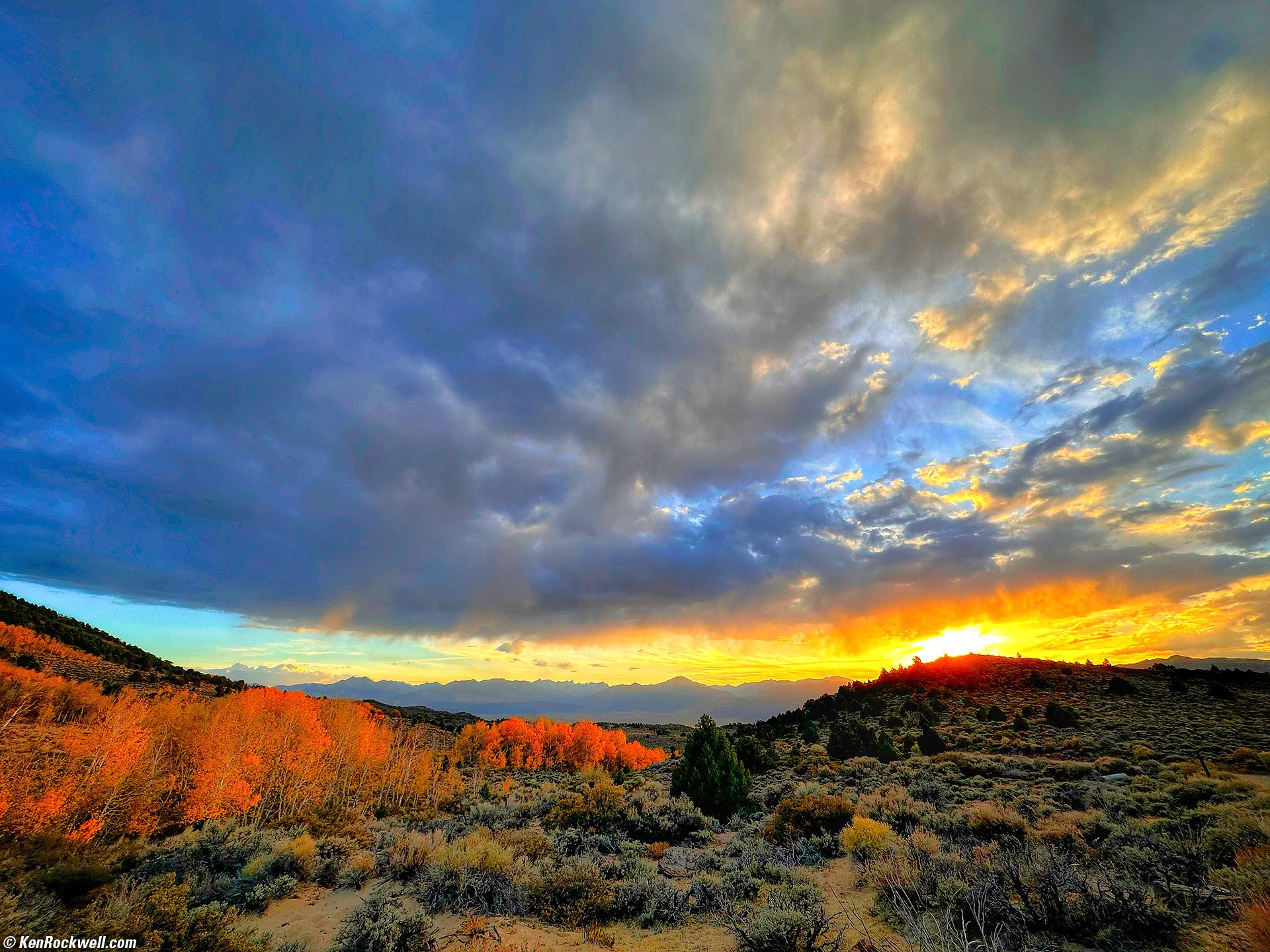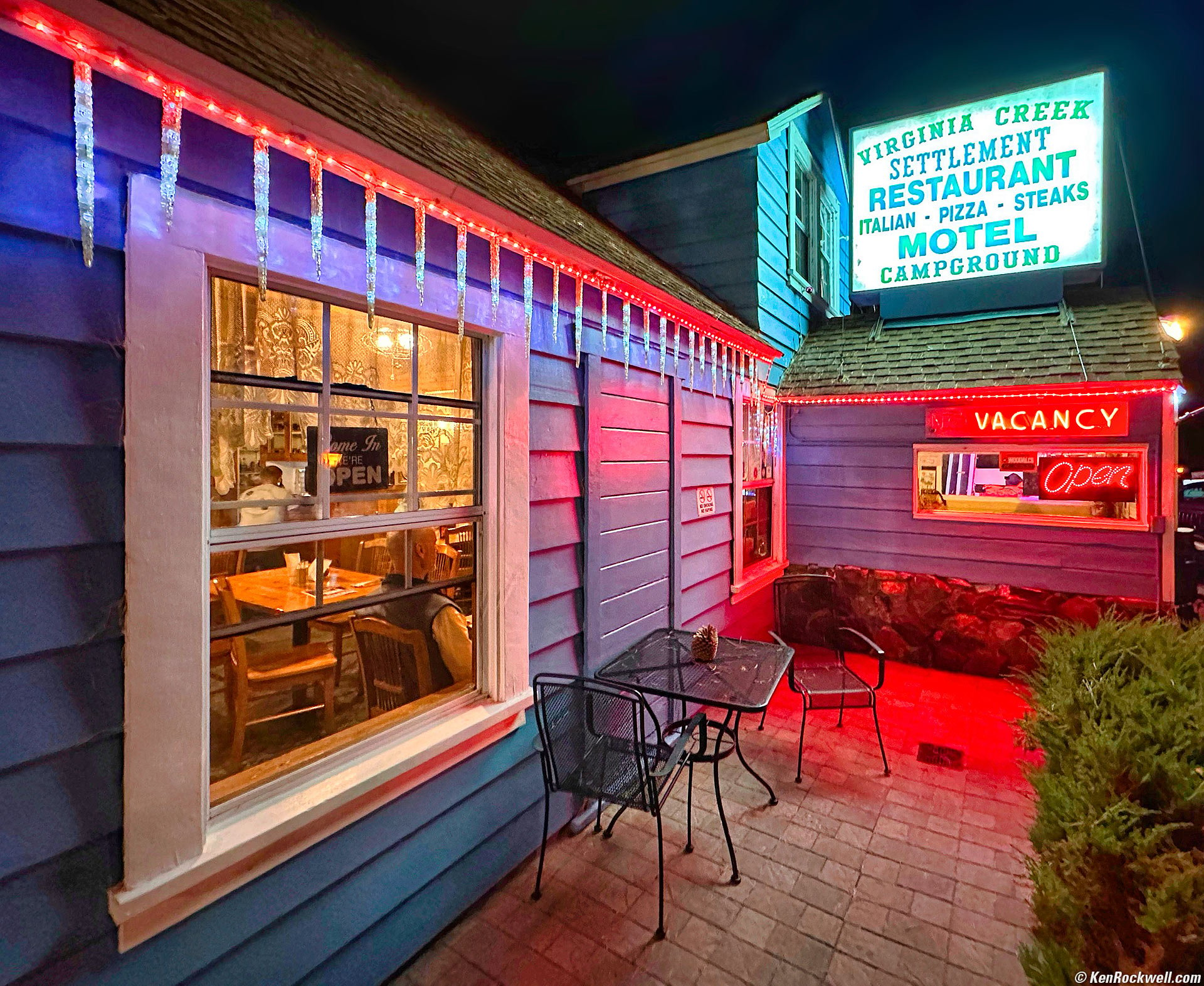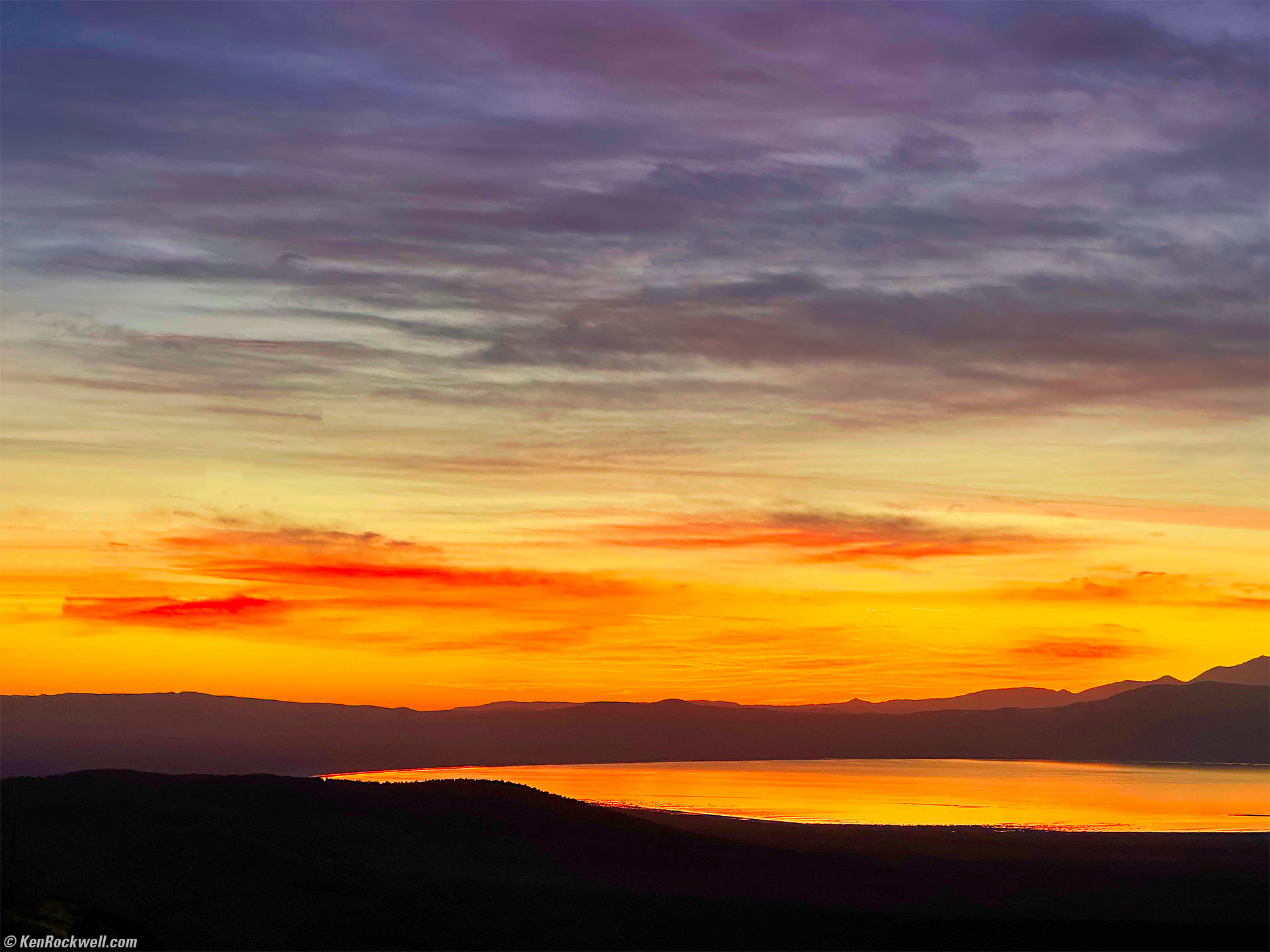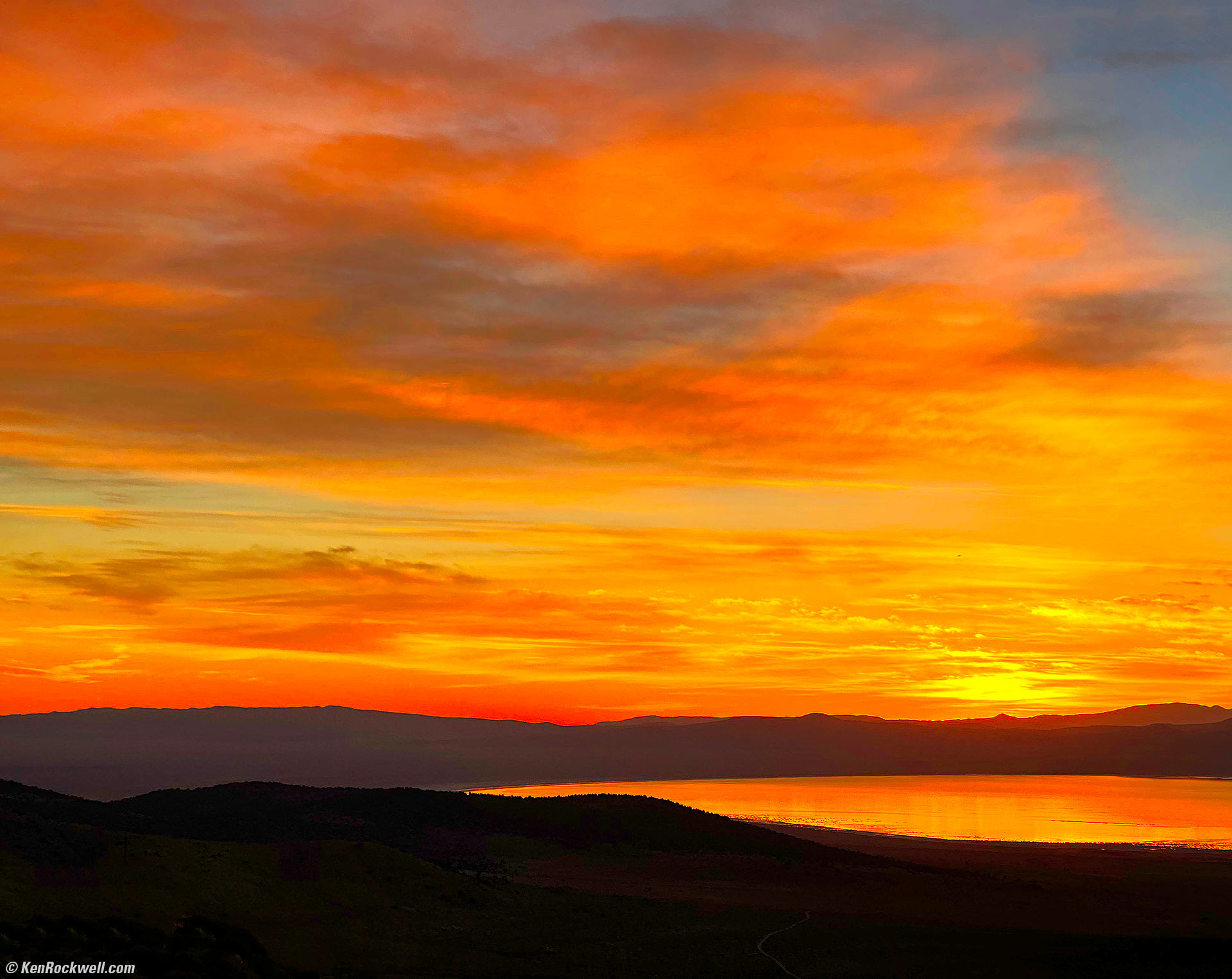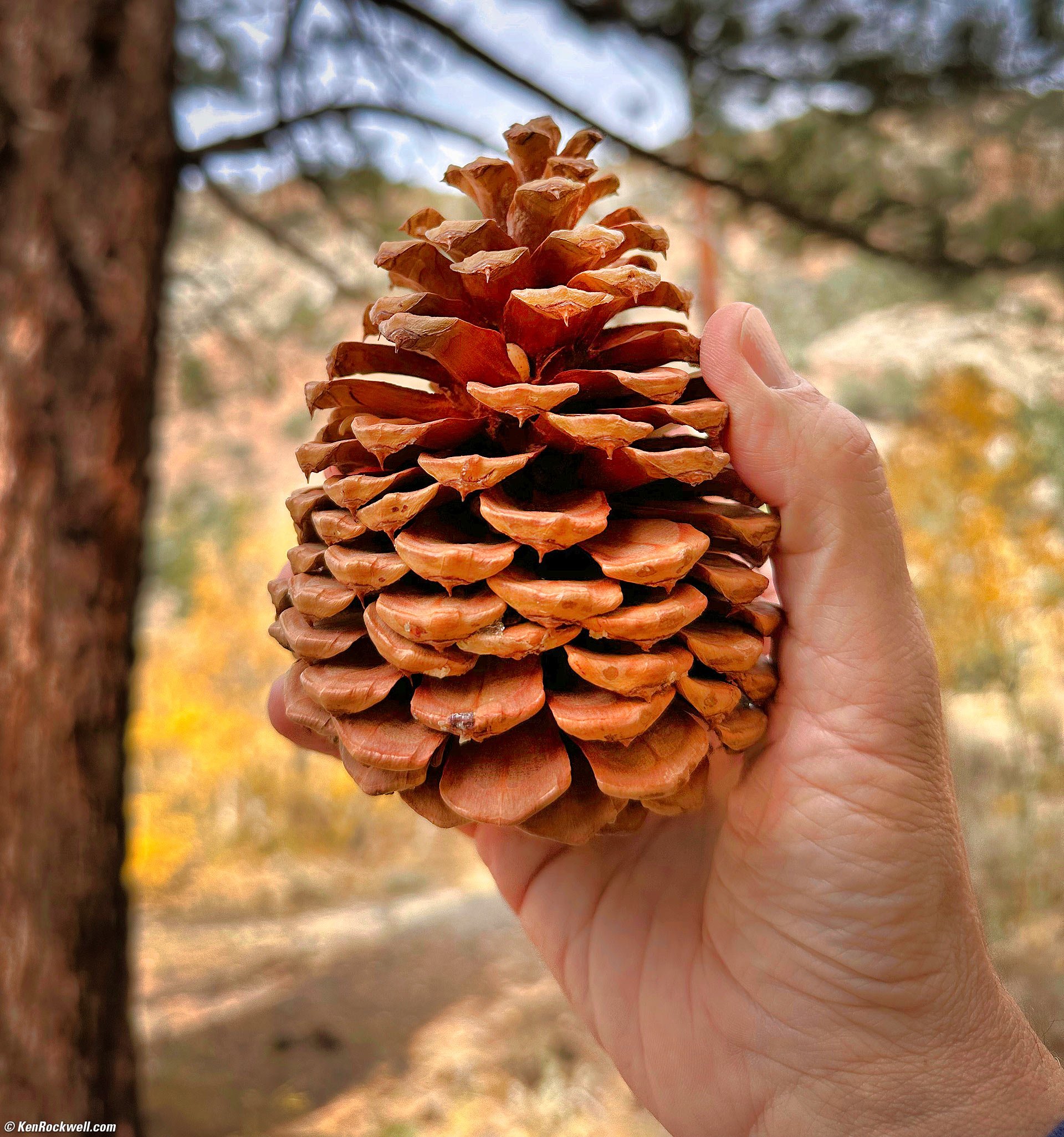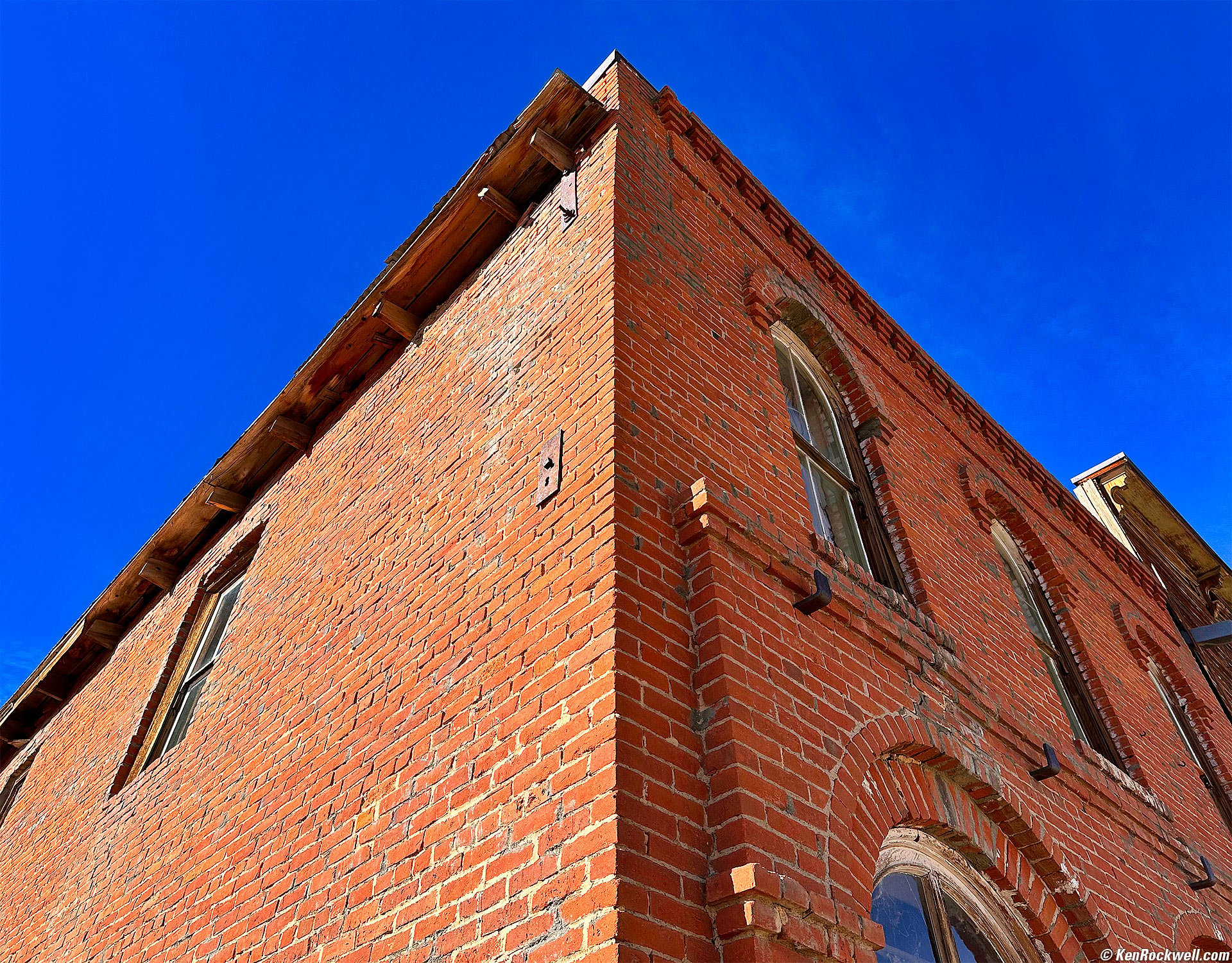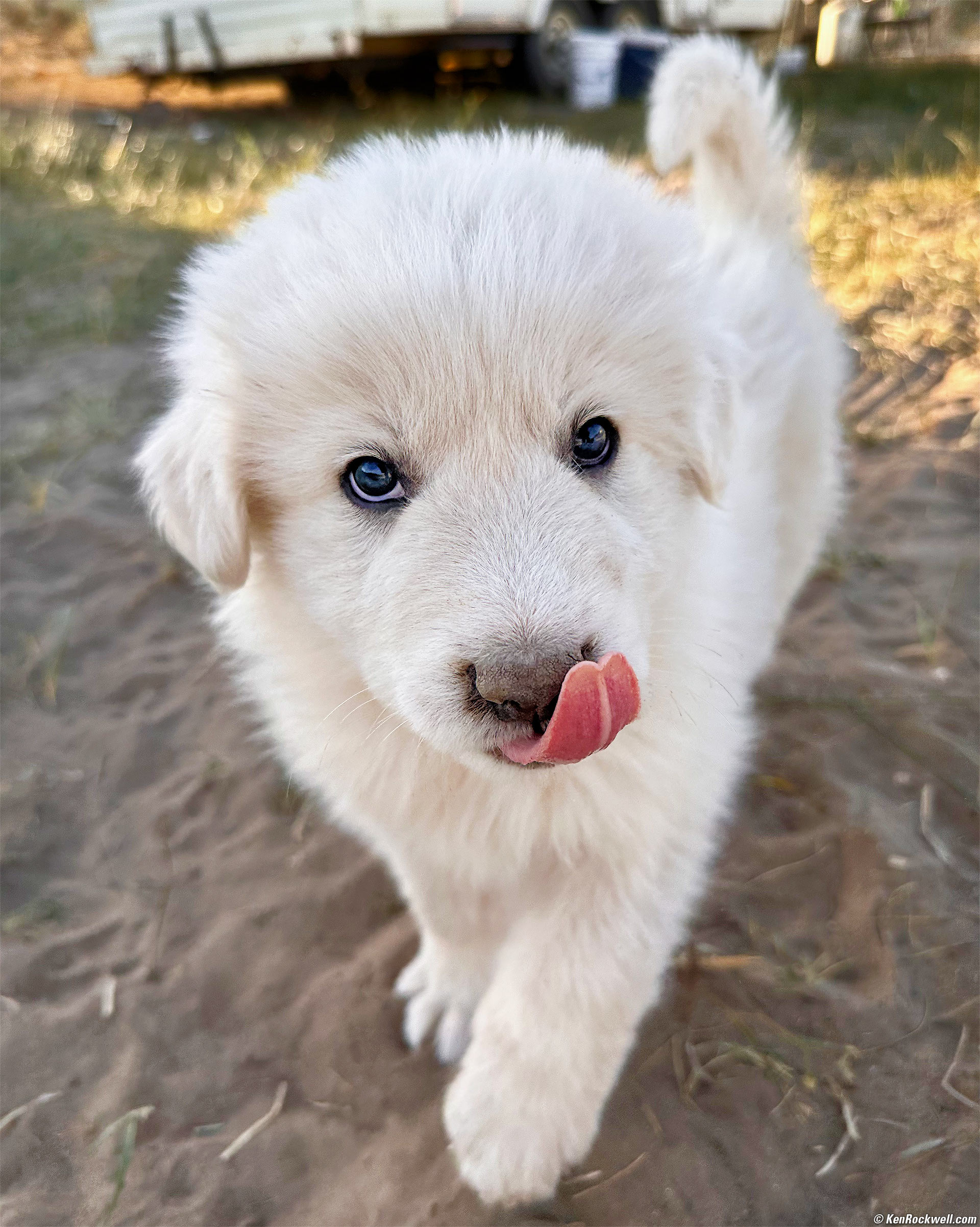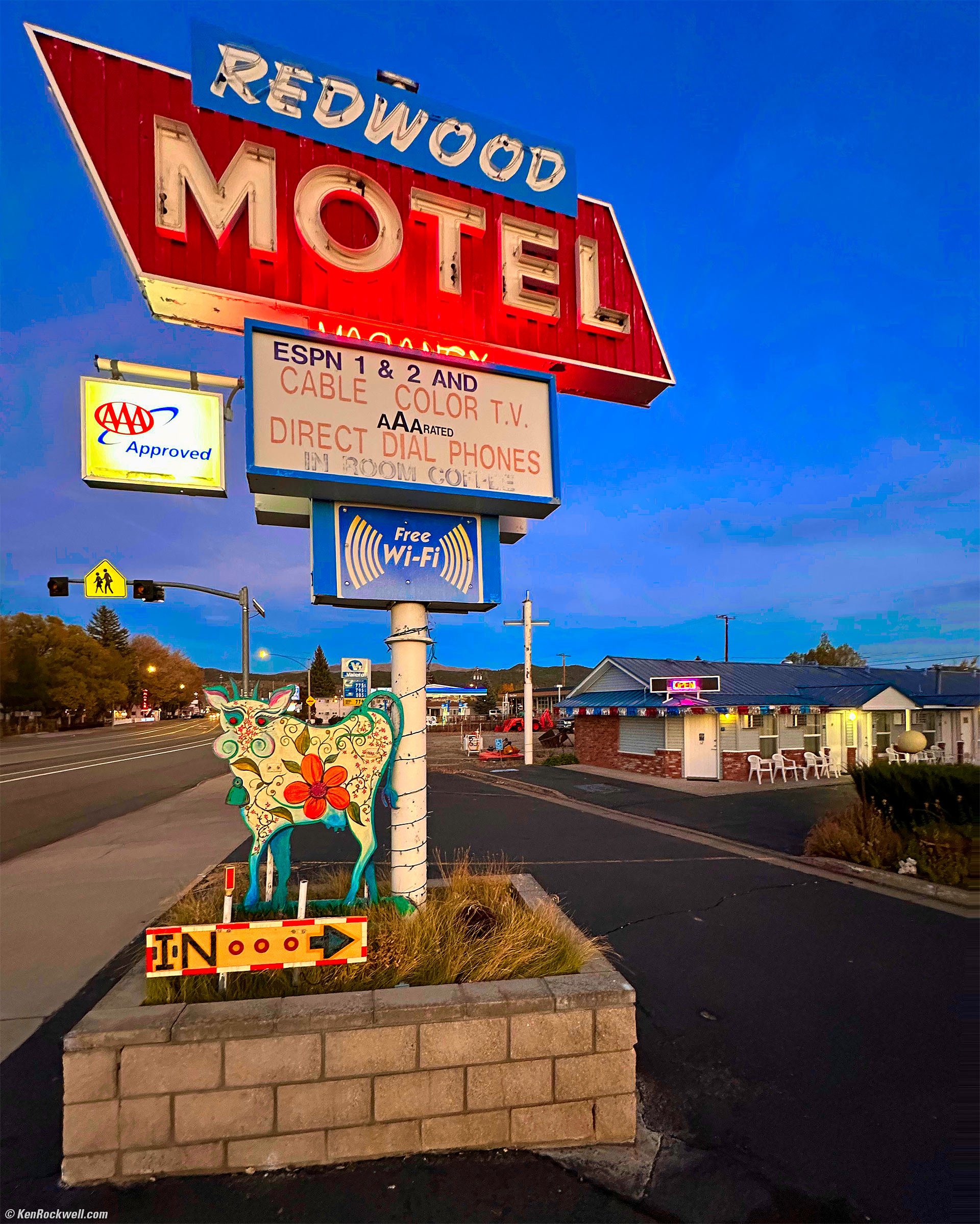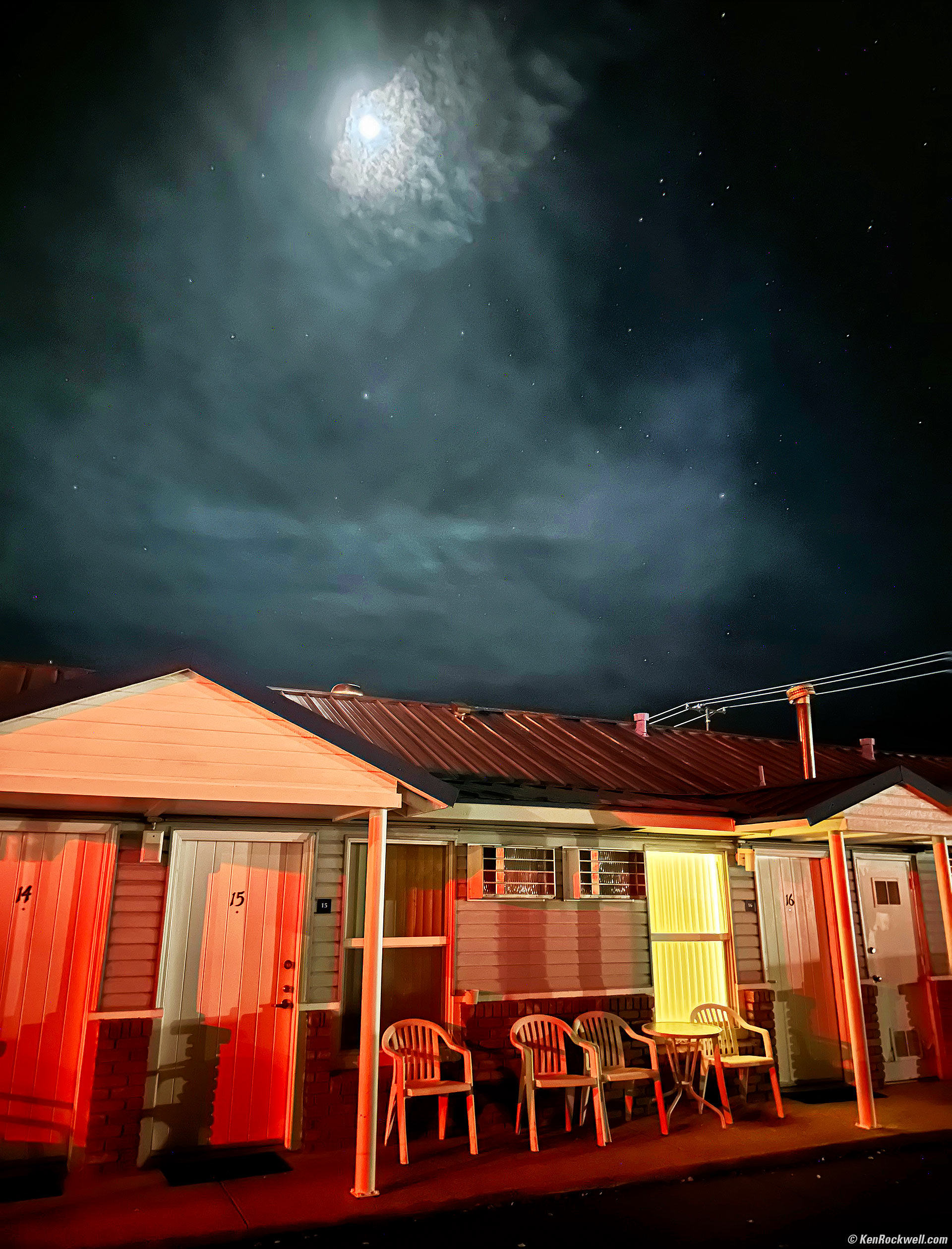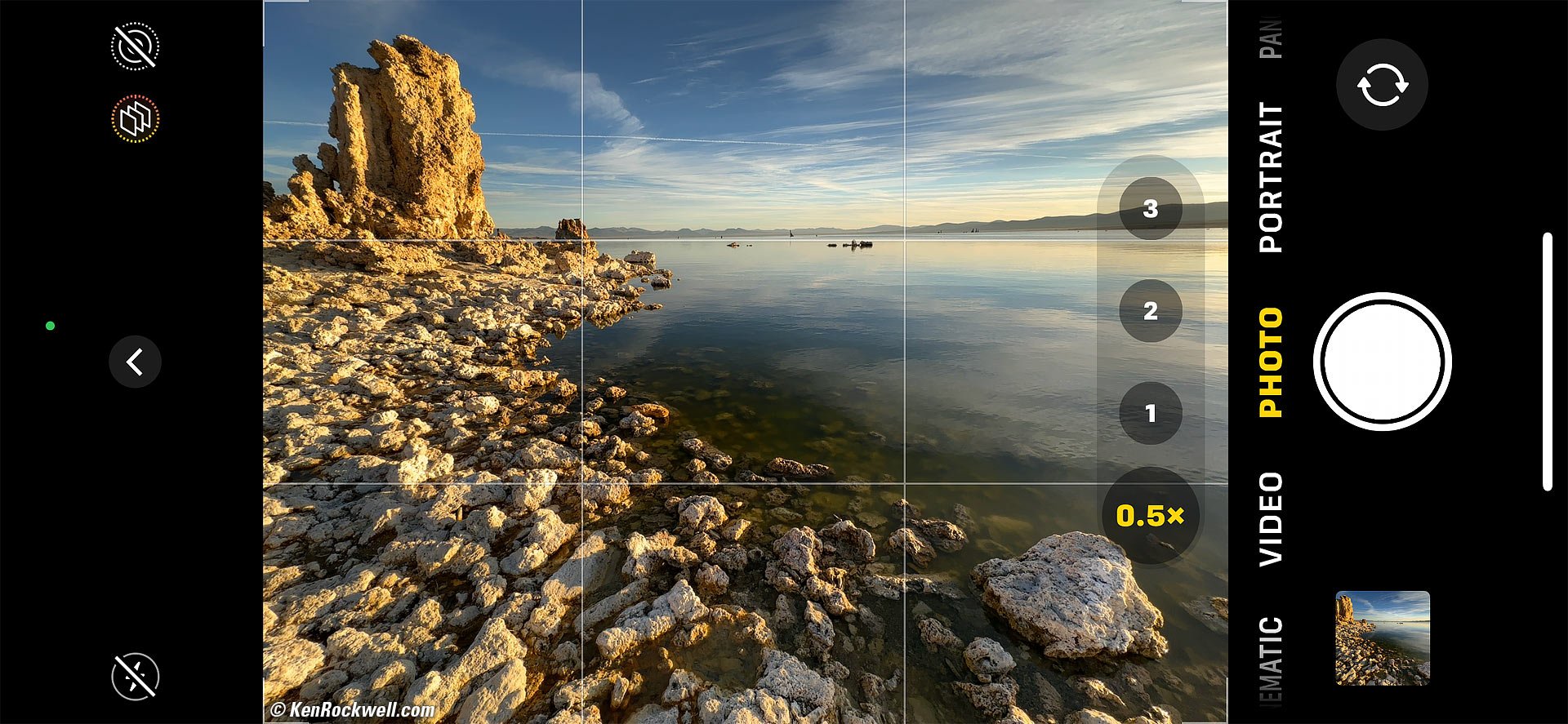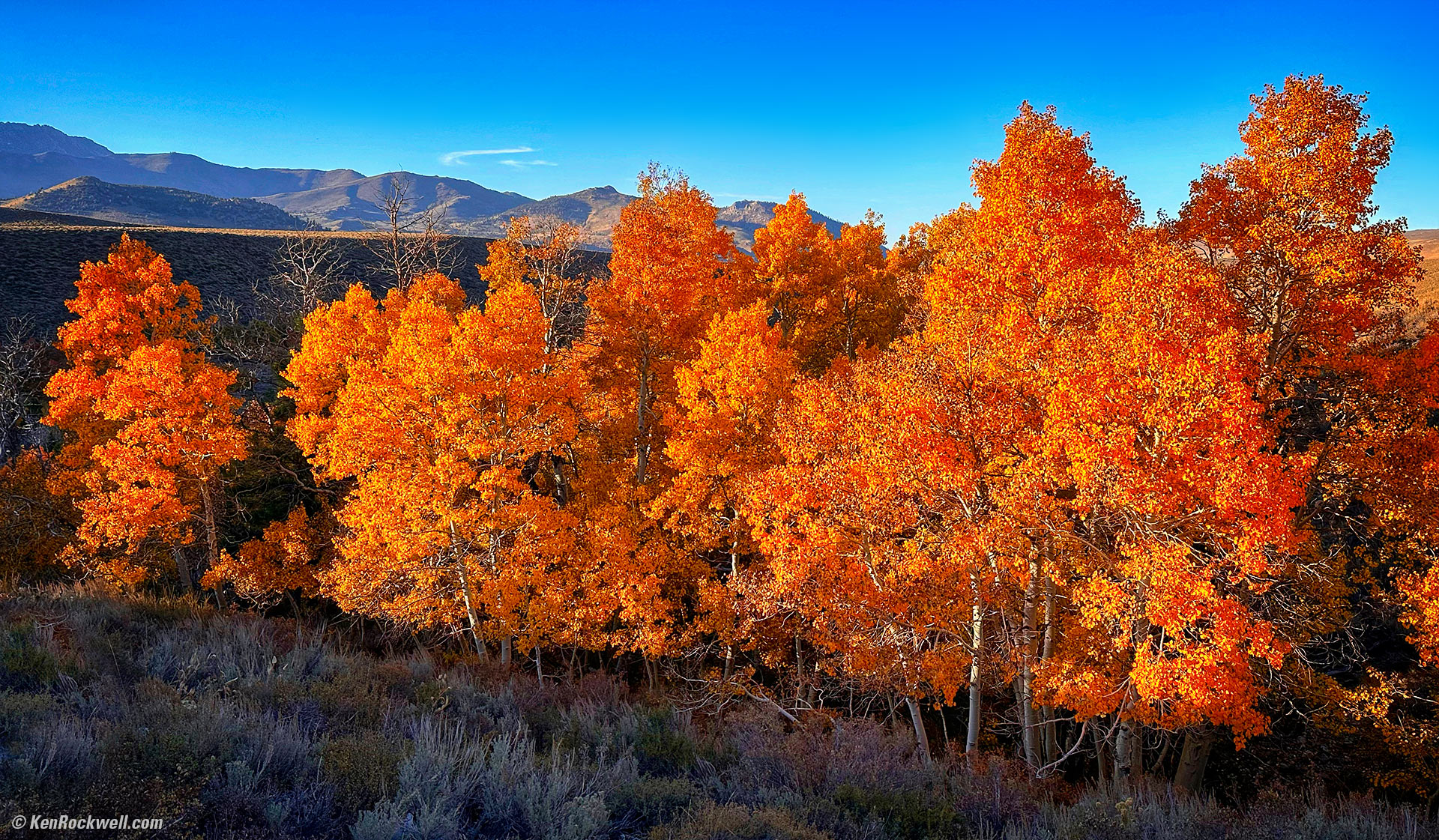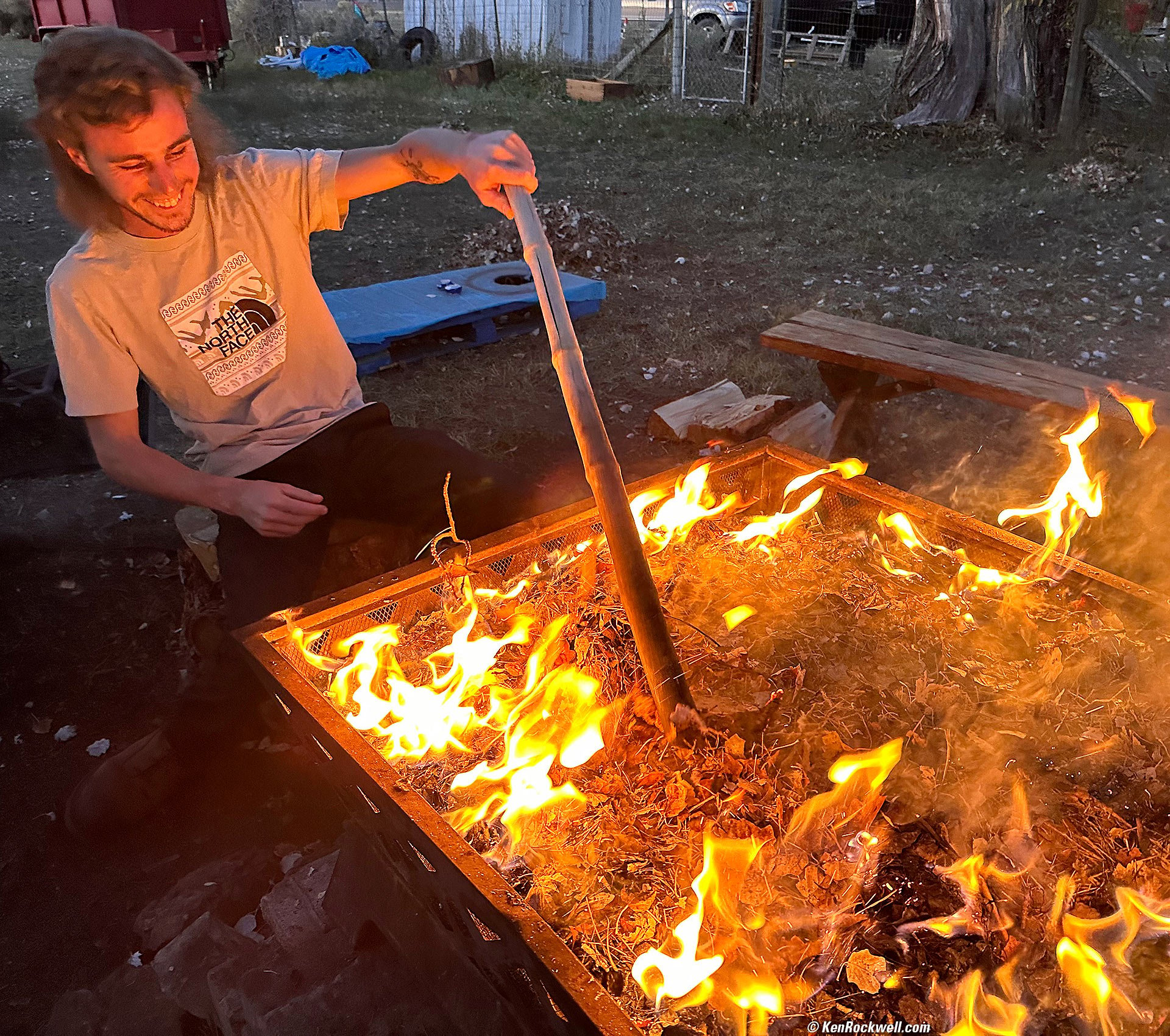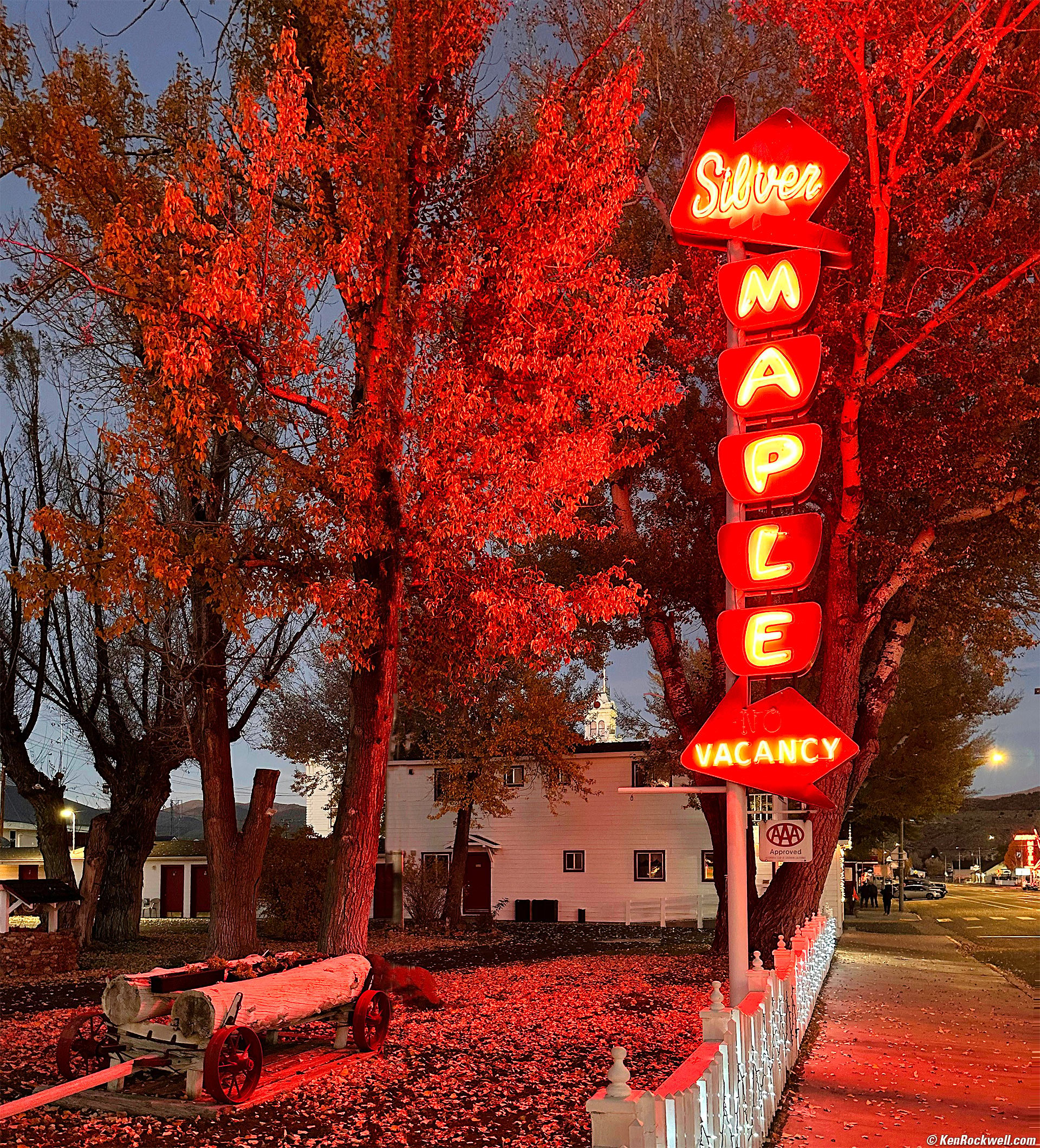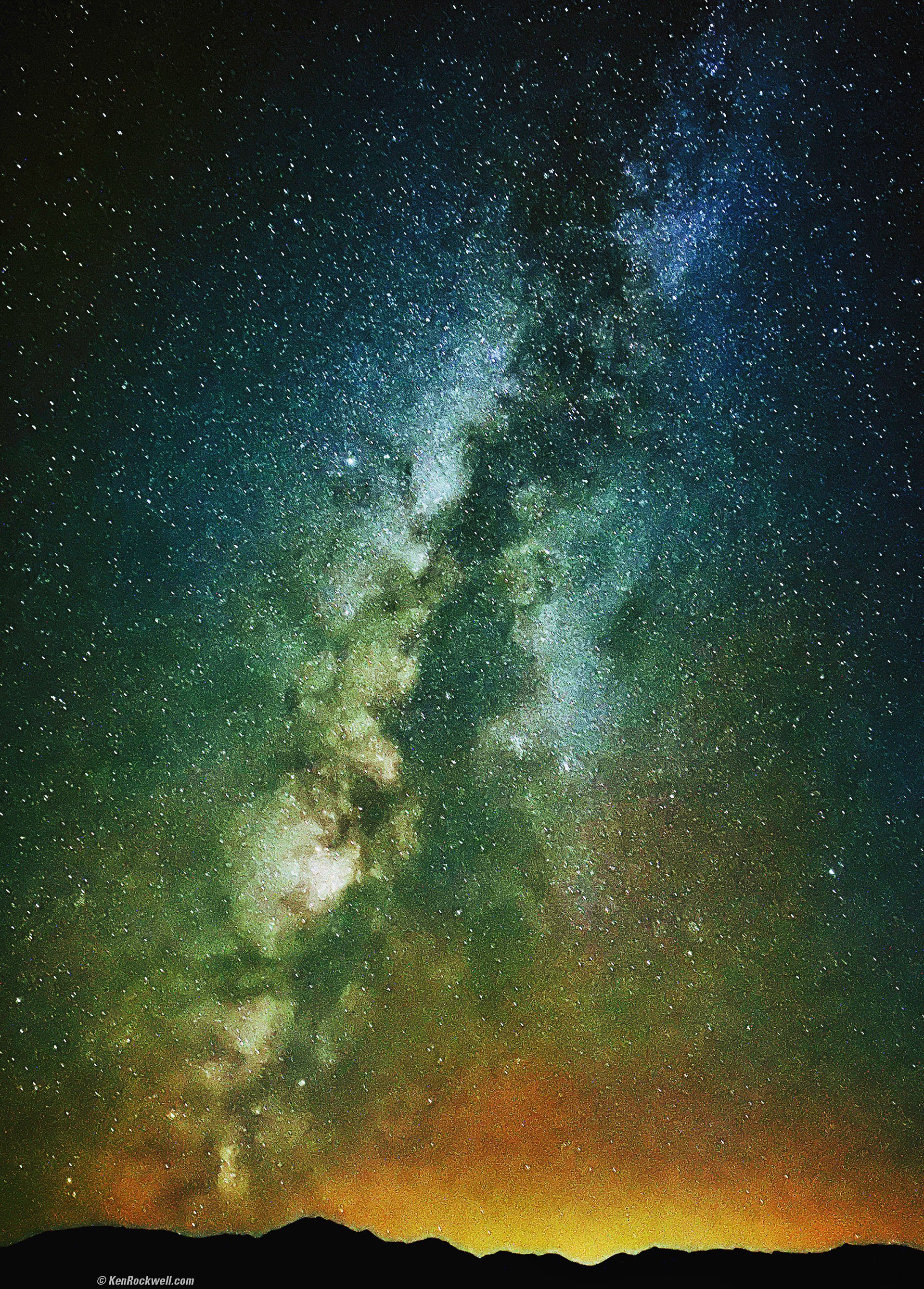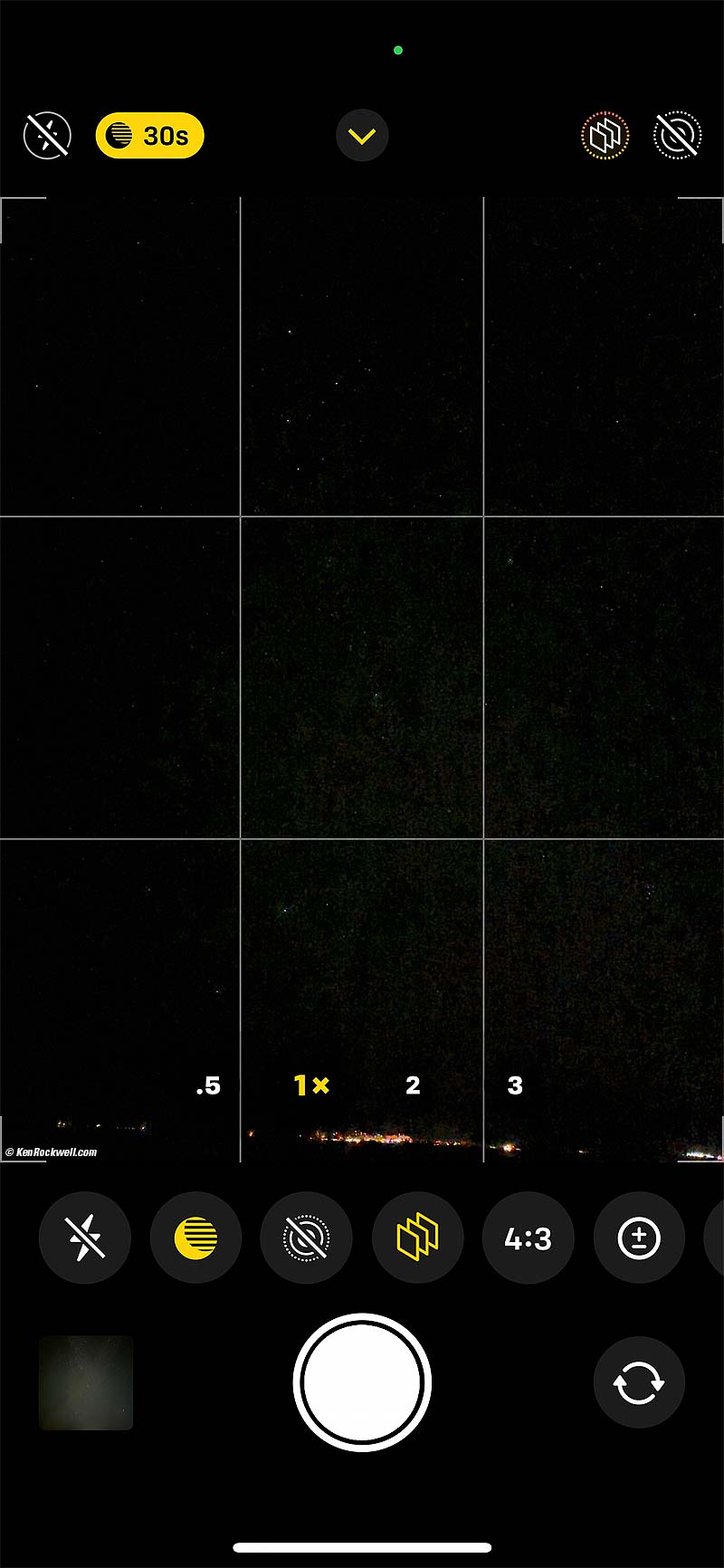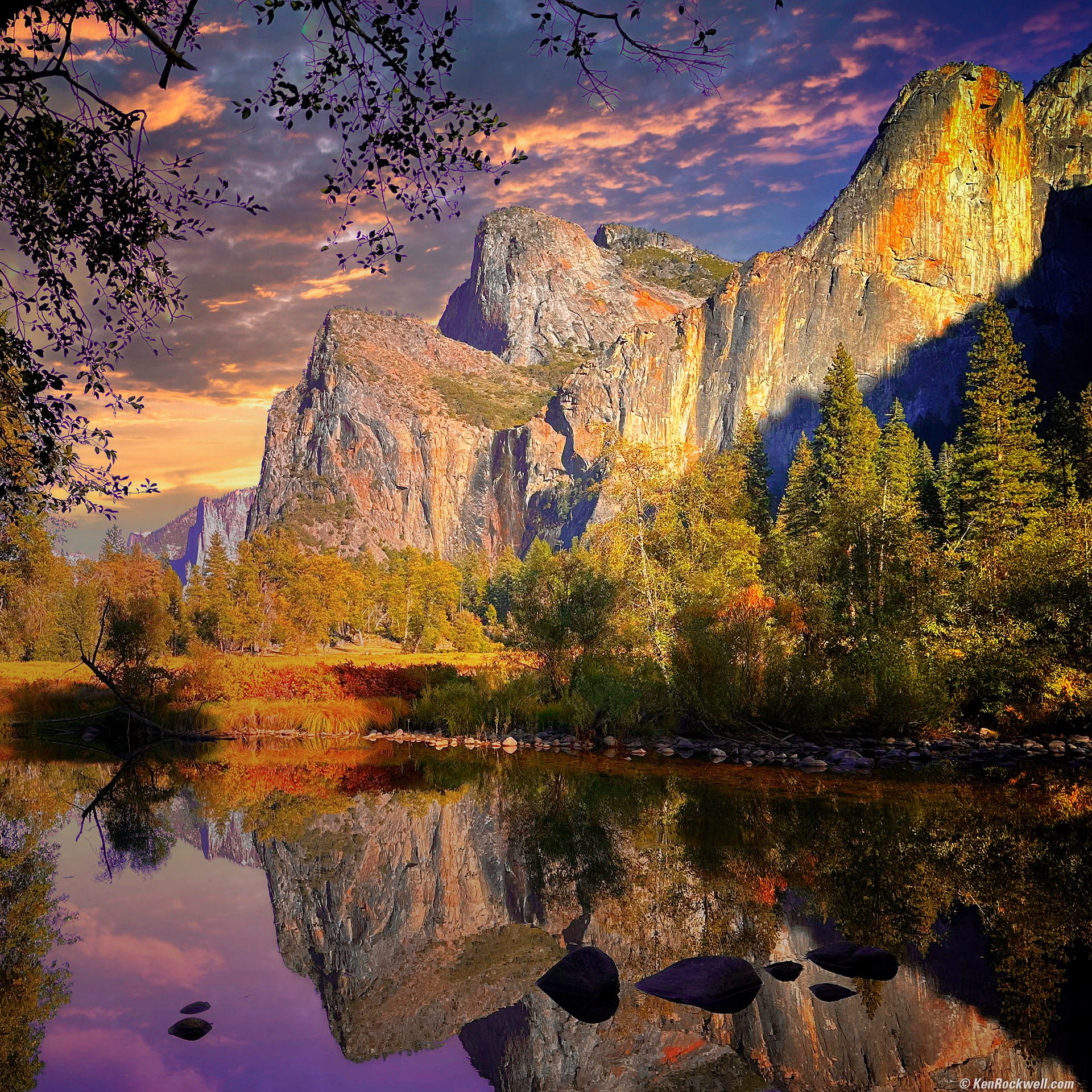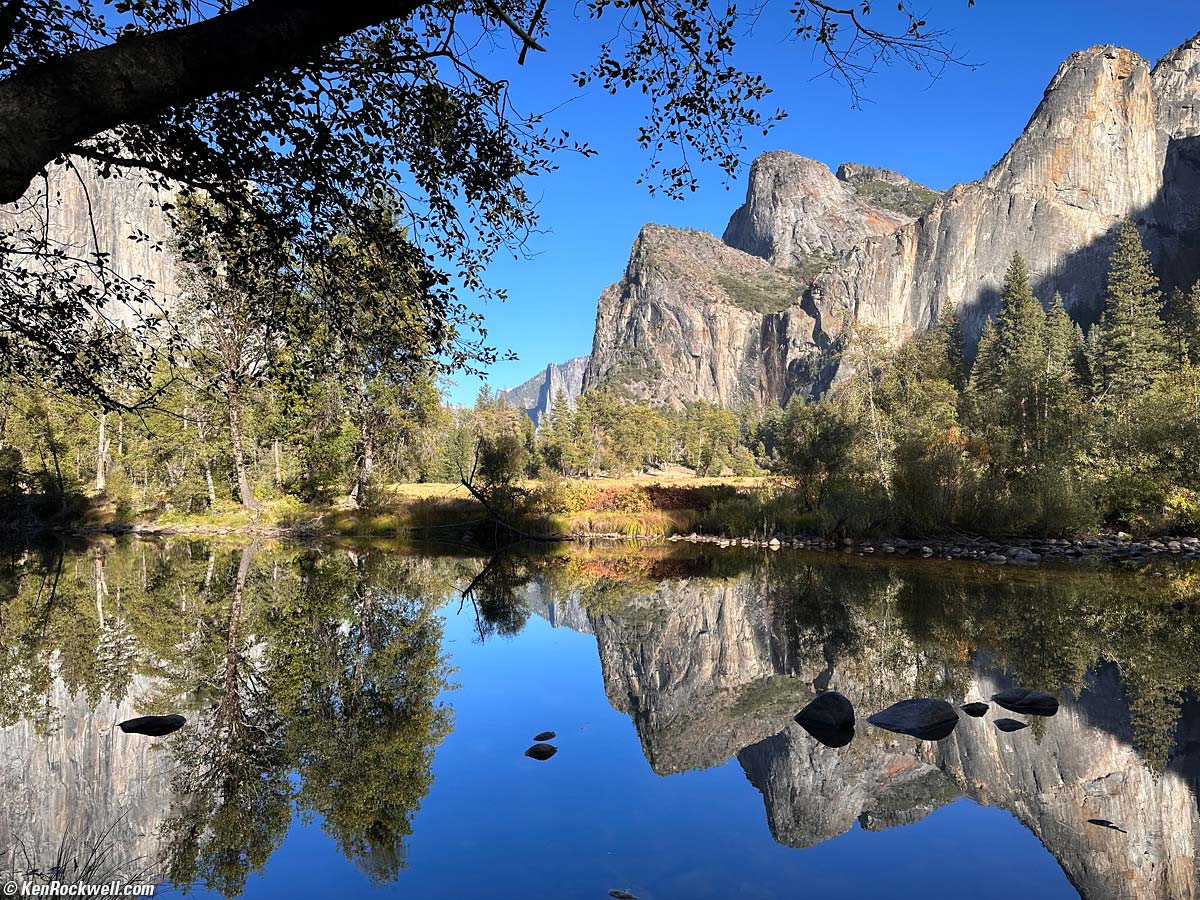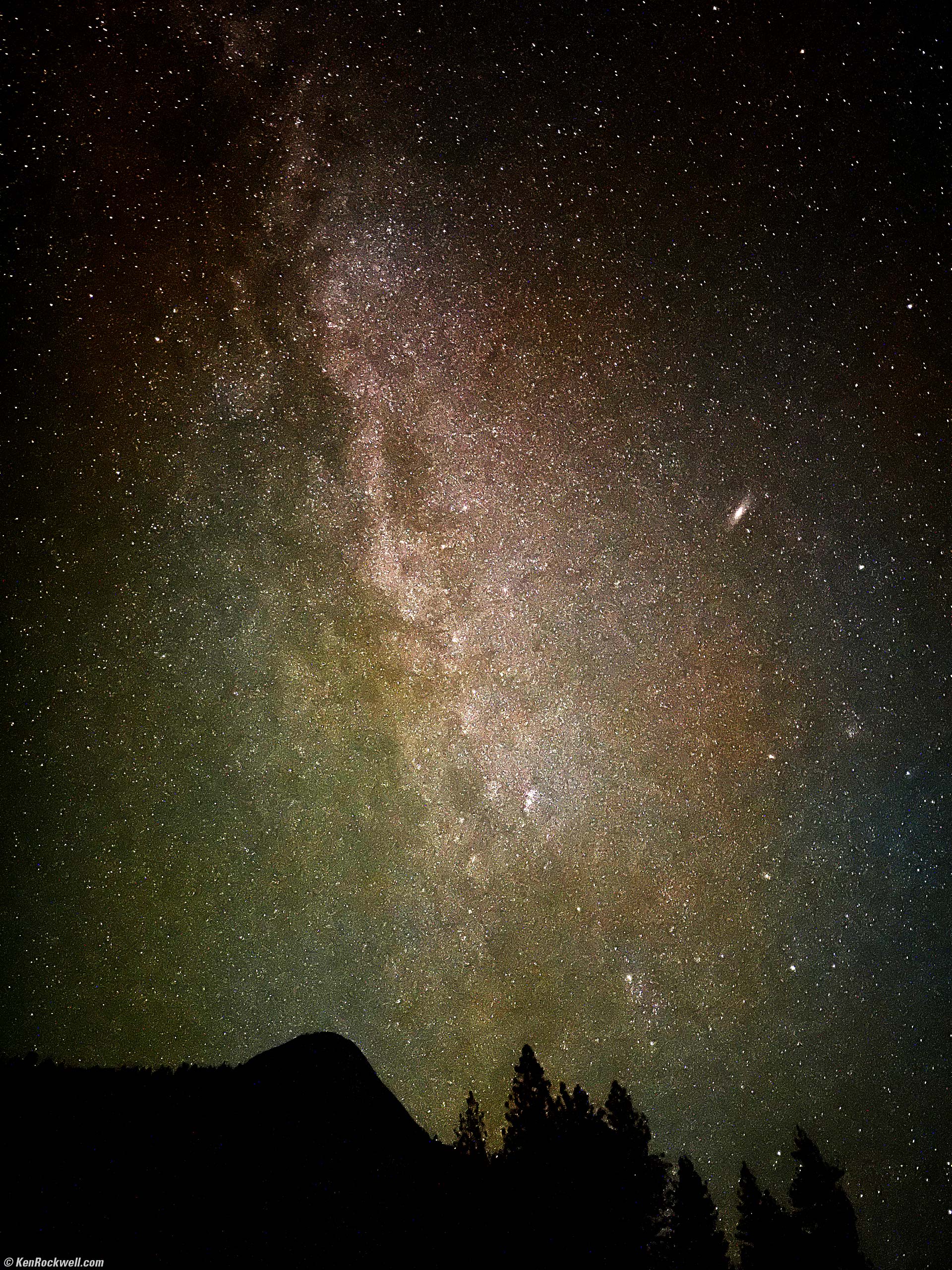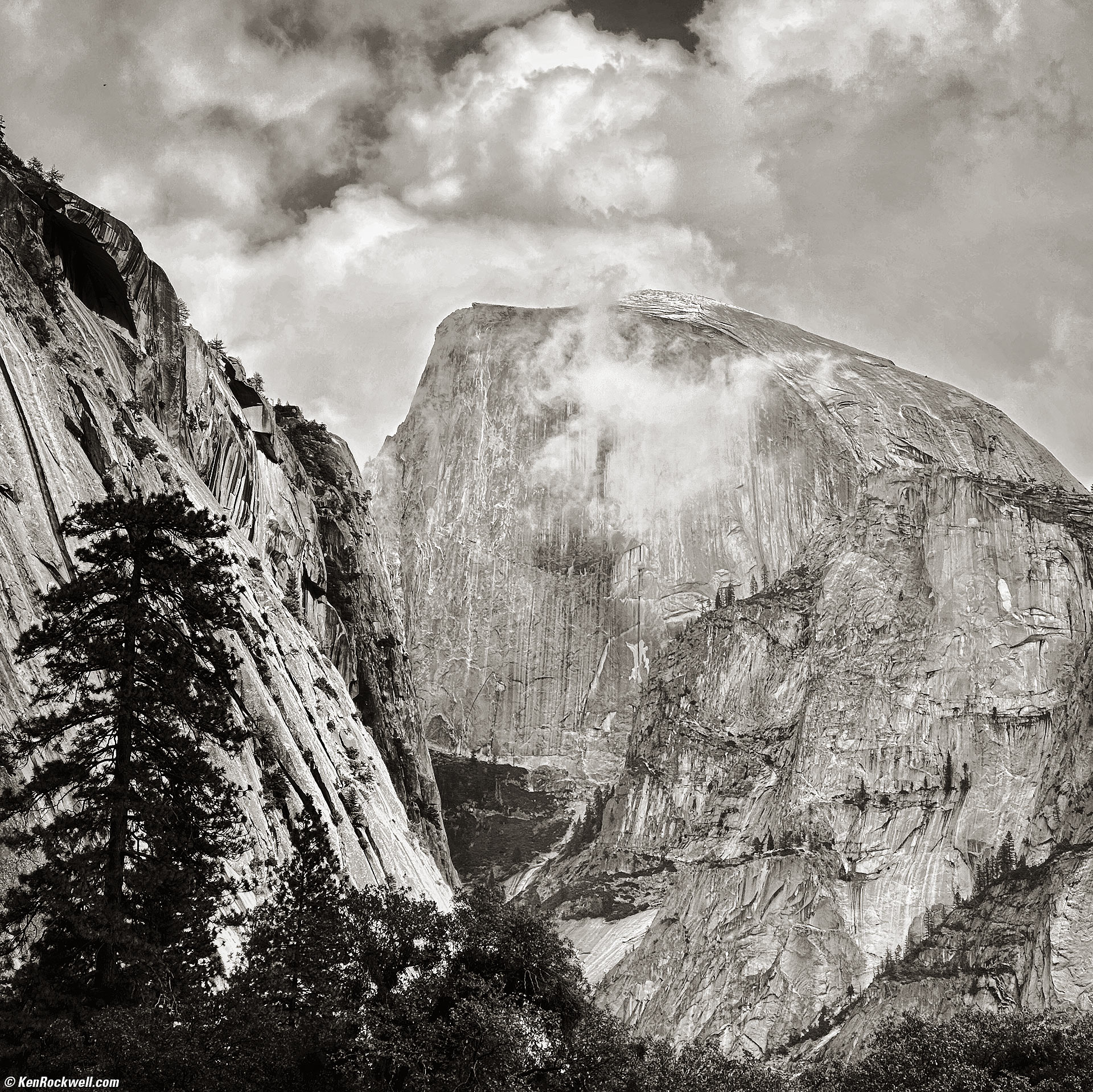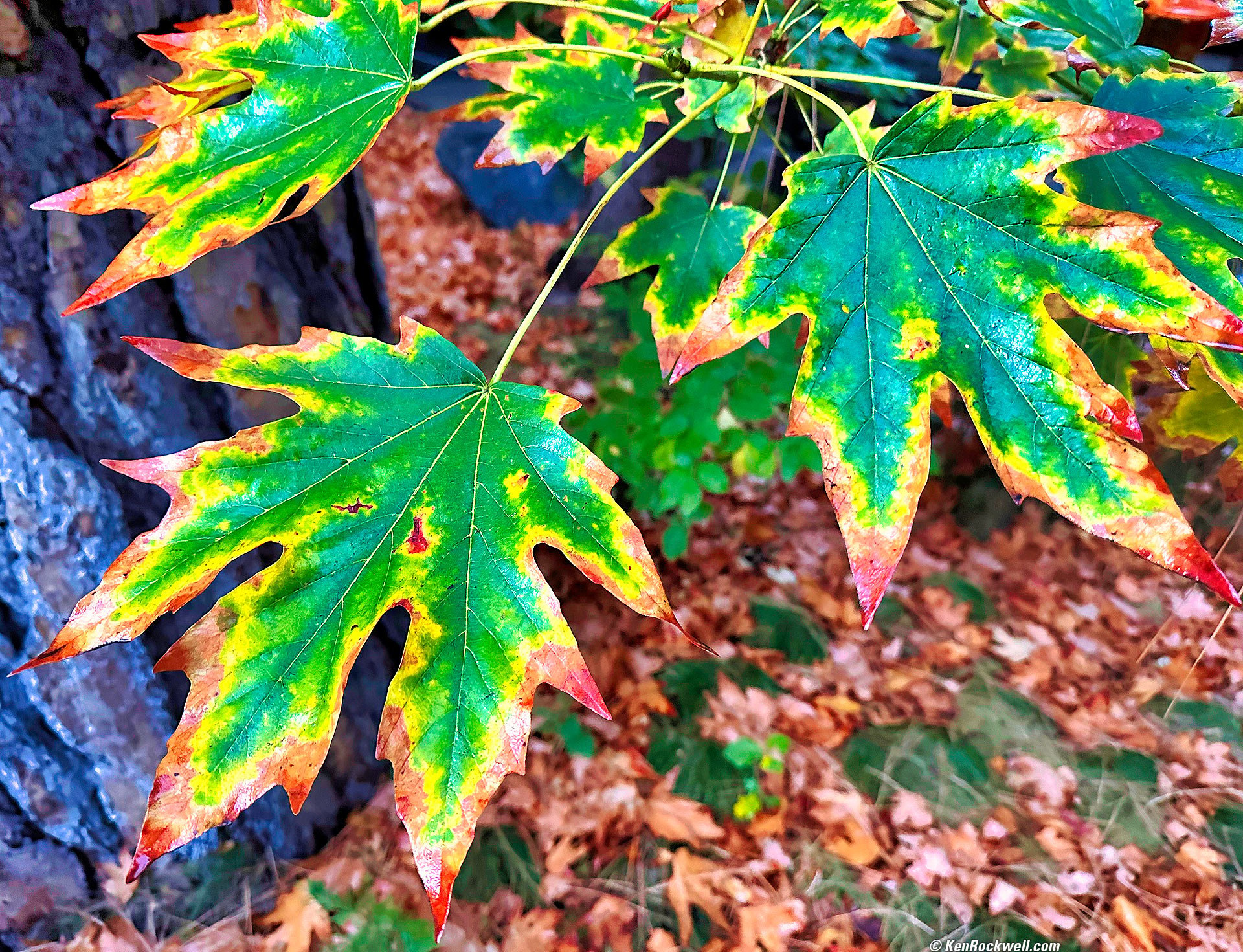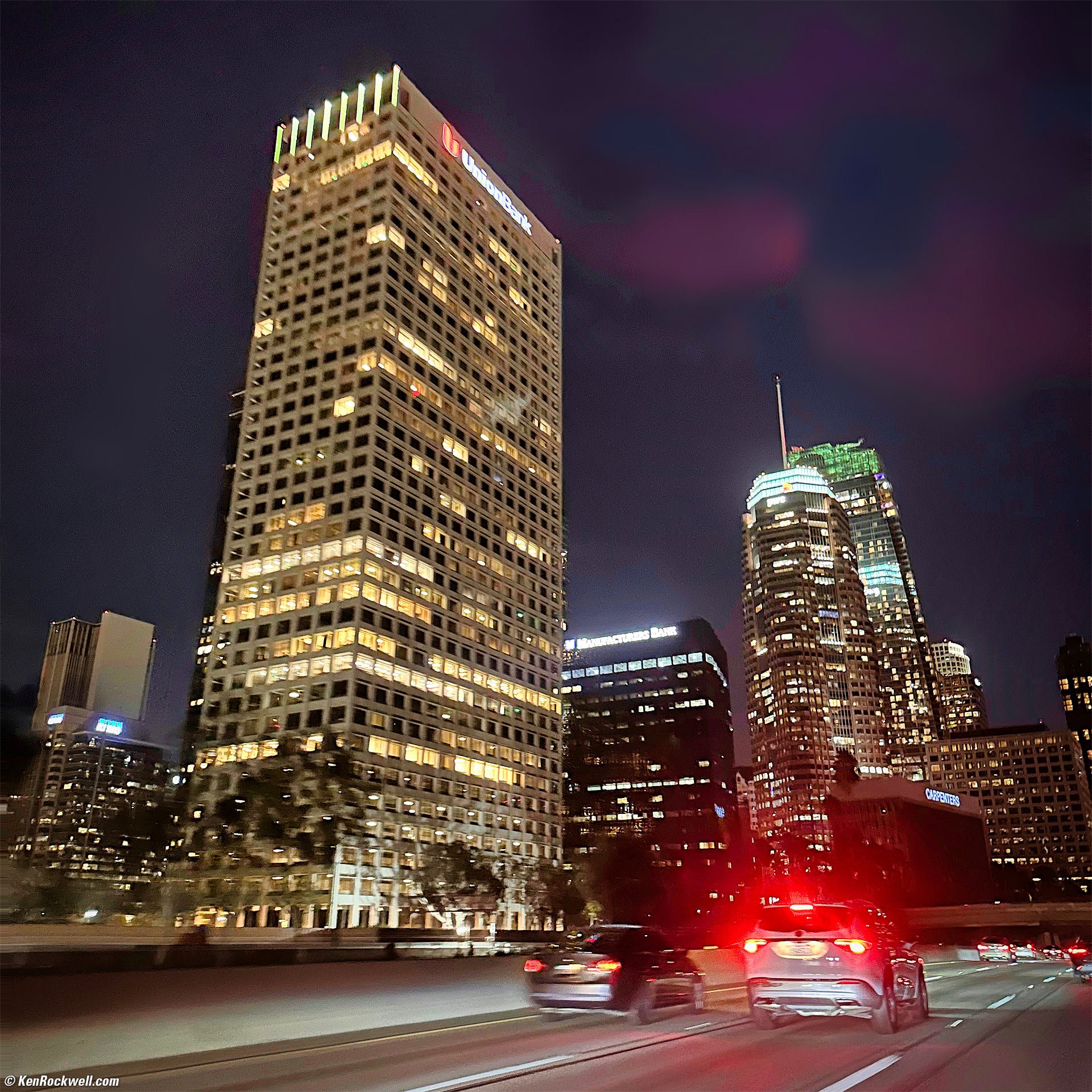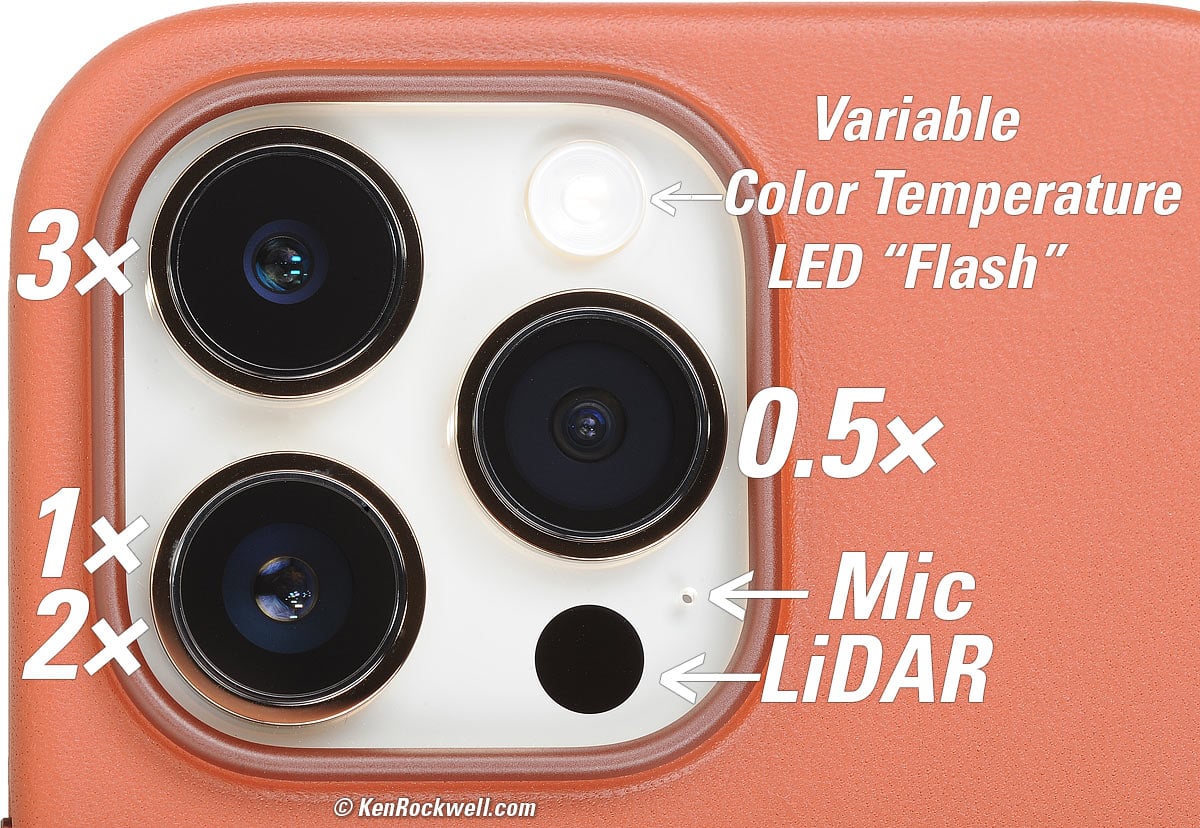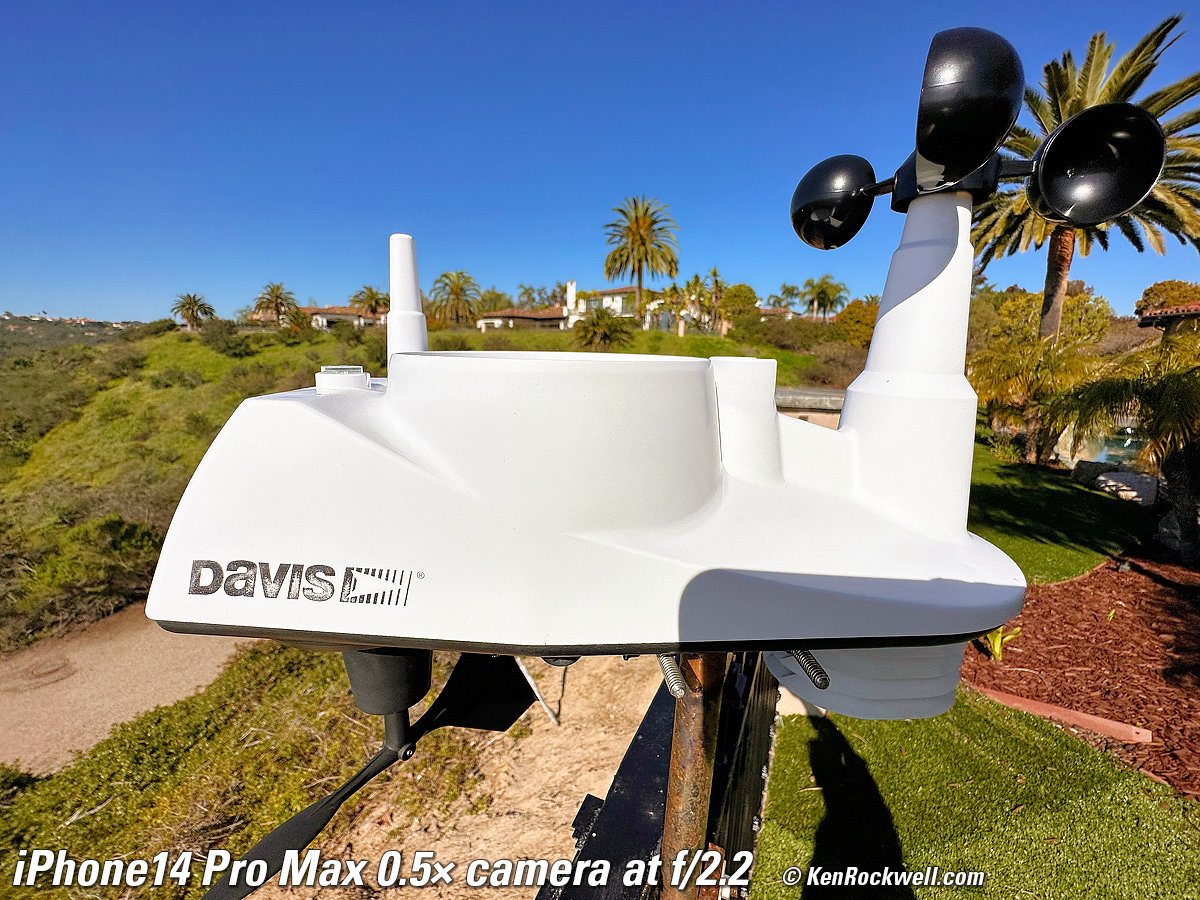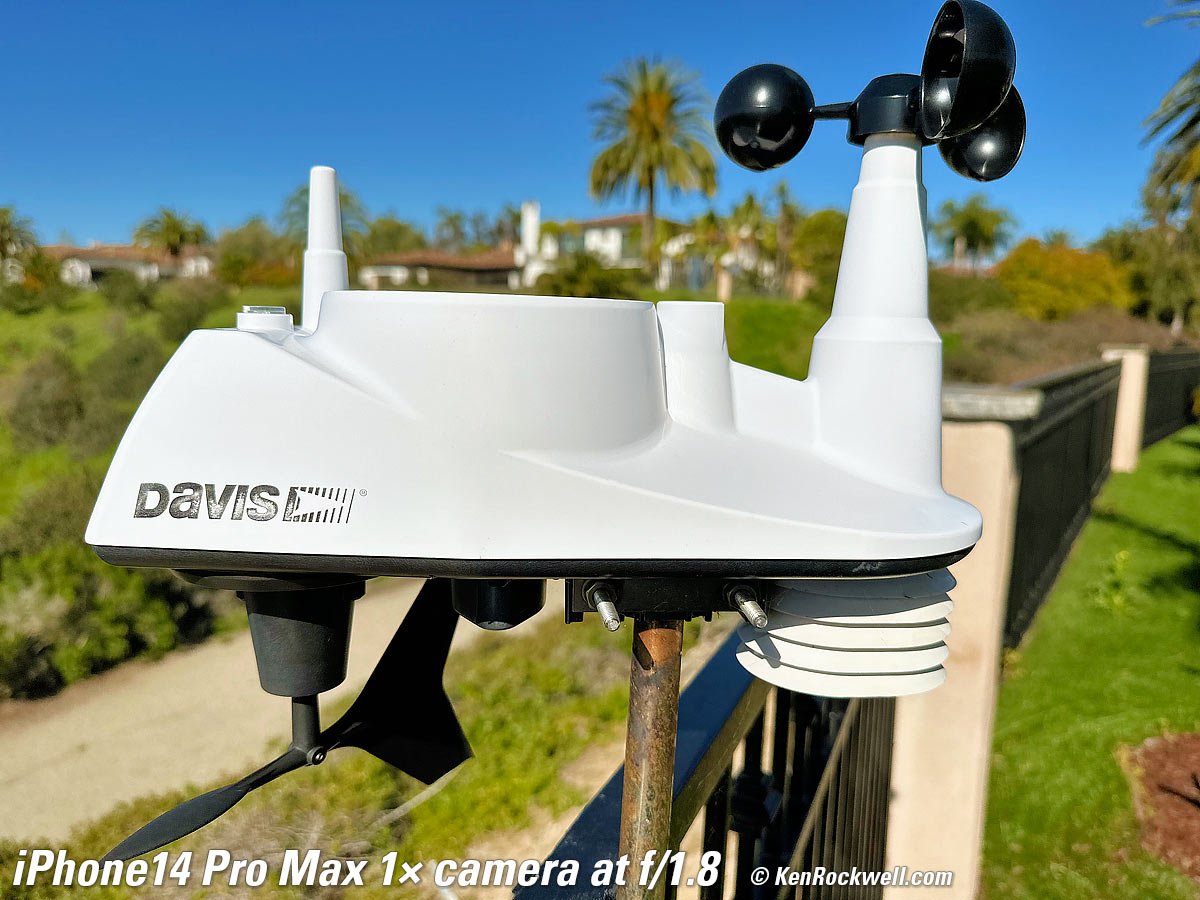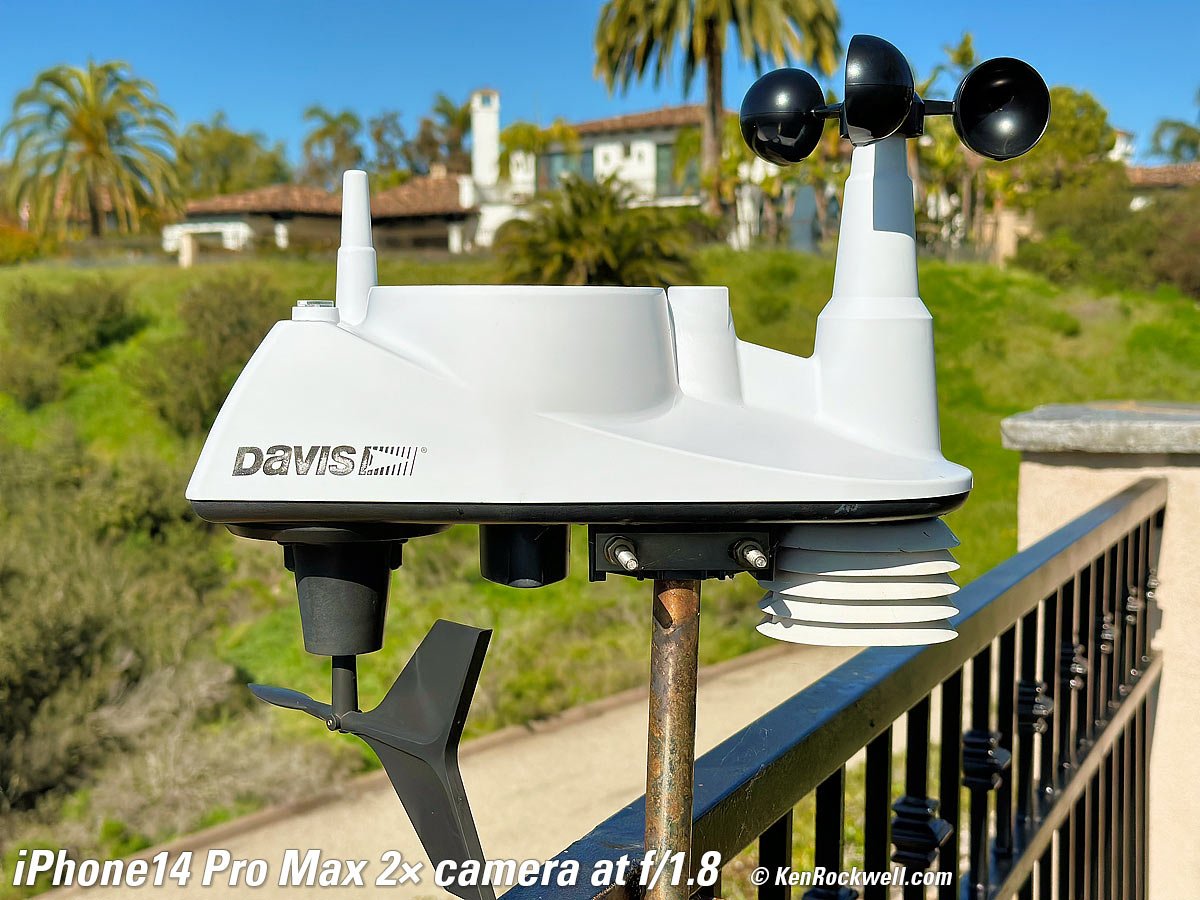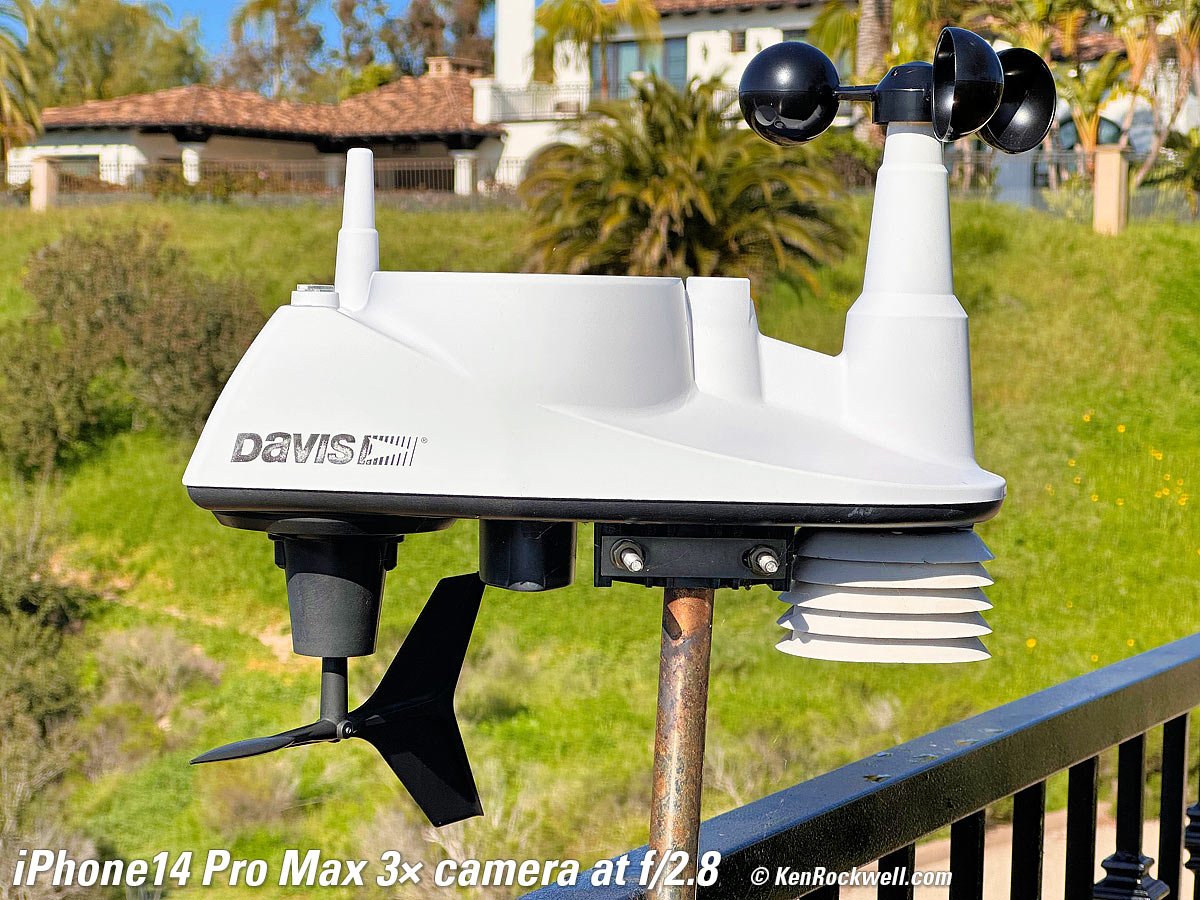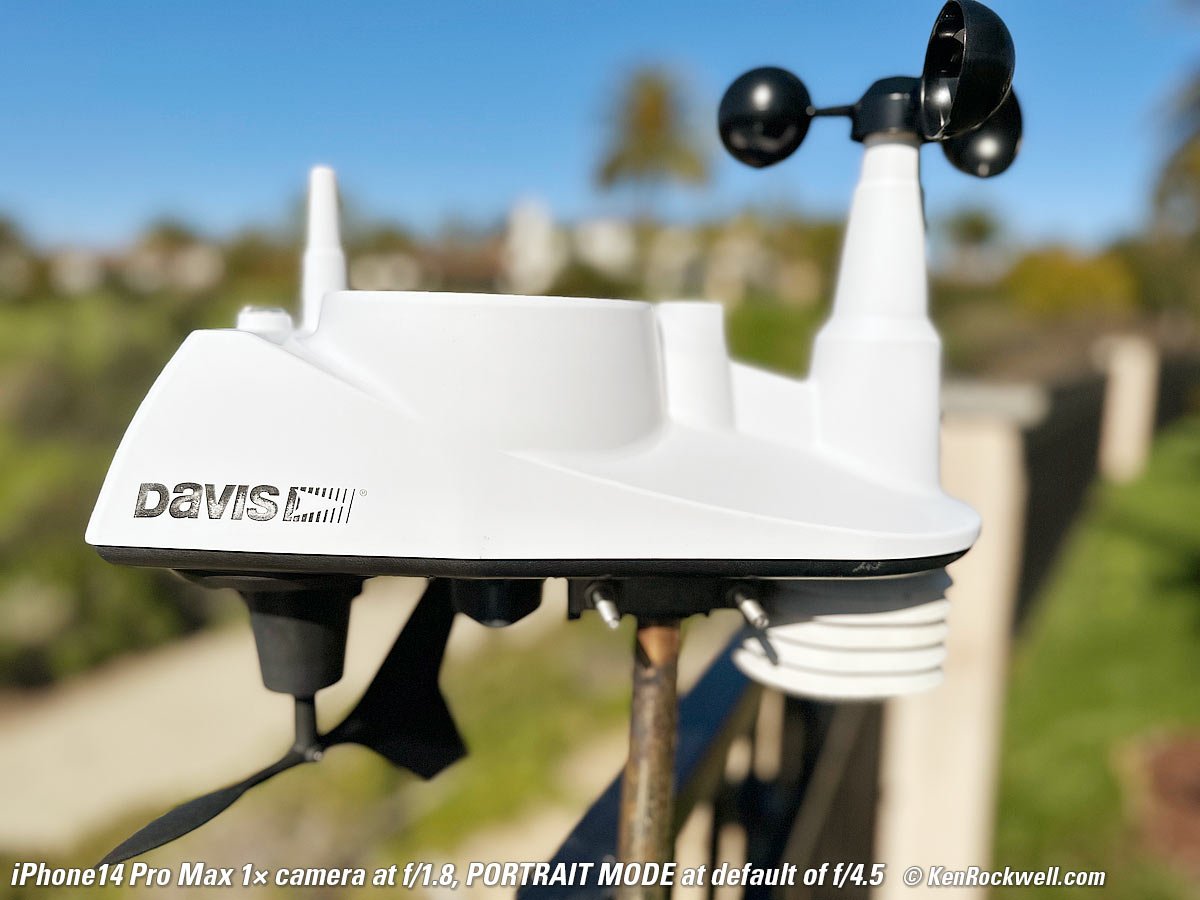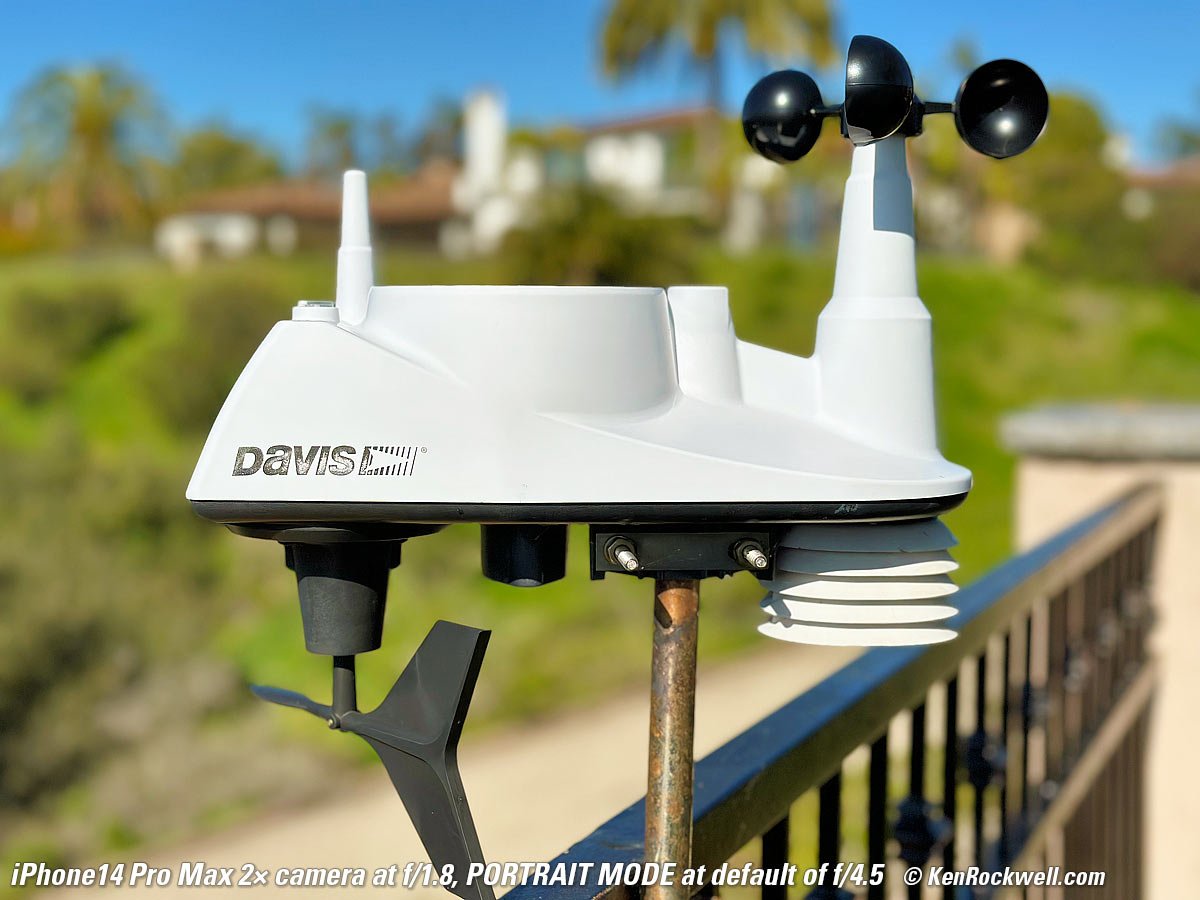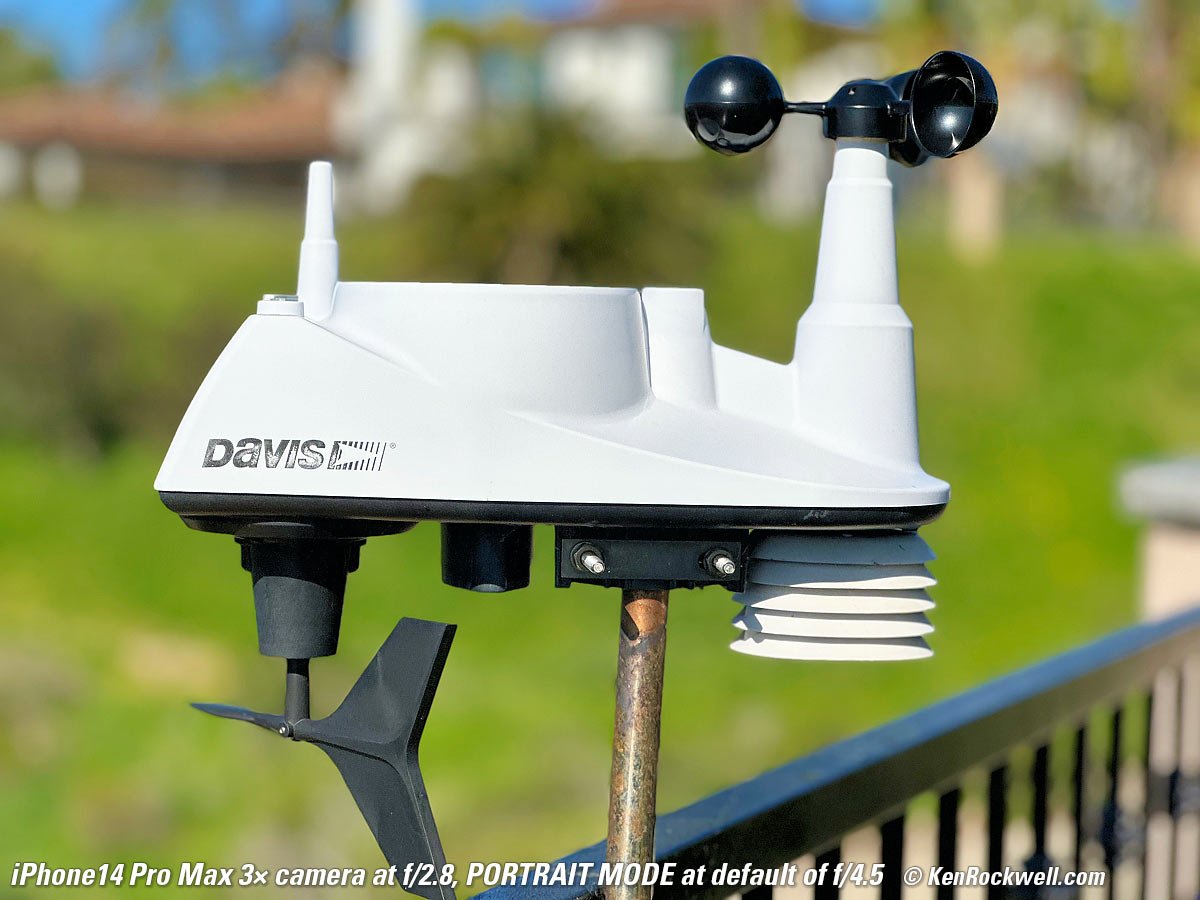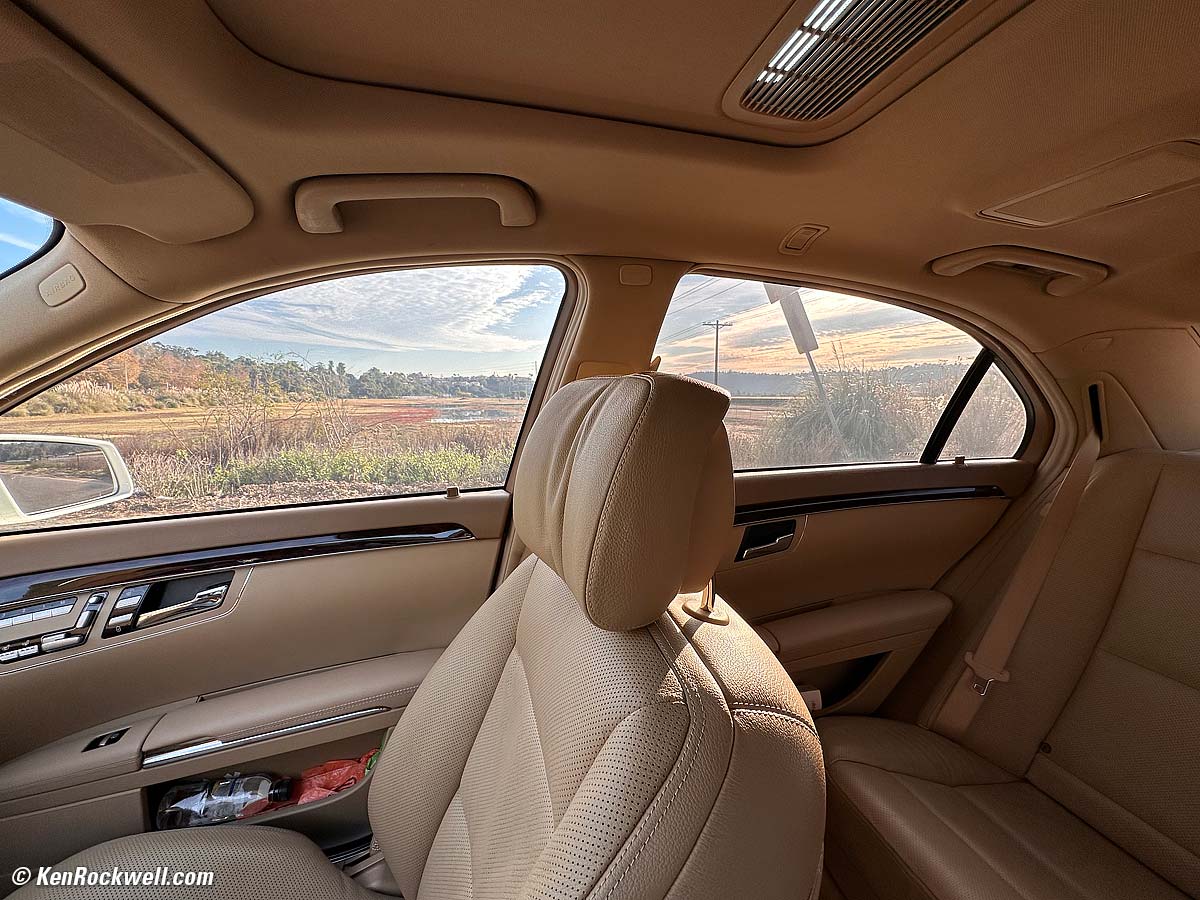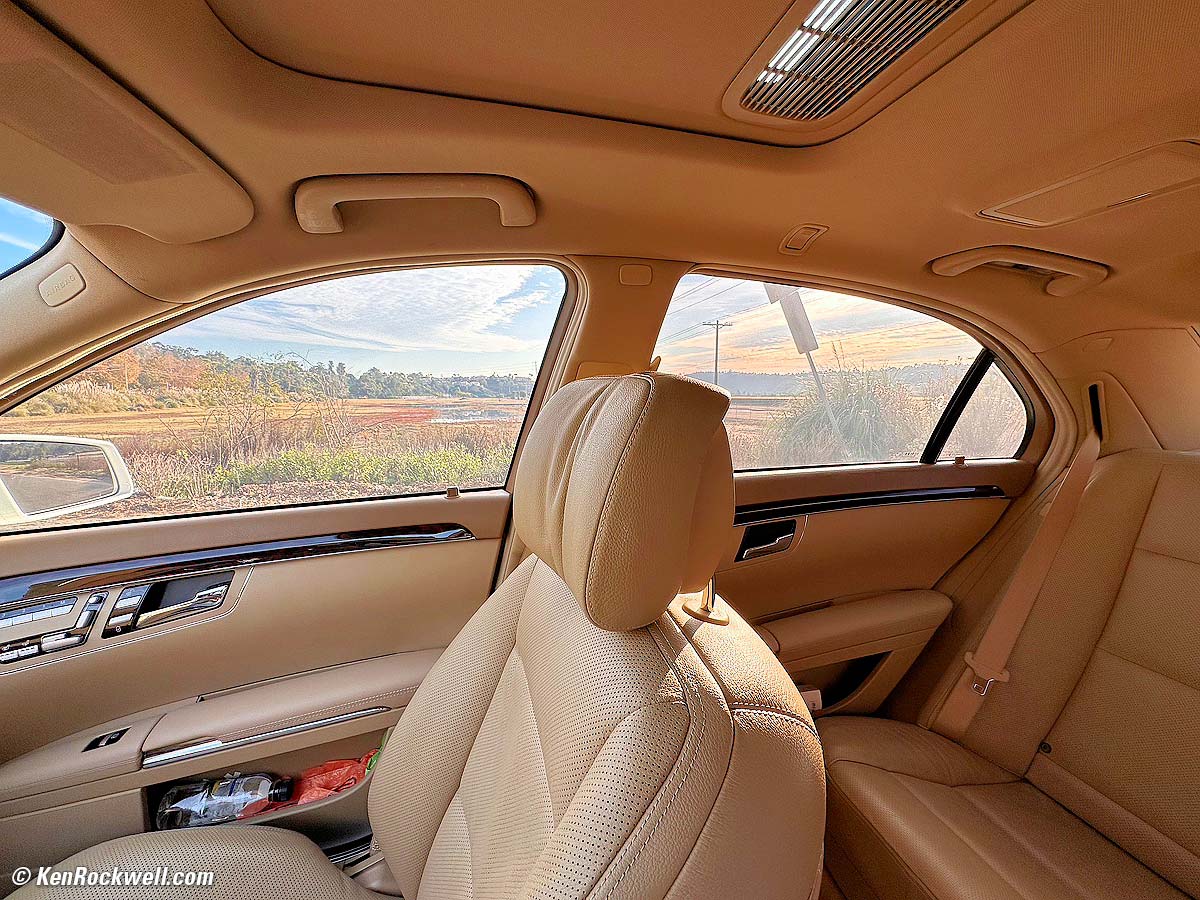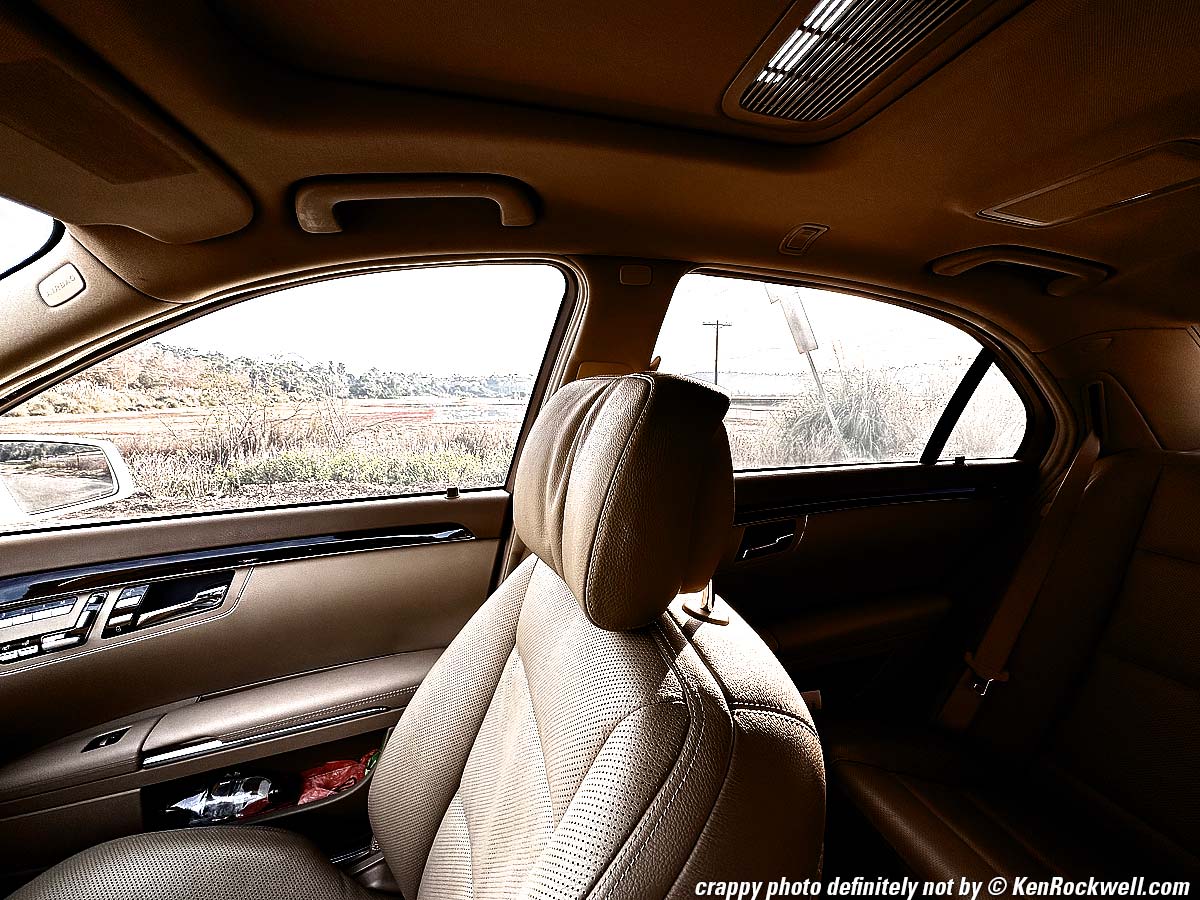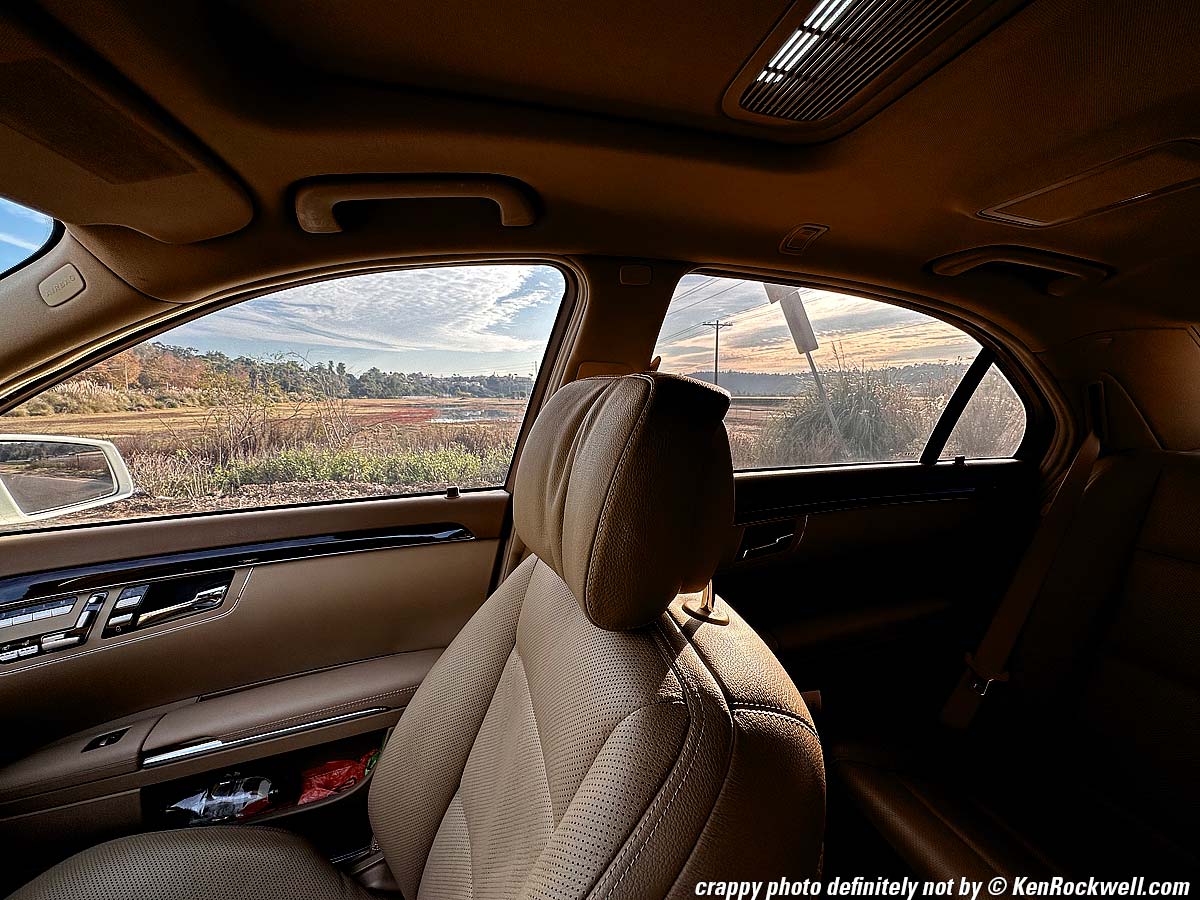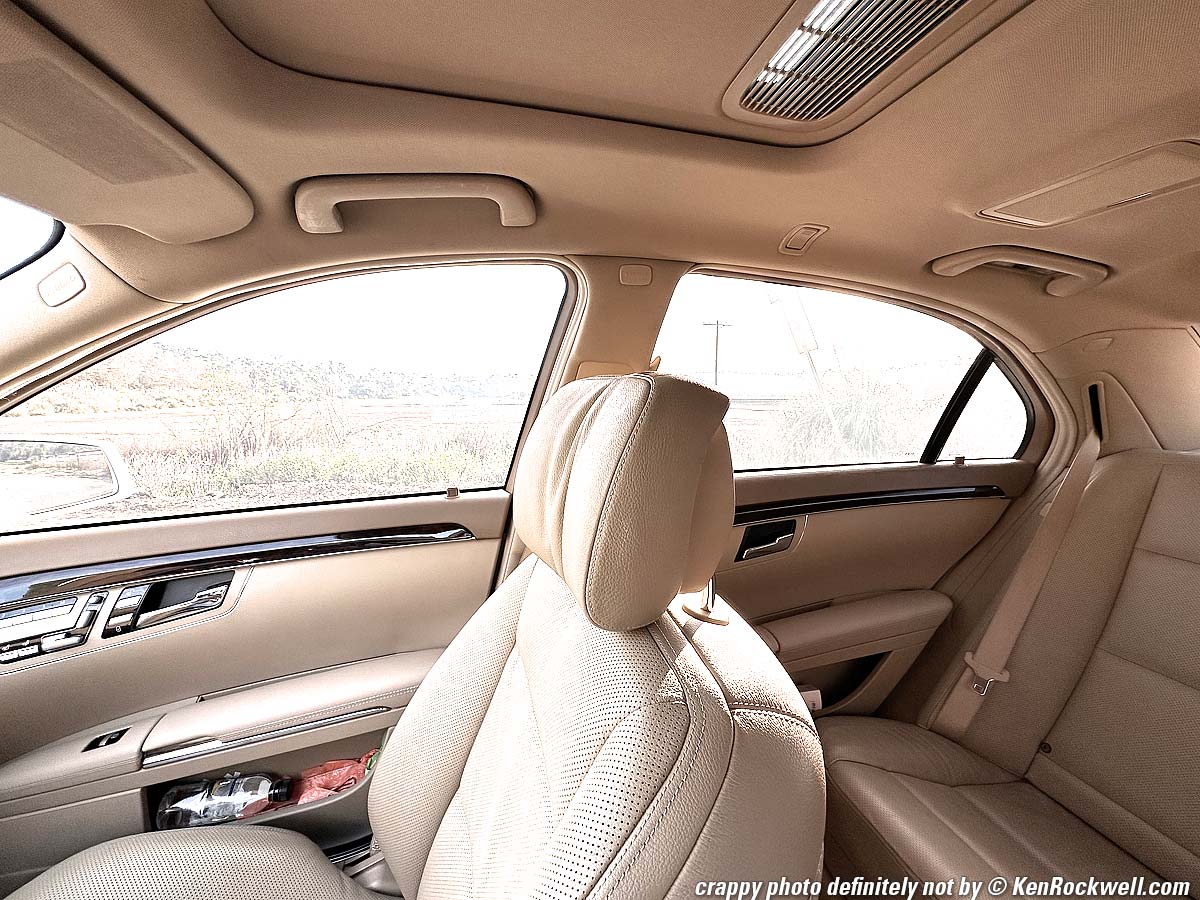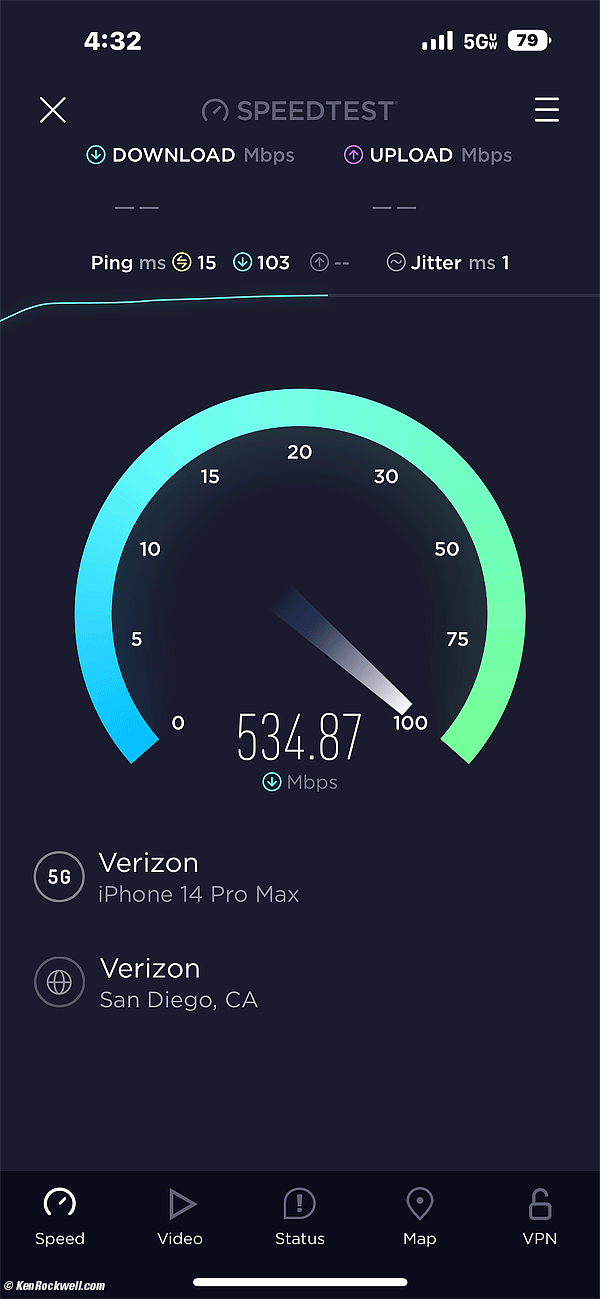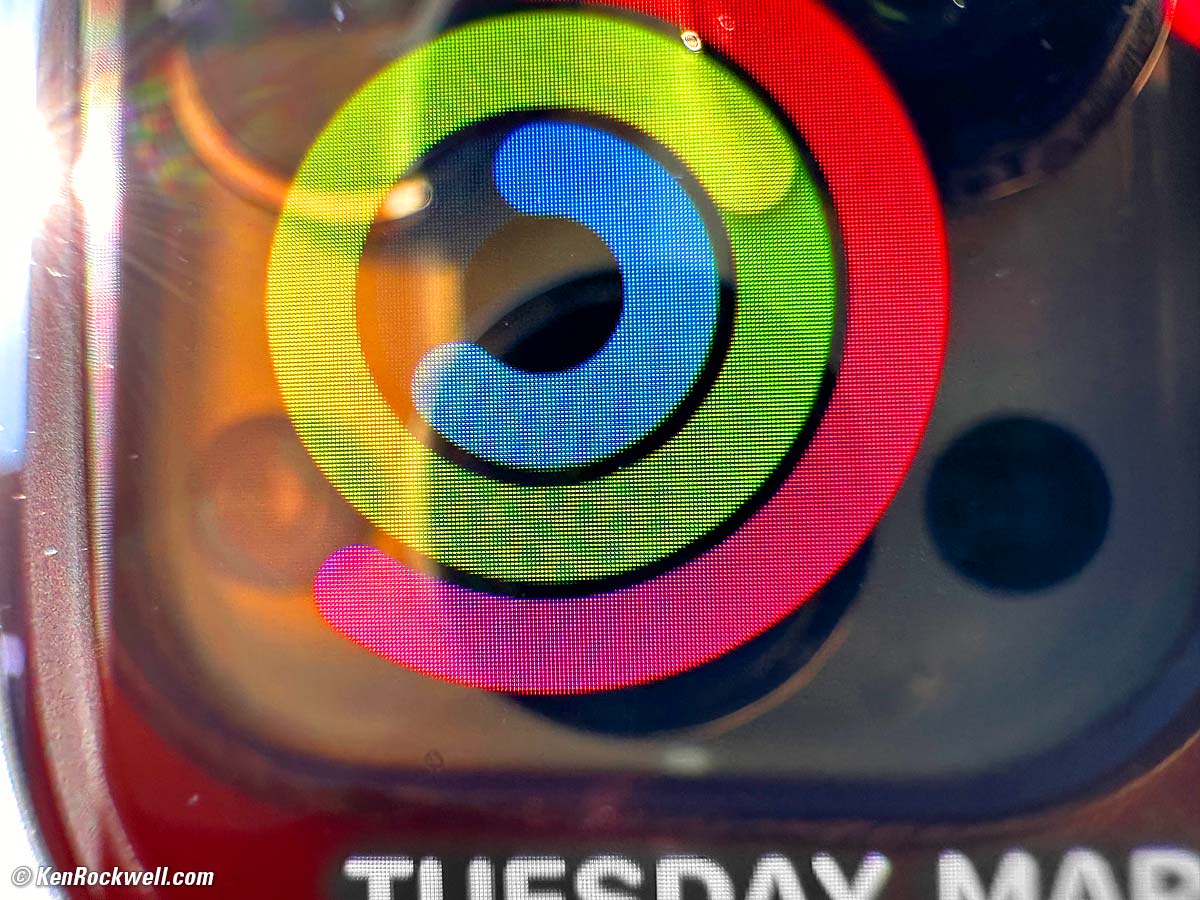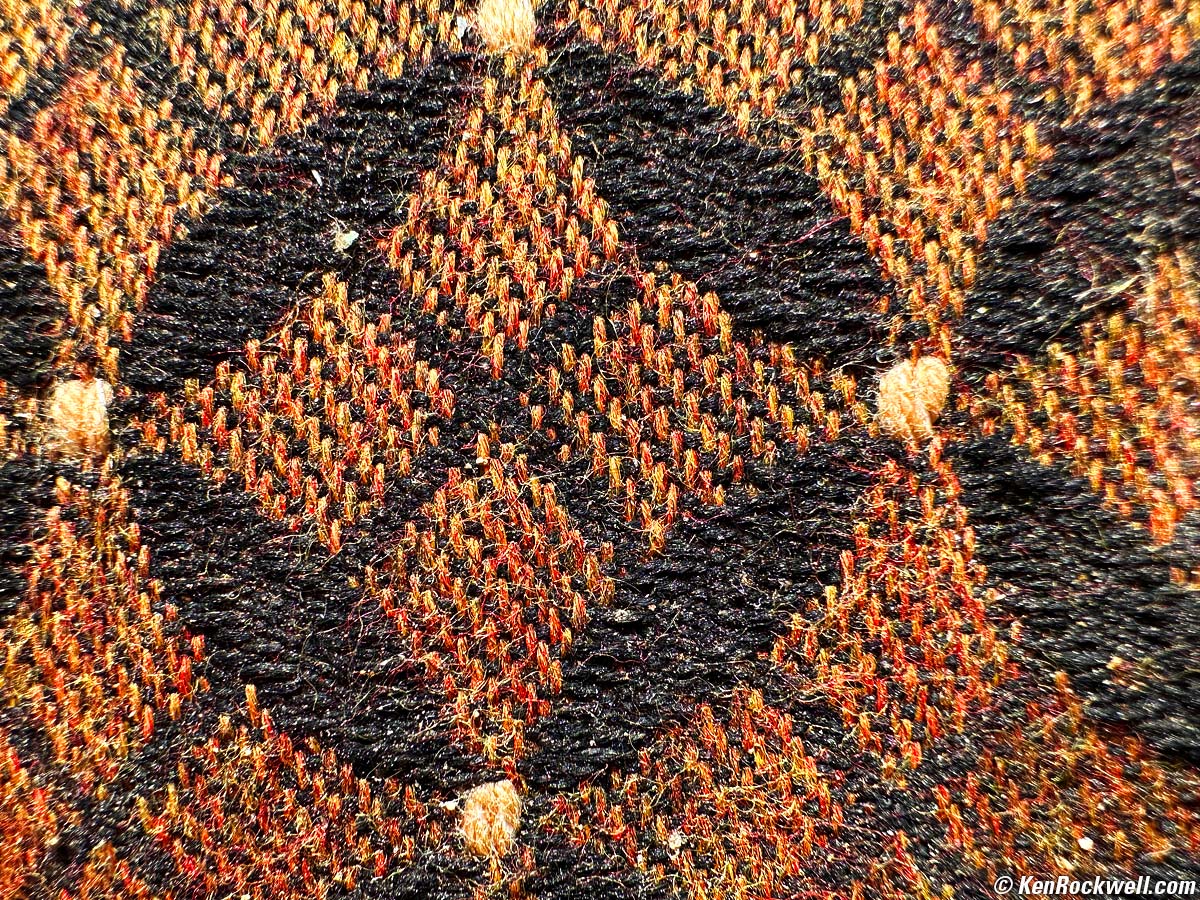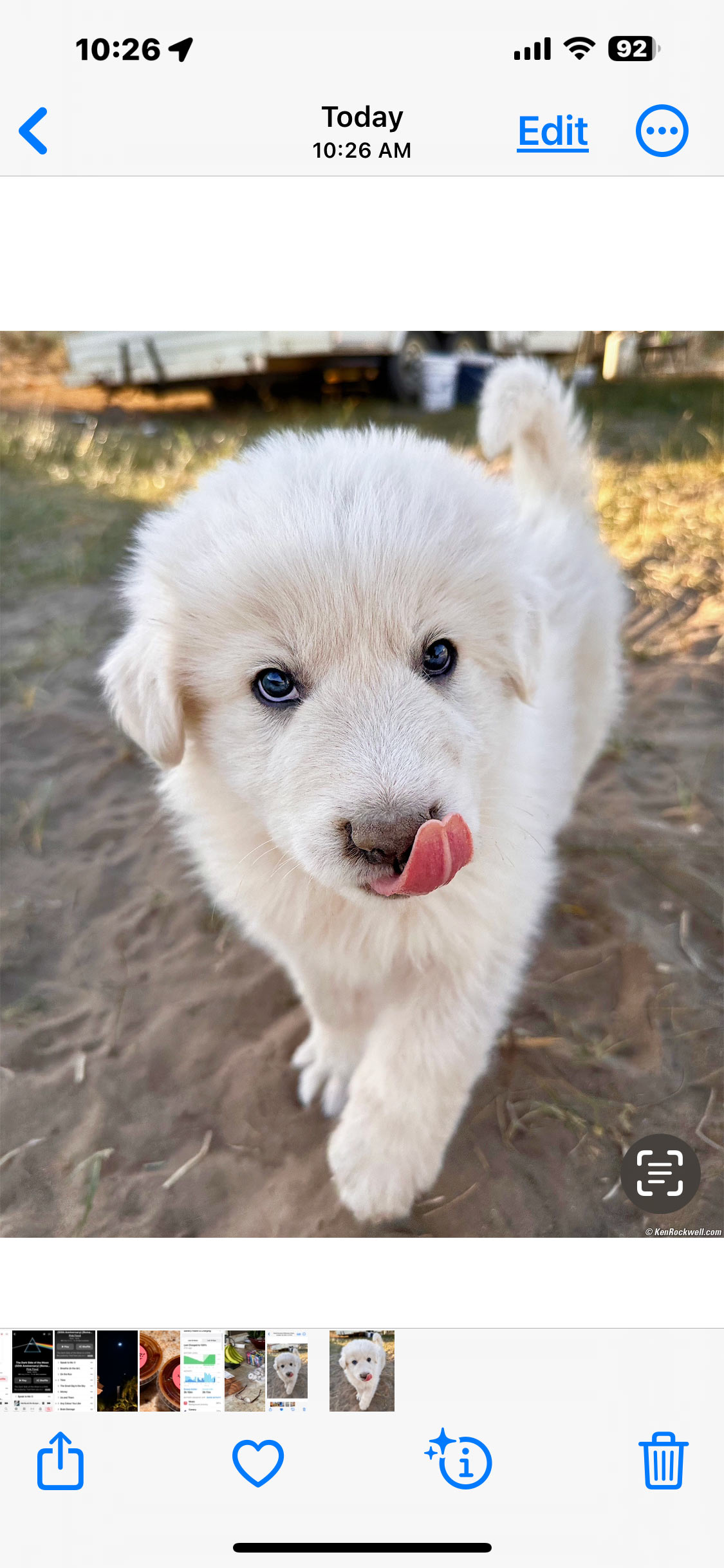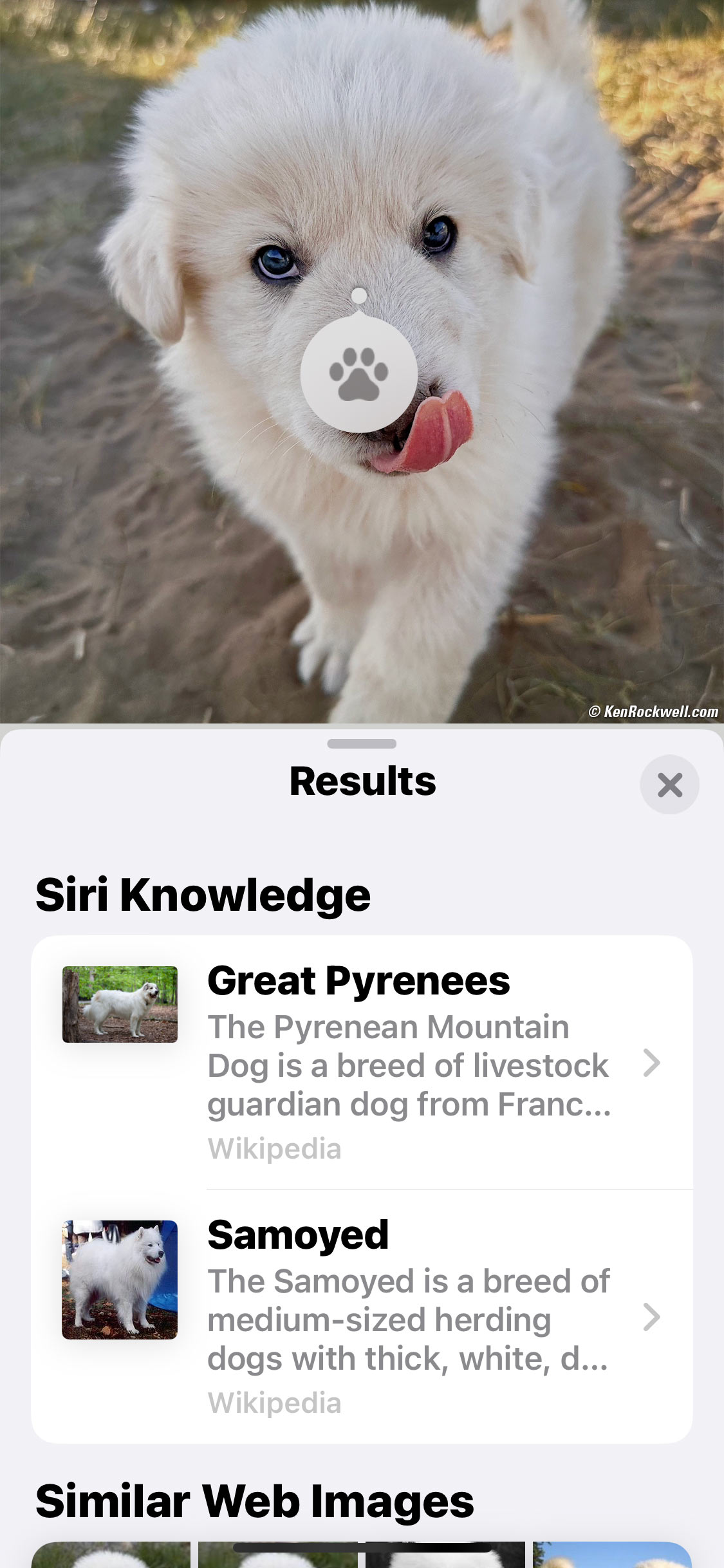iPhone 14 Pro Max
48 MP at 10 FPS, 4K/60 Dolby Vision HDR, 1,080/240 Camera Review
Sample Images Intro New Good Bad Missing
Specifications Accessories Performance
Compared User's Guide Recommendations
Back. bigger. |
Front. bigger. |
iPhone 14 Pro Max (sapphire protective lens covers and integral Ceramic Shield screen protection standard, 8.5 oz./242g) in Apple leather case (1.0 oz./30g; 9.6 oz./272 g total).
You can get them at Amazon, or used at eBay if you know How to Win at eBay.
This all-content, junk-free website's biggest source of support is when you use those or any of these links to approved sources when you get anything, regardless of the country in which you live. Thanks for helping me help you! Ken.
May 2023 Better Pictures Apple Canon Sony Nikon Fuji LEICA Zeiss HASSELBLAD All Reviews
iPhone 14 Pro Max Tutorial & User's Guide
Sample Images top
Sample Images Intro New Good Bad Missing
Specifications Accessories Performance
Compared User's Guide Recommendations
These are from my trips to Yosemite & California's Eastern Sierra in October 2022, at which you can read more about how I crafted each image.
I'm an artist. Most of these received significant creative input after I shot them, often editing them in my iPhone itself.
Here are more technical and artistic details about how I made these photos. You can see more of my work at my Gallery.
All these photos were shot in just seven days:
Clouds over June Lake, California as Seen from a Moving Car on US Route 395, California, 2:56 P.M., 17 October 2022. Apple iPhone 14 Pro Max 1× (6.9mm actual or 24mm eq.) camera, f/1.8 at 1/4,762 at Auto ISO 80 (LV14.2). More tech details. bigger or fit-to-screen..
A great thing always about iPhone is that it shoots wide-open even in daylight. It has and needs no lens diaphragm. Its short 6.9mm actual (24mm equivalent) focal length 1× standard camera has plenty of depth of field at f/1.8, and shooting at f/1.8 in daylight means that the 1/4,762 shutter speed stopped all the motion. The foreground would have been horribly motion-blurred if I had tried to jam my EOS R6 up to the windshield, and good luck to me trying to see the EOS R6's tiny dim LCD at arm's length in a moving car!
Lukas, Redwood Motel, Bridgeport, California, 3:51 P.M., 17 October 2022. Apple iPhone 14 Pro Max 1× (6.9mm actual or 24mm eq.) camera, f/1.8 at 1/60 at Auto ISO 125 (LV 7¼). More tech details. bigger or fit-to-screen.
Among the many things that impress me about the iPhone is how I can completely remain in the moment and reach down with one hand and capture whatever's going on. Unlike big cameras with tiny LCDs and finicky autofocus systems, the iPhone has a huge screen I can see from a few feet away and a LiDAR LASER-guided autofocus system. The iPhone's AF system is superior to larger cameras in that it magically figures out - even in pitch black - that it's a dog and focuses directly on his eyes, not his nose, letting me capture totally crazy action like an excited dog jumping all over me after he hasn't seen me for three years.
It's so sharp in the original file that you can see Lukas' own view of me towering over him reflected in his eye. Check your monitor now; the image here should have every hair very clearly delineated around his eye. You may or may not see this depending on your monitor and its size; windows PCs still seem to use obsolete 106 DPI displays compared to ultrafine iPhone, iPad and Mac Retina displays that run around 225-475 DPI. Each of these images has been reduced to 1,920 pixels wide from the original files.
Highlight inside an Abandoned Mine near Walker Lake, Bridgeport, California, 5:14 P.M, 17 October 2022. Apple iPhone 14 Pro Max camera system at its 2× setting (which magically crops from the 1× camera's 48 MP sensor and 6.9mm lens to a full-frame equivalent of 48mm), f/1.8 at 1/64 at Auto ISO 80 (LV 8.0). More tech details. bigger or fit-to-screen.
Abandoned Mine near Walker Lake, Bridgeport, California, 5:16 P.M., 17 October 2022. Apple iPhone 14 Pro Max 0.5× (2.2mm actual or 13mm eq.) camera at f/2.2 at 1/155 at Auto ISO 40 (LV 10.9). More tech details. bigger or fit-to-screen.
I first worked this in the free Snapseed app on my iPhone while on location, and later used Skylum Luminar Neo to take it further.
I love how my iPhone makes it trivial to jam it into any weird position and still be super-easy to compose on its huge, bright screen, especially with its ultra-ultra wide 0.5× (2.2mm actual or 13mm eq.) camera with which every millimeter of position changes the picture's composition.
Also because of its super-short (2.2mm actual focal length) lens the iPhone's ultra-ultra wide 0.5× camera has almost limitless depth of field. No way was I going to crawl around in this mess with a big camera just inches off the ground and hope to keep it all in focus.
Sunset, East of Walker Lake, Bridgeport, California, 6:01 P.M.17 October 2022. Apple iPhone 14 Pro Max 0.5× (2.2mm actual or 13mm eq.) camera, f/2.2 at 1/369 at Auto ISO 40 (LV 12⅛). More tech details. bigger or fit-to-screen.
I did most of the jacking of this image with the free Snapseed app on my iPhone at the scene, and then worked it some more in Skylum Luminar Neo.
Try editing and sharing your images right from your Canon, Sony, Nikon, Fuji, LEICA or HASSELBLAD as we take for granted with iPhone!
Virginia Creek Settlement Restaurant, Bridgeport, California, 7:19 P.M. 17 October 2022. Apple iPhone 14 Pro Max 0.5× (2.2mm actual or 13mm eq.) camera, f/2.2 at 1/40 at Auto ISO 1,250 (LV 4.0). More tech details. bigger or fit-to-screen.
I fiddled with this with the free Snapseed app on my iPhone at the location and then more back in my studio in Skylum Luminar Neo.
Sunrise over Mono Lake as Seen from Conway Summit, 6:49 A.M., 18 October 2022. Apple iPhone 14 Pro Max 3× (9mm actual or 77mm eq.) camera, f/2.8 at 1/99 at Auto ISO 125 (LV 9.3). More tech details. bigger or fit-to-screen.
Sunrise over Mono Lake as Seen from Conway Summit, 7:05 A.M., 18 October 2022. Apple iPhone 14 Pro Max 3× (9mm actual or 77mm eq.) camera, f/2.8 at 1/247 at Auto ISO 32 (LV 12.6). More tech details. bigger or fit-to-screen.
Yes, these are similar images, but they are also very different. My website, my rules.
Pine Cone, Poole Power Plant Road, Mammoth Lakes, California, 12:24 P.M., 18 October 2022. Apple iPhone 14 Pro Max 1× (6.9mm actual or 24mm eq.) camera, f/1.8 at 1/1,495 at Auto ISO 80 (LV 12½). More tech details. bigger or fit-to-screen.
With its larger 48 MP sensor the iPhone 14 Pro Max now also has a longer lens to retain a similar 24mm equivalent 1× angle of view. For the first time I often notice background optical defocus effects in regular shooting, as you can see here and at the dog closeup photos above and below. This defocus (bokeh) is what's coming from the lens; it's not an electronic portrait mode.
Brick Building, Bodie, California, 3:24 P.M., 18 October 2022. Apple iPhone 14 Pro Max 1× (6.9mm actual or 24mm eq.) camera, f/1.8 at 1/3,247 at Auto ISO 80 (LV 13⅔). More tech details. bigger or fit-to-screen.
Very Cute Great Pyrenees Puppy with Tongue, Bridgeport, California, 5:14 P.M., 18 October 2022. Apple iPhone 14 Pro Max 1× (6.9mm actual or 24mm eq.) camera, f/1.8 at 1/810 at Auto ISO 80 (LV 11⅔). More tech details. bigger or fit-to-screen.
The iPhone rules for these sorts of photos, where I easily can see its huge screen and motor away at 10 FPS with the phone in one hand and petting the pups with the other. This could be my favorite photo from this week of shooting.
Also notice how the iPhone nailed autofocus in this fast-paced peppy puppy pandemonium. It nailed the eyes and didn't get sidetracked with the nose or the background, as a Nikon Z would do!
The defocused background is a native optical phenomenon, not an electronic effect. The longer normal lens (6.9mm) in the 1× camera today shows definite background defocus in closeups.
Redwood Motel, Bridgeport, California, 6:34 P.M. — when everything changed, 20 October 2019. Apple iPhone 14 Pro Max 0.5× (2.2mm actual or 13mm eq.) camera, f/2.2 at 1/60 at Auto ISO 800 (LV 5.2). More tech details. bigger or fit-to-screen.
Moon and Stars over Redwood Motel Room 15, Bridgeport, California, 5:19 A.M., 19 October 2022. Apple iPhone 14 Pro Max 1× (6.9mm actual or 24mm eq.) camera, f/1.8 hand-held at 1/2 second at Auto ISO 8,000 (LV -3¾ IPS; that's LV minus 3¾!). More tech details. bigger or fit-to-screen.
I went outside at 5:19 A.M. in the morning, looked up and saw the moon over our motel! I whipped out my iPhone and made a snap, and it looked exactly as this scene looked to my eyes! The iPhone 14 Pro Max is astonishing!!!
While my iPhone caught this scene exactly as it looked to my eyes, it was very dark, with an inky black sky, hours before dawn. That's not how I want to show it, so I used the Perfectly Clear plug-in in Photoshop CS6 (2012) to lighten it up and make it much more exciting — exactly as I wanted it to look rather than how it actually looked. The red light on the foreground is from car taillights of others in our group who were ready to head out.
Back in olden days I'd have needed a tripod to make a half-hour exposure at f/4.5 on Velvia 50 to get this same exposure (allowing for reciprocity failure), and even if I didn't have to set up a tripod I'd have missed the rest of the group because we all took off six minutes after this at 5:25 A.M. to catch the 7:10 A.M. sunrise down at Mono Lake's South Tufa.
Even with a half-hour exposure at f/4.5 it would have been tough to get both the sky and motel in focus at the same time. The iPhone 14 Pro Max has much more depth of field due to its much shorter 6.9mm actual focal length lens. Velvia also would turn very green with a long exposure, and other films are similarly difficult. With my iPhone I can shoot things like this that simply couldn't be caught on film under real-world time constraints like this; this was a hand-held grab shot as we headed out.
Sunrise, South Tufa, Mono Lake, California, 7:35 A.M., 19 October 2022. Apple iPhone 14 Pro Max 0.5× (2.2mm actual or 13mm eq.) camera, f/2.2 at 1/445 at Auto ISO 40 (LV 12.4). More tech details. bigger or fit-to-screen.
While I had my EOS R6 and RF 15-30mm IS STM around my neck, I wasn't about to climb down on my belly on these rocks, and I certainly wasn't going to try to look at the R6's dinky screen compared how easy it is to drop my arm down with my iPhone, whose brilliant huge screen makes this all easy. I'm very close to the rocks; the ultra-ultrawide lens makes it seem like I'm much higher, but my iPhone is actually pretty far down in the rocks to bring the foreground much closer.
Just for laughs here's how it looked on my iPhone 14 Pro Max screen as I shot it:
Screenshot, Apple iPhone 14 Pro Max. bigger or fit-to-screen.
Dancing Inferno off Parker Lake Road, Mammoth Lakes, California, 9:52 A.M., 19 October 2022. Apple iPhone 14 Pro Max 0.5× (2.2mm actual or 13mm eq.) camera, f/2.2 at 1/972 at Auto ISO 50 (LV 13.2). More tech details. bigger or fit-to-screen.
Much of the magic here comes from, in addition to paying rapt attention to composition, adding saturation and vignetting in the free Snapseed app on my iPhone while I was shooting and sending the images to friends back home.
Aspens, Little Walker River Road, Bridgeport, California, 5:18 P.M., 19 October 2022. Apple iPhone 14 Pro Max 1× (6.9mm actual or 24mm eq.) camera, f/1.8 at 1/2,070 at Auto ISO 80 (LV 13.0). More tech details. bigger or fit-to-screen.
Most of this I did in the free Snapseed app on my iPhone, and later brought up the shadows in Skylum Luminar Neo.
Will Works His Fire, Bridgeport, California, 6:32 P.M., 19 October 2022. Apple iPhone 14 Pro Max 1× (6.9mm actual or 24mm eq.) camera, f/1.8 at 1/60 at Auto ISO 640 (LV 4.9). More tech details. bigger or fit-to-screen.
This is as shot, except for cropping and using Skylum Luminar Neo's Erase tool to remove some background distractions.
iPhone easily handles this crazy lighting; point and shoot. Good luck with reportage futzing with a LEICA M's manual focus and center-weighted-only metering!
Silver Maple Inn, Bridgeport, California, 6:38 P.M., 19 October 2022. Apple iPhone 14 Pro Max 1× (6.9mm actual or 24mm eq.) camera, f/1.8 at 1/30 at Auto ISO 1,000 (LV 3¼). More tech details. bigger or fit-to-screen.
The Milky Way as seen from Twin Lakes Road, Bridgeport, California, 9:35 P.M., 19 October 2022. Apple iPhone 14 Pro Max 1× (6.9mm actual or 24mm eq.) camera, f/1.8 for 10 seconds (tripod) at Auto ISO 12,500 (LV -8.6, that's LV minus 8.6!). More tech details. bigger or fit-to-screen.
To Shoot The Milky Way with an iPhone, I used my Oben CT-2491 Carbon-Fibre Tripod with my Manfrotto 410 (née Bogen 3275) Geared Head and Oben SPA-1000 iPhone adapter to hold it still, but it also works simply hand-holding it braced against something. By default iPhone will try to use flash, so turn that off by tapping the flash icon. Now that the flash is off, you'll see "☽ 3s" at the top (held vertically). For the cleanest image we want the longest exposure, so tap the little " ^ " symbol at the center top (held vertically) then along the bottom tap the ☽ moon (time exposure) icon and slide the time all the way to 30 seconds. Tap and release the ◉ shutter button, wait 30 seconds, and you've got your shot. If you hand-hold, the default exposure is about 2 seconds and the maximum time is about only 10 seconds.
The iPhone knows from its acceleration sensors if it's on a tripod or not, and only allows times longer than 10 seconds if you're on a tripod. It's also brilliant in knowing that the longest any normal person will hold an iPhone for a long exposure is only a few seconds, and adjusts accordingly hand-held. Even though you'll get something even handheld for just a few seconds, longer exposures collect more light and result in more detail and less noise.
While the indicated exposure times on the time exposure scale refer to the total time iPhone is exposing and counting down (like 30 seconds maximum in the shot above), the effective exposure time recorded in EXIF data is less (10 seconds in the shot above). This is because iPhone is using magic to capture and combine many, many separate shorter, sharper shots into the one file it saves.
The Apple iPhone 14 Pro Max shot this as it looked to our eyes: dim. Most of this I edited in the free Snapseed app on my iPhone. Back at my studio I amped it even further in Skylum Luminar Neo. The actual Milky Way is very dim to our eyes, against a sea of stars. My iPhone caught enough invisible detail that I could pull it out later. Bravo!
My newest Apple iPhone 14 Pro Max is vastly superior to my iPhone 11 Pro Max I used to make a similar shot back in 2019. My 2019 shot was astounding back in 2019 when I'd never seen a phone catch the Milky May before, but to be honest it was a very flat image that I forced into monochrome and then colorized to blue for effect — still a monochrome image, but oh the memories of that spot.
Now the Apple iPhone 14 Pro Max sees in color under starlight - which is something even our eyes can't do.
Here's something Nikon Z cameras can't do:
Screen Shot: You can see the stars live! bigger.
The finders of Nikon Z cameras, at least as of 2023, work very poorly in the dark. They become extremely noisy and nearly useless even in ordinary backyard nighttime light, while the iPhone is still amazingly clean and clear, showing us individual stars, even under starlight!
Valley View with Dramatic Sunset Clouds, Yosemite National Park, California, 4:16 P.M., 21 October 2022. Apple iPhone 14 Pro Max 1× (6.9mm actual or 24mm eq.) camera (equivalent to a little cropping from the ZEISS 50mm f/4 DISTAGON on HASSELBLAD 6×6), f/1.8 at 1/1,062 at Auto ISO 80 (LV 12.0). More tech details. bigger or fit-to-screen.
I'm so bad. Artists know the only rule is that there are no rules. First I fiddled with this in the free Snapseed app in my iPhone right as I made the image. I amped it up, but the sky was blank.
No problem; Skylum Luminar Neo made it trivially easy to add a sky. I added vignetting for emphasis and removed the boring left side and empty bottom and cropped it into a tighter square.
Here's what came out of the iPhone, which is exactly as it looked to my eye — but not to my imagination:
As shot. bigger.
It's not just the crazy clouds and colors I added; cropping what's not needed both horizontally and vertically let what is important grow and make for a much stronger image.
Laugh all you want, but artists have been adding skies to landscapes forever, and photographers have been adding clouds to photos since the 1800's using different optically-printed negatives on different masked sections of printing paper. This is nothing new; back in olden days plates and film were only sensitive to blue and ultraviolet light and it was nearly impossible to get a sky to appear in the same image as the foreground.
The Milky Way and the Andromeda Galaxy as seen from Stoneman Meadow, Yosemite National Park, California, 8:56 P.M., 21 October 2022. Apple iPhone 14 Pro Max 1× (6.9mm actual or 24mm eq.) camera, f/1.8 at 10 seconds (tripod) at Auto ISO 12,500 (LV -8⅔, or minus 8⅔. That's dark!). More tech details. bigger or fit-to-screen.
The original iPhone image was rather dark and flat, sort of as it all looked to our eyes, so I used a simple curves adjustment layer to taste in Photoshop CS6 (2012).
I was astonished that my iPhone is able to photograph the Andromeda Galaxy (the diagonal blob center right). I've never see a phone do that!
Tunnel View, Yosemite National Park, California, 12:32 P.M., 22 October 2022. Apple iPhone 14 Pro Max 1× (6.9mm actual or 24mm eq.) camera, f/1.8 at 1/569 at Auto ISO 40 (LV 12¾), split-toned print. More tech details. bigger or fit-to-screen.
I used the free Snapseed app on my iPhone to tweak and send this to my friends while I was still there, and then fine-tuned it further with Skylum Luminar Neo.
The Half Dome in Clouds as Seen across Ahwahnee Meadow, Yosemite National Park, California, 3:18 P.M., 22 October 2022. Apple iPhone 14 Pro Max 3× (9mm actual or 77mm eq.) camera, f/2.8 at 1/840 at Auto ISO 32 (LV 14⅓), split-toned print. More tech details. bigger or fit-to-screen.
I first worked this in the free Snapseed app on my iPhone while at the location, and then later in Skylum Luminar Neo.
This crop is equivalent to a minor crop from the common ZEISS 150mm f/4 SONNAR on HASSELBLAD 6×6. Sitting in my armchair I realize that a 180mm f/4 SONNAR would actually be more equivalent to this crop, but Ansel or I never carry the 180mm lens. Everything in HASSELBLAD is so sharp that one simply carries the 150mm f/4 SONNAR and crops a little if needed, rather than carry an extra "in between" lens "just in case." All Ansel every carried were his 50mm, 80mm, 150mm and maybe 250mm, and he was all set for everything.
With iPhone, do we still need HASSELBLAD?
Maple Leaves, Yosemite Valley Lodge at the Falls, Yosemite National Park, California, 7:16 A.M., 23 October 2022. Apple iPhone 14 Pro Max 1× (6.9mm actual or 24mm eq.) camera, f/1.8 at 1/60 at Auto ISO 800 (LV 4.6). More tech details. bigger or fit-to-screen.
Yellow Dawn, Leidig Meadow at Sunrise, Yosemite National Park, California, 7:36 A.M., 23 October 2022. Apple iPhone 14 Pro Max 1× (6.9mm actual or 24mm eq.) camera, f/1.8 at 1/121 at Auto ISO 100 (LV 8.6). More tech details. bigger or fit-to-screen.
I may have tried to hand-hold my Tiffen 0.9 gradiated neutral-density filter in front of my iPhone; I forget. I did use a grad filter on my EOS R6 and RF 15-30mm IS STM which needed it for this shot, but generally the iPhone weaves such magic with its always-active HDR that I doubt I did.
I shot this with both my EOS R6 and RF 15-30mm IS STM and iPhone 14 Pro Max. I prefer this iPhone image because its aspect ratio is better for this subject and I just happened to find a better compositional location to hold my iPhone than I did with my R6. Everything about this shot (and most shots) is the composition of where each of the elements are placed in the image, which varies wildly with changes of just millimeters of position when you're as close as I was. Tripods never would have worked here; I don't have a 3D micro head to let me place the camera precisely in three dimensions as I can with my arm.
I used Skylum Luminar Neo to add wow, especially adding punch to the yellow leaves and to adjust the shadows and highlights and add emphasis with vignetting. I also used Perfectly Clear since it helped as well with levels. There were no clouds and no detail in the sky, so I added a sky with Neo, which was trivially easy. Neo also made it easy to remove distracting leaves and twigs in the foreground.
This is art; I'm not trying to copy nature. The scene as we came across it was pretty gray and boring, but I knew I could turn it into something cool.
iPhone is great for closeups:
Frosty Green Leaf by the Banks of the Merced River, Yosemite National Park, California, 8:58 A.M., 23 October 2022. Apple iPhone 14 Pro Max camera system at its 1× setting (which magically cropped to a full-frame equivalent of 24mm from the 0.5× camera with its 2.2mm lens because only it can focus this close), f/2.2 at 1/99 at Auto ISO 200 (LV 7.9). More tech details. bigger or fit-to-screen.
The iPhone 14 Pro Max has essentially boundless macro ability. Just hold it up to anything, select your zoom level, and it just shoots regardless of how close you are. Bravo! I remember when lenses had "macro" ranges where you had to move slider switches just to swap to the macro mode. That was a pain!!
The iPhone plays tricks in the background to make the magic happen so we don't need to move any switches. Due to the physics of optics, shorter lenses focus much, much closer than longer lenses. No worries, even if you're set at 1×, 2× or 3× or longer and get closer than about 7"/18cm (the close-focus limit of the 1× and 2× cameras, or about 2'/80cm for the 3× camera), then the iPhone silently swaps to the 0.5× camera that can focus ultra-close (or swaps to the 1× camera for the 3× setting between about 2' to 7" or 80 to 18 cm) and crops the image to the zoom level you've chosen, and then interpolates (upsamples) it to the usual 12 MP (4,032 × 3,024 pixels) image size, and no one except some of us notice.
Upsampling from what was actually only a quarter of the pixels of the 0.5× camera (3 MP), the iPhone uses some brilliant tricks, like what looks like vectorizing the edges, so in this case we lose no sharpness on the edges of all the ice crystals. Its algorithms are doing a bang-up job vectorizing what it can so straight lines and edges stay ultra sharp, which works great on the frosty crystals here. The only way we really know what camera was used is when we see the actual optical focal length listed in Photo Mechanic or under Photos (tap the ⓘ photo info icon).
In other words, Apple figured all this out for us and just does it, giving use an ultra-close image that's super sharp, all snapped while wearing gloves in the freezing dawn.
If you want to keep the full 48 MP resolution of the 1× camera, you can have your iPhone warn you that it's cropping from the 0.5× camera if you set SETTINGS > CAMERA > MACRO CONTROL > ON, in which it will show a yellow circle with a flower in it to let you know it's cropping from the 0.5× camera. It doesn't show when it crops from the 1× camera when you're too close in the 3× mode because the 1× camera has 48 MP so you're not really losing anything cropping from it to make 3×.
I worked this in Skylum Luminar Neo to emphasize the leaf. All the paragraphs above were covering what the iPhone does in the background all by itself.
Downtown Los Angeles as Seen through the Tinted Windshield of a Moving Car on an Open Freeway, I-5 South Just past West 4th Street, 8:13 P.M., 23 October 2022. Apple iPhone 14 Pro Max 1× (6.9mm actual or 24mm eq.) camera, f/1.8 hand-held at 1/17 at Auto ISO 1,600 (LV 1.8). More tech details. bigger or fit-to-screen.
I'm absolutely astounded by my iPhone. No matter how difficult or foolish are my attempts to shoot things that were previously unphotographable, like this hand-held shot out of a tinted moving car window at night on the freeway, my iPhone just gets the shot. Heck, most of our photos of things that held still with the first DSLRs 20 years ago were barely this sharp most of the time!
Not bad for seven days of shooting.
More technical and artistic details about how I made these photos.
See also Photographs from Yosemite & California's Eastern Sierra, October 2022 for more about how I made each photo.
Introduction top
Sample Images Intro New Good Bad Missing
Specifications Accessories Performance
Compared User's Guide Recommendations
|
I buy only from these approved sources. I can't vouch for ads below. |
Did you look at my photos? They look pretty good to me!
I love my iPhone 14 Pro Max so much I bought an iPhone 14 Pro and another iPhone 14 Pro Max for other members of my family. They are this good. Better than any other camera, every photo is sharp, in focus, well exposed and has great color. You have to work really hard to take a bad picture with iPhone. It's astonishing how it just gets sharp pictures regardless of the difficulty of the situation, and is remarkable in how naturally it renders all light and shadow, regardless of how difficult or harsh is the lighting. No other camera makes this so simple. What more could you need to know?
Better than any of my exotic Nikons, Canons, Sonys, Fujis or even any of my immortal LEICAs is that my iPhone is always in my pocket 24/7/365 and can be drawn and fired faster than any other camera, so I never miss a shot. My iPhone camera has better color rendition than any of my Sonys, Fujis or LEICAs.
Think about it, and it becomes obvious that the iPhone 14 Pro Max is the most advanced consumer product ever created. I'm serious, think of anything technical ever created, be it a consumer, commercial or military product or home-built contraption. Nothing has more kinds of advanced technology and replaces more other products in a smaller package that works so well, is so beautiful that it looks as if it was stolen from the permanent collection of the Museum of Modern Art and is affordable by such a large portion of the world's population.
The iPhone 14 Pro Max has four visible light cameras. All use 12 MP sensors, except the 1× camera which uses a 48 MP sensor.
The 14 Pro Max camera is significantly improved over my old 13 Pro Max, especially in low light and at zoom ranges between 1× and 2.99× where the 14 Pro Max' 48 MP sensor significantly improves sharpness for images stored at 12 MP. The 2× setting is a 12 MP digital crop from the 48 MP 1× camera, brilliant!
The biggest flaw in the previous iPhone 13 Pro Max was that its longer 3× camera forced the 1× camera to use digital zoom to stretch all the way to 2.99×, where older cameras like the 11 Pro Max used a 2× telephoto camera that had 12 MP at 2×. The 13 Pro Max had only three (sensor) Megapixels when set to 2× digital zoom, and only 1.3 MP at 2.99× digital zoom that were upsampled to 12 MP. Although I never heard any complaints from anyone about the 13 Pro Max, for serious shooters like me, my 14 Pro Max now has a full 12 MP at its 2× and 3× settings, a huge improvement in real-world sharpness I can see. Bravo!
The extra resolution of the 48 MP 1× camera often leads to sharper 12 MP photos at 1× than earlier iPhones with simple 12 MP sensors. This is because the extra pixels give the iPhone 14 Pro Max more data with which to craft the final 12 MP image, helping to work around the softening effects of Bayer interpolation.
The 48 MP sensor uses a modified Bayer array where each group of four detectors senses the same color. This reduces the chroma resolution compared to most other 48 MP Bayer sensors, and helps low-light and overall performance. Apple knows what they're doing better than anyone, so don't read too much into this. The system works great in every light and gives a lot more sharpness from 1× to 2.99× compared to the iPhone 13 Pro Max and iPhone 12 Pro Max.
All images are saved as 12 MP JPGs or HEIF, unless you choose Settings > Camera > Formats > Apple ProRAW > ON and then Settings > Camera > Formats > ProRAW Resolution > 48 MP, which will save a 48 MP DNG — but only at 48 MP for the 1× camera. I never use DNG; I always shoot HEIC in-camera and save them on my Mac as JPGs, and obviously you can do whatever you want.
Most people in the developed world seem to own an iPhone. iPhones take more pictures every day than any other kind of camera and we all know how well everything from Apple works, and just as important is how great is the support from Apple Care ((800) APL-CARE in the USA) if we get stuck.
Especially when I'm shooting any assignment with my big camera, I almost always instinctively draw my iPhone instead for any shot which requires an unusual or difficult point of view, casual macro, any kind of video, or if I need to grab something happening and unfolding fast right in front of me. My iPhone is always ready for anything and its huge screen, bigger, brighter and more accurate than any other camera, makes it trivially easy to see what I'm shooting from any position or any angle, forwards or backwards.
There are many things for which I need a big camera, like telephoto shots at 85mm or longer without digital zoom, field sports, birds and aircraft in flight, wildlife, formal portraits, school plays, anything I'd do on a tripod, formal landscapes, product photos, formal interiors, anything I'm going to exhibit at extreme magnifications, anything that needs daytime fill-flash or studio strobes (which means all my studio work and and serious macro shots), anything in dimmer light where I want to shoot at the lowest possible ISO, anything that needs exposures longer than 30 seconds and anything about which I'm investing a lot of planning and attention. iPhone excels at grab shots, capturing life as it's lit, video and seeing things from different points of view.
While the 14 Pro Max really does have 48 MP for its 1× camera (more than anything from Canon or Nikon), it still only has 12 MP at its 0.5×, 2× and 3× settings.
Large cameras have technical advantages when looking at their images at extreme magnifications, like on my desktop 4K 55" monitor two feet (80 cm) away or printed 8 feet tall. iPhone images may not look as great as images from larger cameras at very large magnifications, but at the normal sizes almost everyone uses for most pictures, this doesn't matter.
The iPhone has much cleaner images than you'd expect for having a smaller sensor than full-frame cameras. It does this by using very low optimum ISOs in good light, ranging from ISO 25 to ISO 50 depending on which camera is in use. Sadly most big cameras never go below ISO 100 by default in good light, while by starting at ISO 25 to ISO 50 with its fast lenses iPhone gives wonderfully clean and detailed images in good light. Also amazing is how great iPhone looks at higher ISOs as you saw in my Sample Images. Apple works a lot of magic.
While I love my Canons, Nikons, LEICAs and HASSELBLADs, I always carry my iPhone because it does some things better than any of them. An iPhone should be in every photographer's pocket. iPhone doesn't replace a big camera for serious shooters, but it certainly adds a lot to any assignment, especially for candid, casual and record shots of just about anything. Even if I didn't love my iPhone shots on their own, nothing else works as well for documenting a shoot with time, location and what's going on, or what was my setup and lighting.
You can get iPhone 14 Pro Max at Amazon, or used at eBay if you know How to Win at eBay.
New since iPhone 13 Pro Max intro top
 1× camera now has 48 Megapixel resolution, up from 12 MP. This is higher than anything ever from Canon or Nikon except for the discontinued Canon 5DS/R! HA!
1× camera now has 48 Megapixel resolution, up from 12 MP. This is higher than anything ever from Canon or Nikon except for the discontinued Canon 5DS/R! HA!
 Much larger 1× main camera sensor, a mythical "one inch sensor" is now only 20% longer in each dimension.
Much larger 1× main camera sensor, a mythical "one inch sensor" is now only 20% longer in each dimension.
 Even better low light performance, which I see in my time exposures of the Milky Way, panoramic shots made indoors at night and hand-held snaps under moonlight. Apple claims the 1×, 2× and 3× cameras are twice as sensitive and the 0.5× camera is three times as sensitive as the 13 Pro Max, which seem about right.
Even better low light performance, which I see in my time exposures of the Milky Way, panoramic shots made indoors at night and hand-held snaps under moonlight. Apple claims the 1×, 2× and 3× cameras are twice as sensitive and the 0.5× camera is three times as sensitive as the 13 Pro Max, which seem about right.
 The 1× camera now has a much longer lens to retain a similar 24mm equivalent field of view.
The 1× camera now has a much longer lens to retain a similar 24mm equivalent field of view.
 The 1× camera's longer 6.89mm f/1.78 lens (up from 5.7mm f/1.5) now has definite optical background defocus effects at closer distances. This is separate from the PORTRAIT mode with its electronically softened backgrounds. For comparison, the iPhone Xs Max (2018-2019) had only a 6mm lens as its telephoto 2× lens!
The 1× camera's longer 6.89mm f/1.78 lens (up from 5.7mm f/1.5) now has definite optical background defocus effects at closer distances. This is separate from the PORTRAIT mode with its electronically softened backgrounds. For comparison, the iPhone Xs Max (2018-2019) had only a 6mm lens as its telephoto 2× lens!
 The 0.5× camera now uses a 2.2mm f/2.2 lens, up from 1.57mm f/1.8, and a larger sensor.
The 0.5× camera now uses a 2.2mm f/2.2 lens, up from 1.57mm f/1.8, and a larger sensor.
 The new, bigger camera lenses poke out slightly more from the front of the iPhone and are slightly larger in diameter than they were in the 13 Pro Max, and thus the protruding lens guard of Apple's leather case now pokes out slightly more. The only way I noticed that the case's squarish cutout is now slightly larger and thus extends slightly farther down is that it interferes with my phone sitting flat against the wireless charging stand I've used since 2018. It charges just fine, just that the phone sits on it a bit funny.
The new, bigger camera lenses poke out slightly more from the front of the iPhone and are slightly larger in diameter than they were in the 13 Pro Max, and thus the protruding lens guard of Apple's leather case now pokes out slightly more. The only way I noticed that the case's squarish cutout is now slightly larger and thus extends slightly farther down is that it interferes with my phone sitting flat against the wireless charging stand I've used since 2018. It charges just fine, just that the phone sits on it a bit funny.
 No more delays before we can post or forward just-shot photos. The 12 Pro Max and 13 Pro Max were often plagued with long grayed-out wait times as just-shot images were perfected before they were ready to see or send. Thank goodness the 14 Pro Max never asks me to wait before my images are developed and ready. Bravo!
No more delays before we can post or forward just-shot photos. The 12 Pro Max and 13 Pro Max were often plagued with long grayed-out wait times as just-shot images were perfected before they were ready to see or send. Thank goodness the 14 Pro Max never asks me to wait before my images are developed and ready. Bravo!
 Previous iPhone video has been so well stabilized it hasn't required any gimbals for superb hand-held results even while walking. Now a new "Action Video Mode" allows full stabilization even while running or dealing with extreme camera motion. It works by allowing extreme electronic stabilization by using the entire sensor and returning a cropped result. This has been a standard technique (extreme stabilization using smaller cropped areas) in professional video for decades.
Previous iPhone video has been so well stabilized it hasn't required any gimbals for superb hand-held results even while walking. Now a new "Action Video Mode" allows full stabilization even while running or dealing with extreme camera motion. It works by allowing extreme electronic stabilization by using the entire sensor and returning a cropped result. This has been a standard technique (extreme stabilization using smaller cropped areas) in professional video for decades.
 Face ID unlocks in any orientation. No longer does it only work held vertically. Bravo!
Face ID unlocks in any orientation. No longer does it only work held vertically. Bravo!
 Brightest screen ever in a phone or camera, and it looks fantastic. It will dim after a while due to heat if used at full brightness for too long outdoors in Light mode (try Dark mode in sunlight), but for short checks it's amazing how bright it gets when you need it.
Brightest screen ever in a phone or camera, and it looks fantastic. It will dim after a while due to heat if used at full brightness for too long outdoors in Light mode (try Dark mode in sunlight), but for short checks it's amazing how bright it gets when you need it.
 "Always On" screen.
"Always On" screen.
 Satellite Emergency Rescue 911 text mode communicates directly by satellite if you need help and have no cell coverage.
Satellite Emergency Rescue 911 text mode communicates directly by satellite if you need help and have no cell coverage.
 iOS 16 adds one-touch ability to select, extract, copy and paste subjects or remove backgrounds.
iOS 16 adds one-touch ability to select, extract, copy and paste subjects or remove backgrounds.
 Rear "flash" LED can now focus to optimize its angle as you zoom.
Rear "flash" LED can now focus to optimize its angle as you zoom.
 My 14 Pro Max seems to have even better GPS reception than my 13 Pro Max. The special heat-reflective metallic layers embedded in my car's window glass also attenuate GPS signals. Earlier iPhones often had location errors of a few hundred feet inside my car, while my 14 Pro Max finally seems fine!
My 14 Pro Max seems to have even better GPS reception than my 13 Pro Max. The special heat-reflective metallic layers embedded in my car's window glass also attenuate GPS signals. Earlier iPhones often had location errors of a few hundred feet inside my car, while my 14 Pro Max finally seems fine!
 The hole in the front glass for the earpiece speaker has become so small that it's invisible without a magnifier or very good eyes. It moved up to become a microscopic slot in the center at the very top edge (held vertically) where the glass meets the stainless steel bezel. Its so tiny that we don't lose any screen space for it.
The hole in the front glass for the earpiece speaker has become so small that it's invisible without a magnifier or very good eyes. It moved up to become a microscopic slot in the center at the very top edge (held vertically) where the glass meets the stainless steel bezel. Its so tiny that we don't lose any screen space for it.
Good intro top
 Great photos: always sharp, well-exposed, in-focus and with great color balance. Bravo!
Great photos: always sharp, well-exposed, in-focus and with great color balance. Bravo!
 Spectacular real-world video. While I have big cameras that can give better still pictures under some conditions, unless you're a Hollywood DP and spend a day lighting your set just right, the magic inside the iPhone tames real-world lighting for better video than I've ever seen from any other video camera. Pro, studio video and digital cinema cameras demand that you light your sets well, while iPhone magically applies HDR to regular video to prevent blown-out foreheads and lost shadows. iPhone does the same for video as it does for stills: tames and makes real-world lighting look wonderful!
Spectacular real-world video. While I have big cameras that can give better still pictures under some conditions, unless you're a Hollywood DP and spend a day lighting your set just right, the magic inside the iPhone tames real-world lighting for better video than I've ever seen from any other video camera. Pro, studio video and digital cinema cameras demand that you light your sets well, while iPhone magically applies HDR to regular video to prevent blown-out foreheads and lost shadows. iPhone does the same for video as it does for stills: tames and makes real-world lighting look wonderful!
 No gimbals needed for video; the iPhone's incredible stabilization makes things shot while walking, running or riding look like they were shot on a dolly on rails. I'm serious: while your screen image while rolling will bounce all over, the video you save locks-down as if it was shot with a fluid head. Even zoomed in to 9× telephoto where my subject is a random distant aircraft for which I can't hold my phone steady or even keep it in the frame, it plays-back as if I was some sort of genius. Try it; what it records is so much better than what you see on the screen live.
No gimbals needed for video; the iPhone's incredible stabilization makes things shot while walking, running or riding look like they were shot on a dolly on rails. I'm serious: while your screen image while rolling will bounce all over, the video you save locks-down as if it was shot with a fluid head. Even zoomed in to 9× telephoto where my subject is a random distant aircraft for which I can't hold my phone steady or even keep it in the frame, it plays-back as if I was some sort of genius. Try it; what it records is so much better than what you see on the screen live.
 13mm ultra-ultrawide, 24mm, 50mm and 77mm equivalent fixed lenses.
13mm ultra-ultrawide, 24mm, 50mm and 77mm equivalent fixed lenses.
 4:3 "Ideal Format" aspect ratio.
4:3 "Ideal Format" aspect ratio.
 Time exposures work miracles with motion. I can shoot out of a car at night and somehow it always pulls off sharp images.
Time exposures work miracles with motion. I can shoot out of a car at night and somehow it always pulls off sharp images.
 Super fast charging. Mine charges at a maximum measured rate of 26.5W, which will mostly charge a mostly dead battery in half an hour.
Super fast charging. Mine charges at a maximum measured rate of 26.5W, which will mostly charge a mostly dead battery in half an hour.
 Almost eternal battery life. We all use our phone differently, and for me it's unusual that I ever use even half its charge by the end of the day. Of course this varies with how much you use it and how close you are to a cellular tower or Wi-Fi.
Almost eternal battery life. We all use our phone differently, and for me it's unusual that I ever use even half its charge by the end of the day. Of course this varies with how much you use it and how close you are to a cellular tower or Wi-Fi.
 Precise construction quality better than a LEICA. Crafted of solid stainless steel and hardened glass — not plastic.
Precise construction quality better than a LEICA. Crafted of solid stainless steel and hardened glass — not plastic.
 Easy to use in total darkness. Unlike big cameras, the three side buttons are easily found by feel and every other control is clearly illuminated on-screen — no more holding flashlights in our teeth to set our cameras in the dark!
Easy to use in total darkness. Unlike big cameras, the three side buttons are easily found by feel and every other control is clearly illuminated on-screen — no more holding flashlights in our teeth to set our cameras in the dark!
 Displays and playback rotate with the camera.
Displays and playback rotate with the camera.
 High-quality technical support at (800) APL-CARE.
High-quality technical support at (800) APL-CARE.
Bad intro top
 Zoom options of 0.5×, 1×, 2× and 3× cover the image, making it clumsy to try to compose out to that edge when we can't see what's going on:
Zoom options of 0.5×, 1×, 2× and 3× cover the image, making it clumsy to try to compose out to that edge when we can't see what's going on:
Screenshot, Apple iPhone 14 Pro Max. bigger or fit-to-screen.
Missing intro top
 No long lenses. Its longest lens is only a 77mm equivalent. While it has digital zoom beyond this for grab shots, sharpness falls off fast. You need a regular camera for 85mm and longer shots without digital zoom, at least for serious work.
No long lenses. Its longest lens is only a 77mm equivalent. While it has digital zoom beyond this for grab shots, sharpness falls off fast. You need a regular camera for 85mm and longer shots without digital zoom, at least for serious work.
 Can't really shoot full-resolution macro with its longer settings. Instead, really close macro shots usually crop from the 0.5x camera. For serious macro I still need my big camera, while for casual shots iPhone is awesome.
Can't really shoot full-resolution macro with its longer settings. Instead, really close macro shots usually crop from the 0.5x camera. For serious macro I still need my big camera, while for casual shots iPhone is awesome.
 No built-in flash, just a bright continuous-light LED. It's not bright enough to use as fill flash outdoors — but Apple's magic in taming difficult light makes the iPhone camera work just about as well without fill flash.
No built-in flash, just a bright continuous-light LED. It's not bright enough to use as fill flash outdoors — but Apple's magic in taming difficult light makes the iPhone camera work just about as well without fill flash.
 Can't readily be used with external flash or studio strobes - so?
Can't readily be used with external flash or studio strobes - so?
 "Always On" display isn't. Mine turns off after a while on my wireless charger overnight, or if I walk away. It always wakes right up when I get close, but it still needs a clock app to work as a nightstand clock. More from Apple about the Always On screen.
"Always On" display isn't. Mine turns off after a while on my wireless charger overnight, or if I walk away. It always wakes right up when I get close, but it still needs a clock app to work as a nightstand clock. More from Apple about the Always On screen.
 No exposures longer than 30 seconds.
No exposures longer than 30 seconds.
Specifications top
Sample Images Intro New Good Bad Missing
Specifications Accessories Performance
Compared User's Guide Recommendations
You can get iPhone 14 Pro Max at Amazon, or used at eBay if you know How to Win at eBay.
Cameras, Lenses & Sensor Sizes specifications top
Every iPhone has about as many cameras as a spacecraft.
In addition to an infra-red LASER RADAR (LiDAR) 3D sensor array on the back and an infra-red emitter and camera system on the front (behind the screen) for Face ID, the iPhone 14 Pro Max has four separate visible-light color cameras: one on the front (behind the screen) for selfies, and three on the back:
iPhone 14 Pro Max Rear Camera Array (held vertically). bigger.
Front Camera |
0.5× |
1× |
2× |
3× |
|
Also called |
Selfie or Screen |
Ultra-Wide |
Main |
Main (with digital zoom) |
Telephoto |
Diagonal Angle of View |
86º (or 71º crop) |
115º |
83º |
48º |
31º |
23mm (or 30mm crop) |
13mm |
24mm |
48mm |
77mm |
|
Actual Lens |
2.69mm f/1.9 6 elements |
2.22mm f/2.2 6 elements |
6.86mm f/1.78 7 elements |
6.86mm f/1.78 7 elements |
9mm f/2.8 6 elements |
Crop Factor |
8.55× or 11.15× |
5.856× |
3.5406× |
7.08× |
8.56× |
Close Focus |
about 2 inches (55mm) from the screen |
about 0.5 inches (12mm) from the lens cover |
7 inches (18 cm)1 |
7 inches (18 cm)1 |
2 feet (80 cm)1 |
Lens Diaphragm |
None, always shoots at f/1.9 |
None, always shoots at f/2.2 |
None, always shoots at f/1.8 |
None, always shoots at f/1.8 |
None, always shoots at f/2.8 |
Still Image Stabilization |
"Auto image stabilization" |
none |
sensor-shift |
sensor-shift |
optical |
Video Stabilization |
"Auto image stabilization" |
electronic |
sensor-shift & electronic |
sensor-shift & electronic |
optical & electronic |
Electronic Lens Distortion Correction Available? |
Yes |
Yes |
No |
No |
No |
Resolution |
12 MP or 7 MP (crop) |
12 MP |
48 MP |
12 MP |
12 MP |
Image Size |
4,032 × 3,024 or 3,088 × 2,316 (crop) |
4,032 × 3,024 |
4,032 × 3,024 (JPG, HEIC) or 8,064 × 6,048 (ProRAW) |
4,032 × 3,024 |
4,032 × 3,024 |
Actual Sensor Size |
4 × 3mm or 3.1 × 2.3mm |
5.6 × 4.2mm |
9.8 × 7.3mm |
4.9 × 3.65mm crop |
4 × 3mm |
1/3.5" or 1/4.7" |
1/2.55" |
1/1.28" |
1/2.56" |
1/3.5" |
|
Sensor Diagonal |
5mm or 3.83mm (crop) |
7.00mm |
12.22mm |
6.11mm |
5mm |
Pixel Pitch |
1.0 µm |
1.34 µm |
2.43 µm or 1.2 µm (48 MP) |
1.2 µm |
1.0 µm |
ISO Range2 (observed) |
25-10,000 |
40-12,500 |
50-12,500 (on tripod2) 50-25,000 (hand-held with motion2) |
50-12,500 (on tripod) 50-25,000 (hand-held with motion) |
32-3,2003 |
1.) Macro mode magically digitally zooms-in from from the next shorter camera if you're too close at the selected zoom setting.
2.) It's super-smart, adapting its ISO and shutter speeds in low light based on how steadily you're holding the camera
3.) If more than ISO 3,200 is needed, it shifts to and digitally crops from the 1× camera.
Still Image Formats specifications top
HEIF, JPEG, and DNG.
Video specifications top
Frame Sizes and Rates
4K (3,840 × 2,160) at 24, 25, 30 or 60 FPS.
1,920 × 1,080 at 25, 30 or 60 FPS, or 120 or 240 FPS for slo-mo.
1,280 × 720 at 30 FPS.
File Formats
HEVC, H.264 and ProRes.
Features
HDR.
Dolby Vision.
Slo-Mo.
Time Lapse.
Night Mode Time Lapse.
Extreme stabilization makes gimbals obsolete.
Audio specifications top
S - t - e - r - e - O microphone built in.
"Flash" specifications top
"True-Tone" continuous-light LED which adapts its color to match the ambient light.
The OLED screen can light, and adapts its color, for use as a light source when the front camera is used.
Neither of these is really a flash; they work OK at close distances indoors, but lack the power for outdoor fill.
CPU specifications top
Hex-core A16.
4 nanometer geometry.
16 billion transistors.
17 trillion operations per second (1.7 × 1013 OPS or 17 teraOPS).
OLED Monitor specifications top
"Super Retina HDR."
Rated 6.69" (170 mm) diagonal, if you measure out to where square corners would be if they weren't rounded.
I measure 6.48" (164.5mm) diagonal out to the rounded corners of the active image area.
2,796 × 1,290 pixels at 460 PPI, which calculates to 6.08 × 2.80 inches (154.4 × 71.2 mm).
39 : 18 aspect ratio.
About 10,000,000 dots.
HDR.
Updates at rates from 1 to 120 Hz.
P3 color gamut.
2,000,000 : 1 contrast ratio.
1,000 nits maximum brightness, typical.
1,600 nits peak HDR brightness.
2,000 nits peak brightness outdoors. It can't stay this bright for too long because of heat buildup, after which the screen dims itself so it doesn't melt.
Connector specifications top
Lightning.
Storage specifications top
128 GB, 256 GB, 512 GB or 1 TB.
Battery & Charging specifications top
Battery
16.68 watt-hours, lithium-ion.
4,323 mAh.
3.86 V.
63 grams.
Charging
Via included USB-C to lightning cord (26.5 W maximum charging rate, measured) or wirelessly.
MagSafe rated to 15W.
Qi wireless rated to 7.5 W.
Size specifications top
3.05 × 6.33 × 0.31 inches HWD.
77.6 × 160.7 × 7.85 millimeters HWD.
Weights, Actual Measured specifications top
iPhone: 8.535 oz. (242.0 g). (Rated 8.47 oz. (240 g)).
Apple leather case: 1.050 oz. (29.7g).
Total (iPhone in case): 9.580 oz. (271.6 g).
Environment specifications top
Water resistance rated IP68 (maximum depth of 6 meters up to 30 minutes) per IEC 60529.
Altitude up to at least 10,000' (3,000 m).
5% to 95% RH, non-condensing.
Operating
0º ~ 35º C (32º ~ 95º F).
Storage
-20 ~ 45º C (-4 ~ 113º F).
Included specifications top
iPhone.
Announced specifications top
07 September 2022.
Optional Accessories top
Sample Images Intro New Good Bad Missing
Specifications Accessories Performance
Compared User's Guide Recommendations
You can get iPhone 14 Pro Max at Amazon, or used at eBay if you know How to Win at eBay.
Cases
Cases are a very personal choice.
I use the swank Apple leather case. I've dropped mine on concrete a few times, and even walked over my iPhone with its screen-side up! The glass didn't break under my sneakers (but I left a big dirty sneakerprint on the glass!), and the front lens protector saved my lenses from being ground into the cement. Bravo Apple!
I suspect a silicon rubber case can be more protective against drops, however its extra grippiness makes it tough to slide into my pocket.
The real gotcha when it comes to broken glass is dropping it on a pointy rock, where the screen is the first thing to contact the rock. So long as you drop it on a flat surface, the Apple leather cases have protected my 14 Pro Max and earlier models from drops of a few feet onto stone, pavement and concrete.
I'd pass on screen protectors. I've dropped this and many earlier models on concrete, stone and pavement from a few feet, and never broken a screen — but I have seen plenty of people less lucky who dropped it on a rough surface where something hit the screen first, and even with screen protectors it cracked. I've seen cracked screen protectors over undamaged iPhone screens - but once the protector breaks, how do you get it off? I suspect the native Ceramic Shield glass is stronger than any protector you might get.
My son had his earlier model iPhone 12 Pro Max in a big Otterbox case, he dropped it on a pointy rock that hit the screen, and his screen still shattered. Good luck to all of us.
The iPhone 14 Pro Max is rated IP68 (maximum depth of 6 meters up to 30 minutes) per IEC 60529. While rated to be water resistant, and people have shot even earlier iPhones underwater without a problem, as far as I know Apple doesn't warrant this, so if you flood your phone or get it underwater, don't expect them to cover any problems. I haven't dropped mine in the toilet — yet.
I'd skip lens protectors. The iPhone's lens covers are sapphire, and I've never seen one scratched or damaged (but am sure some have been). Anything you put over the lenses will affect pictures and especially ghosting when shot into the light, and if the protectors are plastic, they'll quickly scratch and dull the image. If you must, be sure protectors are glass and have antireflection multicoating rather than being just plain glass.
Tripod Adapters
Apple Watch
The native Camera Control app is a remote control and a self-timer for when you're in the picture.
You can see the image on your Apple Watch screen to compose while you're in the shot!
Performance top
Sample Images Intro New Good Bad Missing
Specifications Accessories Performance
Compared User's Guide Recommendations
Overall Image Quality Fast Draw Autofocus
Auto White Balance Bokeh Distortion Ergonomics
Exposure Functionality Macro Precision & Quality
Security Shutter Display Image Search
Visual Look-Up Satellite Rescue 911 GPS
Music & Audio Power & Battery Clock Accuracy
You can get iPhone 14 Pro Max at Amazon, or used at eBay if you know How to Win at eBay.
Overall
While it doesn't replace big cameras at what big cameras do best for serious shooters, the iPhone 14 Pro Max is the World's Best Camera for casual shooting for several very important reasons:
World's Best Image Quality performance top
If we define picture quality as pictures which most accurately reproduce the scene as it looked to our eye, no camera on earth does a more accurate job of capturing what's right in front of us on the very first shot than the iPhone. When getting it right on the first shot matters (and it always does), nothing beats iPhone.
From staring up into the sun to daylight to brilliant sunsets to mixed artificial light to huge dynamic range to indoors to city streets at night to moonlight to starlight, no camera does a better job than the iPhone 14 Pro Max, and it shoots all this handheld, even under starlight!
I kid you not, ever since iPhone 11 Pro Max I've been able to grab my iPhone while I'm asleep to grab a shot of moonlight streaming into my room, even while I'm still mostly asleep. No big camera can shoot in light this low handheld, even if you had the time to set it for moonlight. iPhone just does it.
iPhone always wins over big cameras in this ultimate image fidelity test. iPhone is exceptional in its ability to handle difficult highlight and shadow contrasts with no fiddling or manual HDR required. Difficult lighting that we never could capture on film, and which throws big cameras for a loop, always seems to come out looking exactly as it did to my eye from shadow to highlight and everywhere in between.
It's unfair to compare an iPhone to a big camera if you allow time to make the manual settings big cameras usually require as conditions and subjects change. That's like letting one kid in a class have an extra few hours and an open book to complete a closed-book test. It doesn't count if you have to change ISO or exposure compensation or anything to get your shot; for many things if you have to stop and set, you just lost your photo. That's why most of my photos of my kids were shot on an iOS device even ten years ago: it shoots faster and always gets the shot.
Sure, we all can spend a few minutes trying to set our Canons, Nikons, LEICAs, HASSELBLADs, Sonys and Fujis to get an image that sort of looks like what's in front of us as conditions change or get crazy, but life waits for no one. I can draw and fire my iPhone in a second or two and always get a sharp, color-accurate and well-exposed shot under any conditions from daylight to shooting hand-held from moving cars at night to moonlight to starlight, while the big cameras almost always require futzing with settings as conditions change — and the photo opportunity vanishes and I lose my shot.
For at least ten years people have asked me how to set their big cameras to just get the picture right the first time as our iPhones always do, but iPhones are simply smarter and more advanced than any other camera. There is no single set of settings that allow our big cameras to just get it right under every kind of condition. iPhone has an astonishing amount of secret sauce and technology inside that, like every other virtuoso, makes the impossible always seem easy. Apple has far more smart people and development budget than any other camera company, and all this development smarts and budget goes into the magic inside that lets iPhone do things the big cameras can't even imagine.
Not only does it capture extreme dynamic range (iPhone is always capturing images continuously at many different exposure levels and then magically and automatically saves them into just one flawless image as we press the shutter), the iPhone 14 Pro Max also has an incredibly bright OLED HDR display that plays-back with much of the original extreme dynamic range. What really impressed me was when I first shot into a sunset and the playback image captured the extreme brilliance of the sun and brilliant backlit greenery, as well as the dark shadows. I've never seen that in over 50 years of shooting.
World's Fastest Draw performance top
No other camera wakes up, focuses, sets, and shoots as quickly as an iPhone.
I usually have my shot on my iPhone in less time that it takes some cameras to turn on, much less focus.
World's Best Autofocus performance top
iPhone 14 Pro Max Rear Camera Array (held vertically). bigger.
Even if the smaller sensors and shorter lenses of the iPhone didn't have the laws of physics on its side for fast autofocus (which they do), the iPhone 14 Pro Max has an additional active infra-red LASER RADAR (LiDAR) autofocus system. Even in absolute pitch black or in the complete vacuum of space, the LiDAR system scans the subject(s) with invisible infra-red LASERs to measure distances and create a 3D subject model to get rough autofocus almost instantly, after which the optical phase-detection systems get it perfect.
No big camera has anything close to a LASER RADAR system; the closest similar thing was the ultrasonic SONAR AF system of some Polaroid cameras in the 1970s.
I always get perfect focus instantly, and if one out of of 10,000 shots on one of my older iPhones was off, I sent it to Apple as it was so remarkable to get an out-of-focus image that they gave it a pretty serious look. After six months and 8,000 shots on my iPhone 14 Pro Max I still can't recall any out-of-focus photos. Yes, I can get blurry photos from gross subject or camera motion or other obvious mistakes, but I can't recall any shots that my iPhone simply didn't focus properly.
World's Best Auto White Balance performance top
Almost all mirrorless cameras are pretty good today (thank goodness), and my iPhone continues to amaze me in how it gets it right essentially all the time. Even shooting a warm-toned object in shade, it magically knows what it is and sets a nice warm shade white balance, exactly as it looks to my eye and not too blue as is much more likely to happen with a big camera.
In years past the thing most likely to confuse iPhone (or other cameras) was someone lying on grass, where it would think it was fluorescent light and be too magenta, or if I wore a pale yellow shirt and it would come out too blue, making the shirt neutral. Thank goodness I haven't seen iPhone Auto White Balance get fooled for a couple of years now.
Bravo!
Bokeh performance top
Bokeh, the feel, character or quality of out-of-focus areas as opposed to how far out of focus they are, varies with your choice of cameras and modes.
Bokeh is invisible with the 0.5× camera because nothing gets far enough out of focus to notice.
Bokeh is iffy with the 1× and 2× cameras, and poor with the 3× camera — when you're not in PORTRAIT mode, which you'll use when you want great bokeh.
Here are photos from headshot distance wide-open. I'm focused on the DAVIS logo. Click any for the © camera-original file:
Made-in-U. S. A. Davis 6250 professional weather station (now replaced by model 6357), 18 March 2023. 1/7,813, 1/18,519, 1/15,873, and 1/1,727 at Auto ISO 40, 80, 100 and 32 (all about LV 16). Click any to enlarge.
Bokeh in PORTRAIT Mode performance top
Bokeh is superb in PORTRAIT mode, as we'd expect.
These shots are at its default setting of f/4.5; I could have made the background much softer if I chose EDIT in Photos and set it to f/1.4, or less soft if I did the same and chose a smaller aperture. These adjustments are made after shooting.
The f/numbers in the PORTRAIT mode refer very roughly to the equivalent look with a 50mm lens on a 35mm camera; that's why f/4.5 here is much softer than the straight shots above at much wider real apertures.
PORTRAIT mode doesn't work with the 0.5× camera.
Made-in-U. S. A. Davis 6250 professional weather station (now replaced by model 6357), 18 March 2023. 1/18,519, 1/15,873, and 1/2,320 at Auto ISO 80, 100 and 32 (all about LV 16). Click any to enlarge.
Distortion performance top
Lens distortion isn't a problem. It's invisible with the 0.5× and 1× cameras, and very mild pincushion distortion with the 2× and 3× cameras. The front camera has stronger distortion seemingly optimized to keep faces from looking too funny at selfie distance.
Lens distortion correction is optional for the front and 0.5× cameras. You get what you get with the 1×, 2× and 3× settings.
Oddly I see no change in distortion with the correction ON or OFF at SETTINGS > CAMERA > LENS CORRECTION. I leave this ON.
This is what I see with HEIF and JPG images. Use these corrections in Photoshop's lens correction filter to JPG or HEIF images.
These aren't facts or specifications, they are the results of my research that requires hours of photography and calculations on the resulting data.
At 30' (10m) |
Correction factor, Correction ON1 |
Correction factor, Correction OFF1 |
front camera |
-2.50 to +2.401, 2 | -2.50 to +2.401, 2 |
0.5× |
+0.91 | +1.001 |
1× |
+0.503 | +0.503 |
2× |
-1.503, 4 | -1.503, 4 |
3× |
-1.503 | -1.503 |
© 2023 KenRockwell.com. All rights reserved.
1.) I don't see any difference with Correction ON or OFF.
2.) Weird distortion optimized for selfies which slightly pinches (pincushions) the center to help faces look more natural, with some barrel distortion at the corners.
3.) There is no correction available for this lens.
4.) Slight waviness remains after this correction.
World's Best Ergonomics performance top
It's trivially easy to hold and shoot an iPhone in any position, at any angle. Heck, it has cameras on its front and back, so no matter in what direction you want to shoot you can see its huge screen without having to move or adjust any screens.
Everyone instinctively knows how to use an iPhone, and it's trivially easy to shoot, to set everything and figure out the menus.
iPhone is the only camera with a SEARCH function in its menu system to find things.
It's trivially easy to use in total darkness. Unlike big cameras, the three side buttons are easily found by feel and every other control is clearly illuminated on-screen — no more holding flashlights in our teeth to set our cameras in the dark!
Its displays and playback images rotate with the camera.
It's easy to shoot at 10 FPS: just swipe the shutter button towards the last-shot photo icon and hold, and it's easy to view, select the best and delete the rest from these bursts.
World's Best Light Meter performance top
I get perfect exposure more often with iPhone than with any other camera, regardless of lighting conditions.
Not only does it miraculously expose well in all sorts of difficult conditions., mine accurately meters down to starlight (LV -8⅔, or minus 8⅔), and possibly darker!
What's crazy is that while under harsh lighting conditions where there is no one correct exposure because the dynamic range is so great that no single exposure will capture it all on a big camera, iPhone breaks the rules and just makes the picture look as the scene looked to our eyes with magic, automatic and clairvoyant HDR in one snap whenever it needs it. Bravo!
Here's a grab shot inside a car exactly as it came out of iPhone. The brilliant morning light was streaming in and the car was dark inside, and iPhone caught it all exactly as it looked:
Inside the S550, 8:27 A.M., Thursday 15 December 2022. Apple iPhone 14 Pro Max 0.5× (2.2mm actual or 13mm eq.) camera, f/2.2 at 1/348 at Auto ISO 40 (LV 12.0), exactly as shot. bigger.
You don't need to do anything other than press the shutter button ( ⬤ ) to get these results, no fiddling required. Bravo!
Of course I want this to look better than it did, so Perfectly Clear (Radiant Photo) software can throw more light and color on it for artistic effect:
Same shot, made prettier than life with Perfectly Clear (Radiant Photo) software. bigger.
Here's how the harsh light probably would look with single shots on a big camera:
What I'd probably get on the first shot with a big camera… bigger. |
…or I could expose for the highlights… bigger. |
…or the shadows on a big hand-held camera. bigger. |
World's Most Functional Camera performance top
While other digital cameras have offered basic abilities to trim and resize images, even those basic edits are incredibly difficult to do on a large camera with its tiny screen and limited controls.
Meanwhile, we all know that we can run the free Snapseed app as well as numerous other apps to edit our images on our iPhones.
As of iOS 16 we can extract subjects from backgrounds.
Once our images are ready for the world, iPhone is already connected directly to the internet to share or publish these. I can get speeds of over 500 Mb/s if the signal is right, six times as fast as I get at home on my Mac Pro!
535 Mb/s on 5G, best results (not typical). bigger.
The best a big camera can do is connect to your phone with a clumsy app, and then good luck hoping it works if you want to transfer anything. I've never found any camera-maker's app to work reliably, often requiring long manual configurations each time I try to use it or usually just not working at all after I get it to to work the first time — while when you shoot it on the iPhone, you're already done and can share your images.
Macro Performance performance top
iPhone focuses up to about 0.5 inches (12mm) from the lens covers. It focuses so close that it's hard trying to keep light on our subject.
It focuses so close that it's nearly impossible to show anything recognizable for comparison; it gets so close that almost anything I show at its close focus distance becomes too abstract to recognize.
When you're this close it's nearly impossible to light your subject, so in this case my Apple Watch ULTRA is self-lit. Yes, you're seeing individual pixels on the Apple Watch ULTRA screen:
My Rings, Small Section of My Apple Watch ULTRA screen. bigger.
Fabric. bigger.
The circle on the fabric is about 1¼" (3cm) in diameter.
Yes, at these foolishly close distances it seems to get a little softer in the corners, but also know that it's tough trying to keep everything parallel to each other and in focus in the corners and that the fabric is curved. Good luck!
As I explained above, when set to 1× as close as I shot these, it magically swaps to the 0.5× camera (which focuses much more closely than the 1× camera) and crops.
World's Most Precisely & Best-Made Camera performance top
Back in 1954 the new LEICA M3 was precision incarnate, made of nothing but glass and metal. The M3 and its shutter button are so precisely made, with nothing but a fine film of air between them, that the shutter button glides straight down with no perceptible left-right play, the finest trigger pull of any camera.
LEICAs today have lateral play in their shutter buttons, smaller finders and sloppier rangefinder systems. LEICA's instruction manuals today usually start off explaining how to dispose of them as hazardous waste, while the M3's manual started off explaining how it was an instrument designed to give at least a lifetime of flawless photographic pleasure.
Every other camera today, even a "pro" model, is mostly made of disposable plastic. Eeew!
The iPhone ist ein meisterstück (is a masterpiece). Everything about it is at least as precisely made as the old LEICA M3. iPhone is entirely stainless steel and hardened glass, with sapphire covers for its lenses. There is no visible plastic and even its back is textured glass.
Not only do iPhone's few switches work without play, they're also all metal.
Don't even get me started about internal precision. The iPhone's A16 processor is built with a 4 nanometer process, which is the size (not just precision) of the features. How big is 4 nanometers? 4 nanometers is less than one one-hundredth the size of a wavelength of light, or about the size of ten atoms or the diameter (not length) of a strand of DNA. A speck of COVID virus is 30 times larger and one bacterium is a thousand times longer than 4 nm.
The A16 processor is but one of many, many chips in the iPhone, and the A16 processor alone has 18 billion transistors — every one of which need to be in the right place. That's precise!
World's Most Secure Camera performance top
Mine backs itself up to iCloud every night while it's charging. Everything I've shot is up there in case of catastrophe, assuming you have a decent connection wherever you're sleeping.
Of course others use iCloud Photos so their snaps are already in the cloud as they shoot them.
While I still have to back up what I shoot each day on my big cameras manually, my iPhone tends to itself, so long as I'm not staying someplace without a signal.
If I lose my iPhone, Find My iPhone finds it on a map or makes it beep. Try that with your Nikon, for which you can use Apple AirTags.
World's Fastest Shutter Speed: 1/71,229! performance top
You really have to push it to make it do this, but pointing iPhone into something extremely bright (like up at the sun or into the reflection of the sun in brushed stainless steel ), I've seen shutter speeds as short as 1/71,429 with the f/1.8 lens at LV +19 (16 times brighter than direct sunlight).
You're not going to see speeds this fast in normal shooting, but speeds from 1/10,000 to 1/18,000 come up pretty easily with the f/1.8 lens in daylight.
iPhone uses automatic exposure, so it picks the speeds based on lighting and, in dim light, on how steadily the iPhone is held.
World's Best Display performance top
Every big camera is still using crummy little last-generation 3" LCDs, and just about none of them save for the Canon 5DS/R have automatic brightness control like the iPhone so you can see them properly in any light. Big cameras use tiny LCDs, typically with a couple of million dots and unspecified brightness.
The iPhone has a huge, ultrabright, ultra-accurate OLED screen that automatically adjusts its brightness and color balance for perfection for any light. The iPhone's huge screen has about ten million dots.
Better than any big camera, the iPhone measures the colors of the ambient environment and adjusts its display for the most accurate color reproduction! Apple calls this the True-Tone display, which you can activate at Settings > Display & Brightness > True Tone > ON.
The only OLEDs on most larger cameras are tiny monochrome screens for seeing settings, like on the Nikon Z7 II.
I haven't compared to offbrand phones that might (or might not) have bigger screens or brighter ratings. What's critical with iPhone is that the screen is supremely color accurate, and never flickers as it dims. Too often I see offbrand phones that emphasize reds to impress the innocent, or use lower frequencies for pulse-width modulation to dim their screens that lead to brain-hurting flicker as you move your eyes across their screens.
I was impressed when I saw a new folding screen in a store, but I realized a day later that folding screens are plastic, which means that as you actually use it that its shiny surface will eventually become dull. iPhone uses hardened ceramic-coated glass: it's not going to get dull.
World's Best Image Viewer & Search performance top
Not only does iPhone have the world's best screen, its native Photos app makes it trivially easy to find anything you've shot purely by location or date, or just tap the 🔍 icon and ask to search by your friend's names or "dog" or "pen" and iPhone just finds it.
Cooler, mine is always poking around and making photo movies of the best shots from past trips or vacations or other fun - and they're good!
I have photos from at least 25 years of shooting film and digital in my iPhone, and it looks inside those photos, knows what's in them, and finds them for me. Yes, iPhone even sees and searches what's inside my saved film scans!
I'll say that again: iPhone has human-like intelligence to look inside the actual visual content of images from just about any digital photo, scanned film or screen shot, and search and find things based solely on their appearances, not needing keywords, metadata, captions or written text descriptions! Of course it easily finds signs or text inside an image as well, like STOP signs.
Mentioning captions, it's also easy to add, search and read text captions and notes to your iPhone photos' metadata (tap the ⓘ photo info icon), but none of this is needed for search.
With iPhone, I can find and use my photos more easily than anything, although if I used the Photos app on Mac it's probably equally as smart (I don't use Photos on my Mac). Brilliant!
Beyond Image Search: Visual Look Up performance top
You can search your images for anything you want, but even crazier, if you don't know what something is, your iPhone can tell you what it is! Apple calls this Visual Look Up.
If you see little sparkles on the ⓘ (photo info) icon as you look through Photos, iPhone wants to tell you all about what it is. It can identify kinds of fungus, dogs, plants, pets, animals, landmarks, statues, works of art, album covers and just about anything:
Sparkles on the ⓘ icon tells you iPhone knows who this is. bigger. |
What it finds for this Great Pyrenees puppy. bigger. |
Only Camera That Can Rescue You from the Wilderness performance top
Rangers are loaded with sad stories of city folk who go hiking without preparation, thinking their phones will make up for forgetting enough water and maps and first aid and common sense — and then they have no signal where there are no cell towers.
Now iPhone 14 Pro Max can communicate directly with satellites to summon help if you're stuck out in the boonies without a cellular signal. Even if you don't use the camera, you might be able to ditch your dedicated satellite phone for emergency use.
iPhone 14 Pro Max can summon help with very low-rate text data to specialized emergency centers. No, you can't just make phone calls to your friends via satellite — yet.
How to Use the Emergency Satellite 911 Text System.
World's Best GPS performance top
Every iPhone has great GPS that's always running, and tags all of my images to within feet — in three dimensions. iPhone also logs the magnetic compass for the direction in which the iPhone was pointed.
Integral GPS was only a passing fad about ten years ago in big cameras and mostly gone today. Most big cameras can connect to your phone to tag images via an app. These systems rarely worked or work well and most of my big camera images never got or get tagged. The problem with big cameras is that they can't always be awake and connected or tracking location so they rarely know where you are when you just turn on the camera and snap a shot. iPhone's GPS is always active and knows where it is whenever you snap a shot.
World's Best Music Source performance top
iPhone easily streams over 100 million songs in Lossless quality, often in high resolution and/or discrete multichannel audio!
See my Apple Music review for the details.
See Apple Lighting Adapter Audio Performance for a great analog 3.5mm headphone output.
Power, Charging & Battery performance top
I usually have at least half a charge left at the end of each day.
This all depends on how much you use your phone, how bright you set your screen, how close you are to a cell tower or WiFi, and what you're doing on it. Your battery life will vary.
For instance, if you don't use your phone and have a strong signal, my old iPhone 13 Pro Max runs over a week in Low Power mode if I only use it only a little bit each day as a remote control for my Apple TV and don't have cellular service active, but if I spent all day and night texting, editing photos and checking Instagram I'd use much more than 50% of my charge each day.
A half hour will charge from mostly dead to mostly full with a USB-C PD charger, USB-C PD power bank or USB-C PD solar panel rated at least 30W or so. The standard Apple 20W USB-C PD charger will be about as fast since it only draws over 20W below 60%.
Here's one charge cycle I measured on 31 March 2023 with my Apple 61W USB-C PD charger and a USB-C to lightning cord:
Charge |
Time |
Power Draw |
Energy Consumed |
27% |
0:00 |
22 W |
0.0 Wh |
30% |
1:14 |
22 W |
0.7 Wh |
33% |
3:05 |
26½ W |
|
37% |
5:17 |
25 W |
|
44% |
9:15 |
23.3 W |
|
51% |
13:00 |
22 W |
|
54% |
15:00 |
21.7 W |
|
60% |
19:00 |
22.4 W |
|
61% |
20:00 |
20.0 W |
|
68% |
25:00 |
15.0 W |
|
73% |
30:00 |
16.0 W |
|
76% |
33:00 |
12.0 W |
|
77% |
34:00 |
10.0 W |
|
78% |
35:00 |
9.7 W |
|
86% |
49:00 |
8.1 W |
|
88% |
52:00 |
7.5 W |
|
90% |
55:22 |
6.3 W |
|
96% |
1:18:00 |
2.6 W |
|
97% |
1:20:00 |
2.6 W |
|
100% |
1:45:00 |
1⅓ W |
17.25 Wh |
This roughly computes to 23.3 Wh for a full charge from 0% dead, which is about right for a battery rated 16.7 Wh, considering the usual losses.
See how I charge and use my battery for more.
Clock Accuracy performance top
iPhone always sets itself via GPS. While the clocks in my big cameras vary and have to be corrected now and then, and set manually for daylight versus standard time, iPhone is always dead-on.
This matters when you shoot multiple cameras and then sort all the images based on capture time to compare the similar views of each scene.
Compared top
Sample Images Intro New Good Bad Missing
Specifications Accessories Performance
Compared User's Guide Recommendations
You can get iPhone 14 Pro Max at Amazon, or used at eBay if you know How to Win at eBay.
Compared to Big Cameras
I've been covering this throughout this review. As we all know the iPhone is always with us, far handier to use and nails the first shot perfectly more often than any big camera, while there are many things, like long telephoto shots or things for which you'd use a tripod, which iPhone doesn't do as well.
Even at web sizes my big cameras can make sharper images, but that doesn't matter if I missed the shot or didn't find as strong a composition because I didn't want to crawl around in the muck with my big camera, rather than just reach down with my iPhone.
Of course iPhone photos look much better in the field because iPhone has the biggest, brightest screen on the planet — while back in the studio on my big monitors the big cameras win — if I get the shot!
Compared to Other Phones
Call me old fashioned, but I always prefer to stick with the company that invented something, like Apple for the iPhone or Mercedes who invented the car back in 1886. Apple's always innovating so others can copy, for instance, my iPhone already has satellite communication, while the others just started talking about future plans after Apple announced it.
I prefer Apple because it's part of my much larger ecosystem. Even if another phone was as good, it wouldn't interface with the rest of my life. My iPhone seamlessly integrates with my Apple ecosystem; everything I do on my iPads, Macs and Apple TVs and God knows what else just works together.
I can play movies or music pretty much from any source into anything, even before using Apple Music.
If I lose my Apple TV remote in my sofa (as I did six days ago and still haven't found it), no worries, it's duplicated in an app on iPhone: just swipe down from the top right and look for the REMOTE icon. If it's not there, be sure you added it to your Control Center on iPhone at Settings > Control Center, which is trivially easy to find with the Search box at Settings.
Also iPhones don't get slower or crummier with use. It's sad to hear friends whining about how their Samsung or whatever phones got all buggy after 18 months like a windows PC. With Apple, new versions of iOS have always added features to my older phones. While some people are never happy, all my old phones still work just swell, and usually with more features than when they were new.
User's Guide top
Sample Images Intro New Good Bad Missing
Specifications Accessories Performance
Compared User's Guide Recommendations
You can get iPhone 14 Pro Max at Amazon, or used at eBay if you know How to Win at eBay.
See my separate iPhone 14 Pro Max Tutorial & User's Guide.
Recommendations top
Sample Images Intro New Good Bad Missing
Specifications Accessories Performance
Compared User's Guide Recommendations
You can get iPhone 14 Pro Max at Amazon, or used at eBay if you know How to Win at eBay.
Does it Replace my Big Camera?
Of course get a new iPhone, but it still doesn't replace a big camera for what I do on a tripod, for field sports, birds and aircraft in flight, for school plays, for formal portraits, formal landscapes, product photos, for studio work or formal interiors, or anything about which I'm putting a lot of planning and attention. iPhone excels at grab shots, capturing life as it's lit, video and seeing things from different points of view.
It does replace most point-and-shoots other than a superzoom camera.
iPhone is unbeaten for reportage, news, unfolding and dangerous events, video and everything about living, documenting and sharing life in general. iPhone should be in every photographer's pocket because it never misses the decisive moment.
Henri Cartier Bresson would shoot iPhone exclusively today; it's just that a hundred years ago a 35mm LEICA was the closest thing — and he would have captured much more, better and more intimate and well-timed moments with iPhone rather than the pokey LEICA of a hundred years ago.
iPhone lives for life itself.
Is It Worth It?
Normally this is a gray area with any new product, and as you can read at Is It Worth It, it depends on 1.) if you'll actually use and appreciate what's new, 2.) how often you use it, and 3.) how much money you have.
In the case of iPhone, even I use mine all day, every day, for just about everything, so if you'll enjoy the improved camera, by all means, you probably ought to get one. The extra sharpness of the new 2× setting makes it more than worthwhile for me, even if instant availability of my images to share (no more waiting for the gray to go away) alone didn't make it worth it, or that Face ID now works in any orientation or that it's better in low light.
For instance, The Milky Way isn't something I photograph often, however I often make panoramas indoors at night, and my iPhone 14 Pro Max knocks these out better and faster than I remember earlier models, which made me pan very slowly and still didn't get images as vibrant as my new iPhone does inside dim restaurants.
Usually it's a coin flip if you should upgrade your big camera unless you're a full-time pro shooting every day for a living, otherwise it turns out to be more of a hobby or luxury argument, however what's very different about our iPhones is that all of us use them all day, every day. You're probably reading this right now on your phone. For something we hold and use so closely all day, every day, even a tiny improvement makes it all worthwhile.
If you're reading this, it probably is well worth it because you care enough to be reading this to the end.
Cases
I covered cases above.Enjoy!
You can get iPhone 14 Pro Max at Amazon, or used at eBay if you know How to Win at eBay.
This all-content, junk-free website's biggest source of support is when you use any of these links to approved sources when you get anything, regardless of the country in which you live. Thanks for helping me help you! Ken.
Thanks for helping me help you!
Ken.
© Ken Rockwell. All rights reserved. droits réservés. Alle Rechte vorbehalten. Alla rättigheter förbehållna. Toate drepturile rezervate. Ken Rockwell® is a registered trademark.
Help Me Help You top
I support my growing family through this website, as crazy as it might seem.
The biggest help is when you use any of these links when you get anything. It costs you nothing, and is this site's, and thus my family's, biggest source of support. These places always have the best prices and service, which is why I've used them since before this website existed. I recommend them all personally.
If you find this page as helpful as a book you might have had to buy or a workshop you may have had to take, feel free to help me continue helping everyone.
If you've gotten your gear through one of my links or helped otherwise, you're family. It's great people like you who allow me to keep adding to this site full-time. Thanks!
If you haven't helped yet, please do, and consider helping me with a gift of $5.00.
As this page is copyrighted and formally registered, it is unlawful to make copies, especially in the form of printouts for personal use. If you wish to make a printout for personal use, you are granted one-time permission only if you PayPal me $5.00 per printout or part thereof. Thank you!
Thanks for reading!
Ken.
Just notes to myself below on what an aweome device this is. Among other things crammed into a pocketable package less than 8mm thick are:
16.7 Wh battery.
Extremely high resolution OLED touch screen
Four visible-light cameras with four separate lenses, 25 lens elements total.
Stereo microphones
Stereo speakers
Video recording
Face ID emitter and cameras
LiDAR Scanner
Barometer
Gyroscopes
Accelerometers
Proximity sensor
Dual ambient light sensors
Magnetic compass
Temperature sensors (internal)
Numerous radio transmitters and receivers on numerous frequencies using numerous modulation and coding methods, including:
Emergency Satellite data transmitter, receiver and directional antenna.
Satellite navigation receiver (GPS and other standards).
Wi-Fi
Bluetooth
Cellular covering a range from 850 MHz to millimeter waves, including:
5G (NR millimeter wave and sub-6 GHz)
FDD-LTE
TD-LTE
UTMS
GSM
